Miradouro is the Portuguese word for a viewpoint—but on São Miguel, it means something more specific. These are marked, designed lookouts scattered across the island, often with stone balustrades, tiled benches, carved signage, and enough elevation to take in sea, cliff, pasture, and cloud. There are so many miradouros on São Miguel alone, each with its own framing, its own slowness.
You don’t really need a destination to find one. They’re stitched into the fabric of the island—set just before a bend, perched above a town, peeking out from a forest edge. You might pull over on your way to lunch and find a full, silent view of a volcanic lake. Or walk five minutes up a trail behind a parking lot and be met with layers of coastline, banana leaves, and hydrangea.
Each miradouro offers a different window into the island’s topography, ecology, and tempo. Some are sculptural and monumental, others nothing more than a cement sign and a low wall. But they’re everywhere—on coastal cliffs, at caldera rims, tucked beside highways, hidden behind hydrangeas.
You could structure an entire day, or an entire trip, around hopping from one to the next: lingering in the wind, reading tiled poetry, watching mist lift over volcanic ridges.
This post is an archive of some of our favorite miradouros on São Miguel—spanning styles, elevations, geologies, and moods.. They’re not necessarily the most famous, nor the highest, nor the easiest to reach. But they’ve all offered a shift in perspective worth pausing for. You could plan a day just hopping from one to the next. Or just let them interrupt you—those small, signed openings in the road that turn out to hold the whole island in view.
Miradouro do Pico dos Bodes
Rising from a field of tall grasses and Irish moss, Miradouro do Pico dos Bodes is a quiet, almost brutalist lookout structure set along a less-traveled inland road. A stark concrete tower marks the site, softened only by the weather that’s worn it in. From a distance, it could be mistaken for a decommissioned watchtower or a minimalist sculpture, but climb the ramp and you’re met with a panoramic corridor of the island’s central spine.
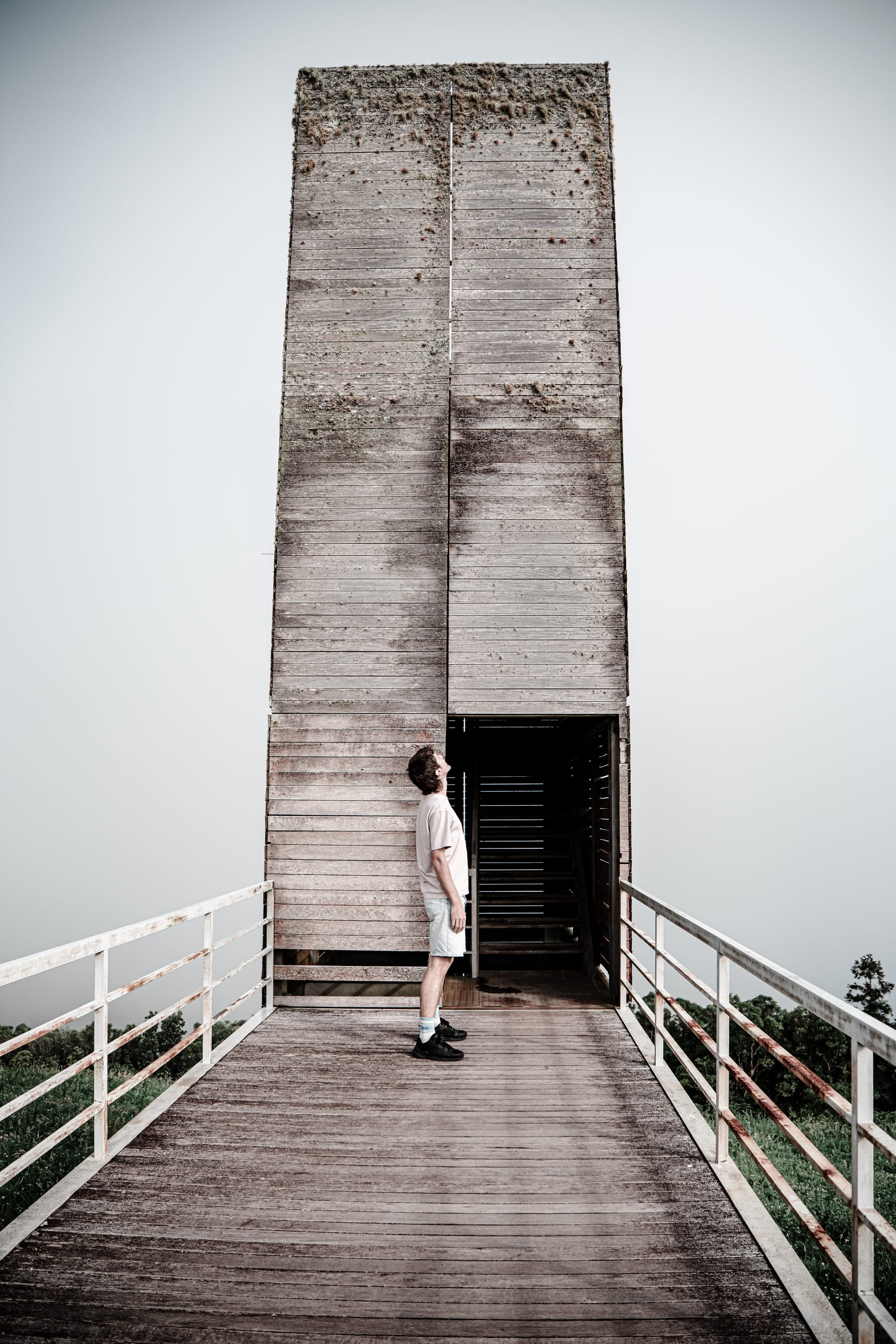
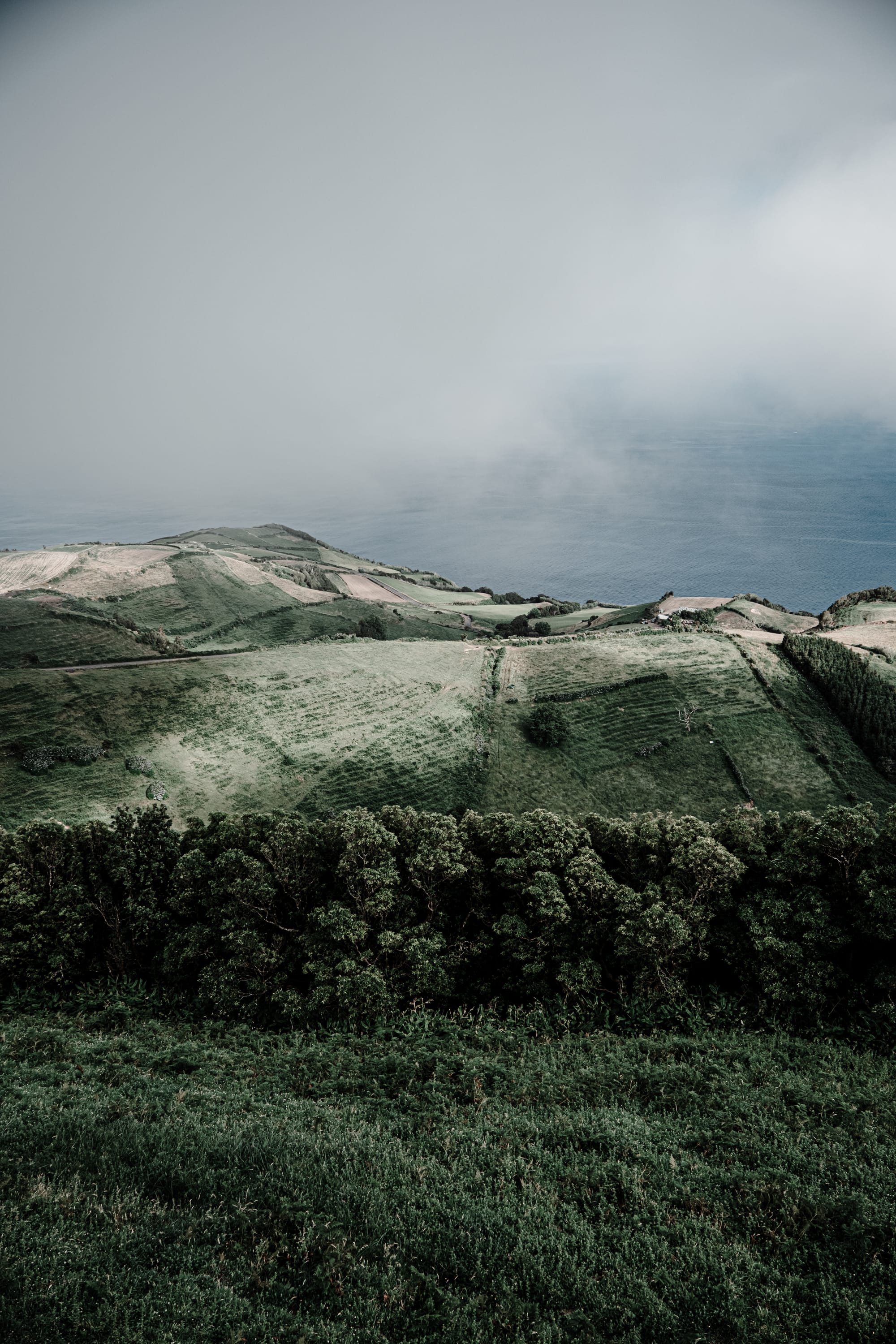
A fog-veiled lookout tower and a patchwork of fields dissolving into the Atlantic below
This is one of the most striking and sculptural viewpoints on the island. Miradouro do Pico dos Bodes sits on the eastern side of São Miguel, just above the green-carved hills. What sets it apart isn’t only the view—though the sweeping landscape of folded pasture and volcanic ridge is reason enough to stop—it’s the architecture. The miradouro is structured around a tall, narrow tower built from raw concrete, its verticality slicing the sky. You reach it via a wooden walkway bordered by tall grasses and wild clover, and the tower itself offers a subtle, almost reverent sense of perspective: one view out toward the sea, another over the staggered patchwork of agricultural land inland.
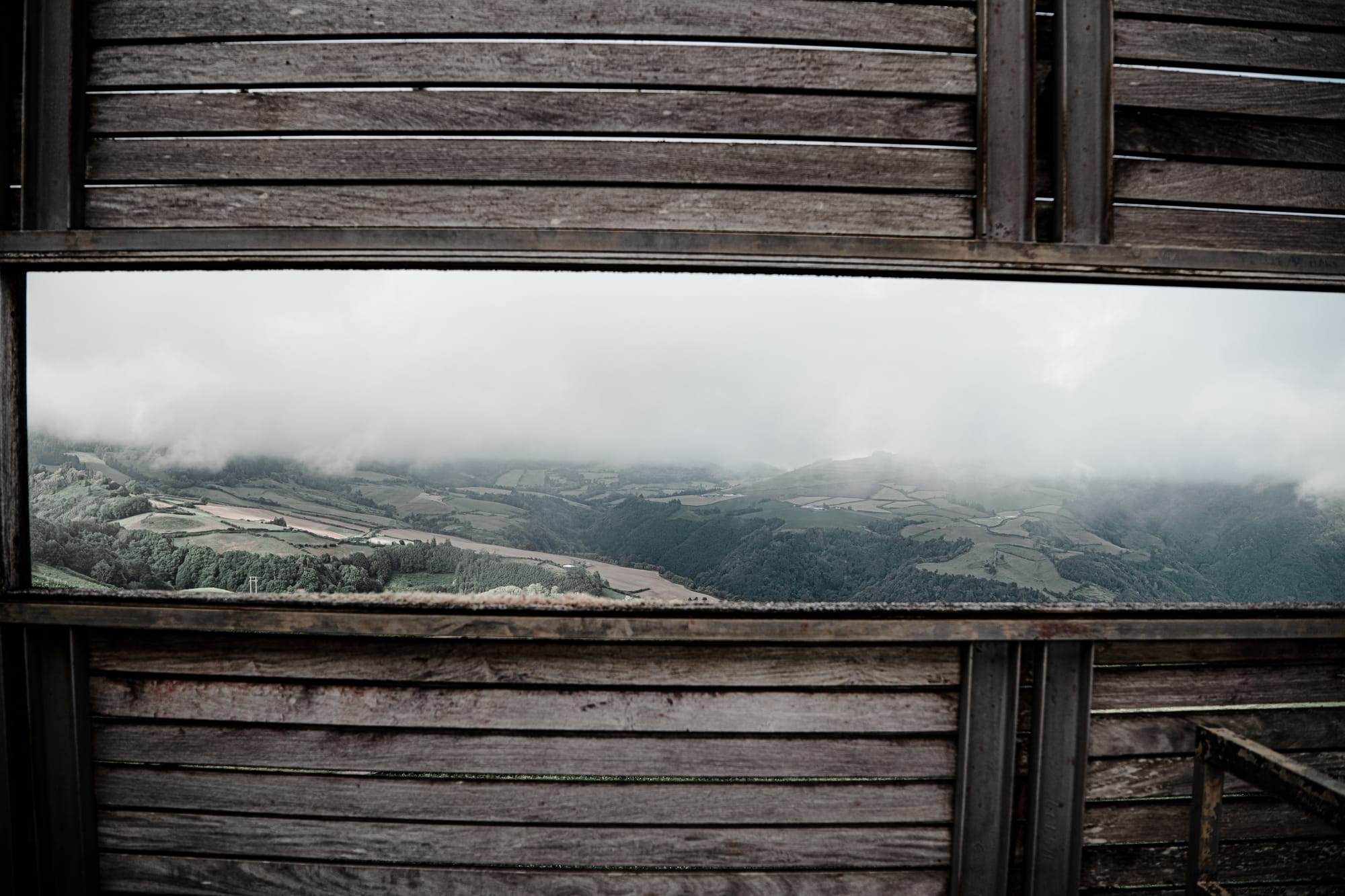
On the day we visited, the whole structure was shrouded in fog. That kind of cinematic mist São Miguel is known for—rolling across the hills, lifting slightly at the coast, catching the light at the corners. We stood inside the frame of the tower, looking through a rectangular window cut into the concrete, and everything in view felt quiet and scaled down. There’s a sense of being suspended—between land and cloud, between design and erosion.
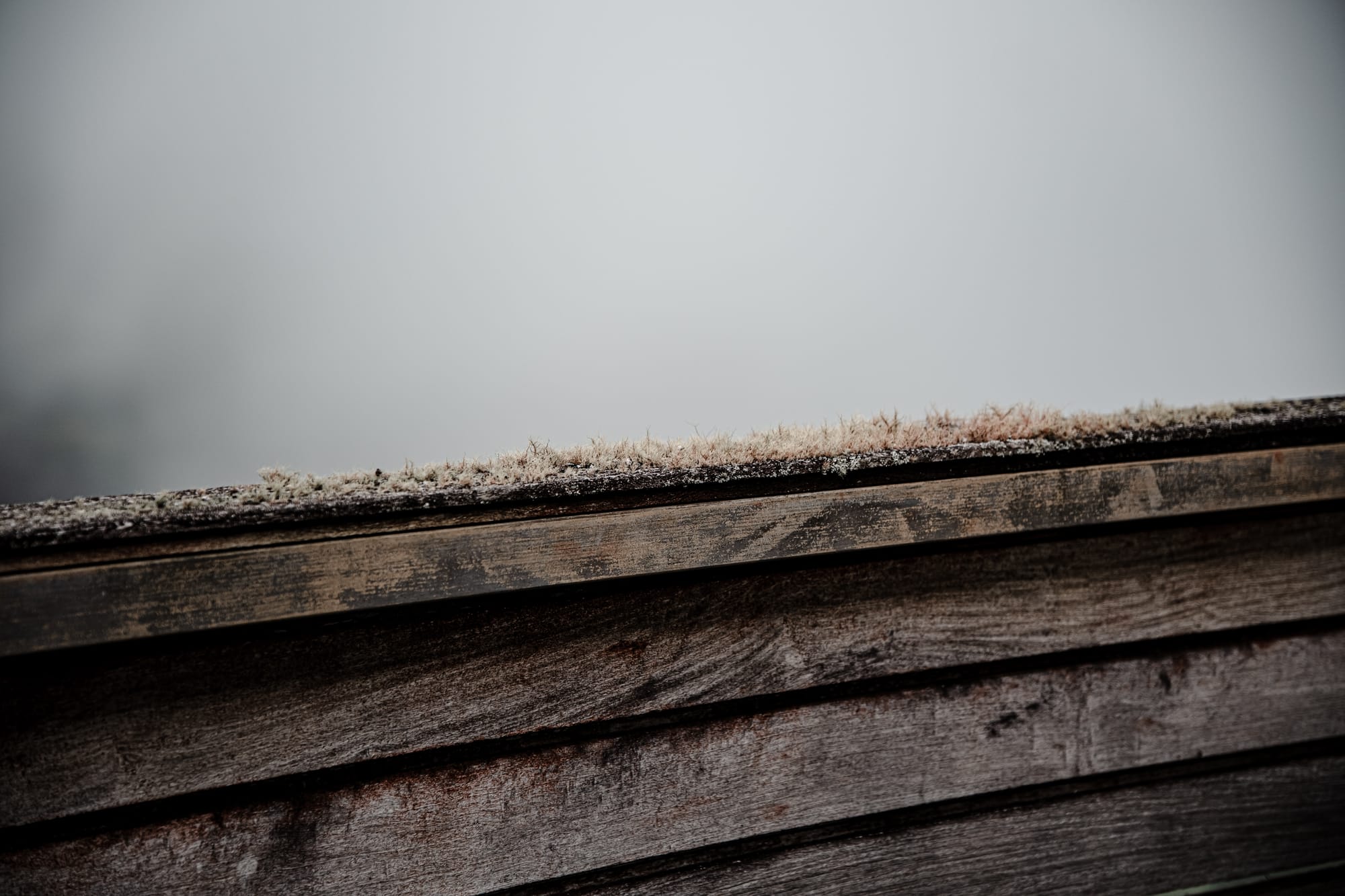
From this vantage point, the view rolls outward in green—layered pastures, forests, folds of ridge and valley, low stone walls cutting soft patterns into the terrain. The sea flickers in the distance, sometimes visible, sometimes veiled in mist. Below, fields pulse with seasonal crops and volcanic memory. Above, the clouds move fast.
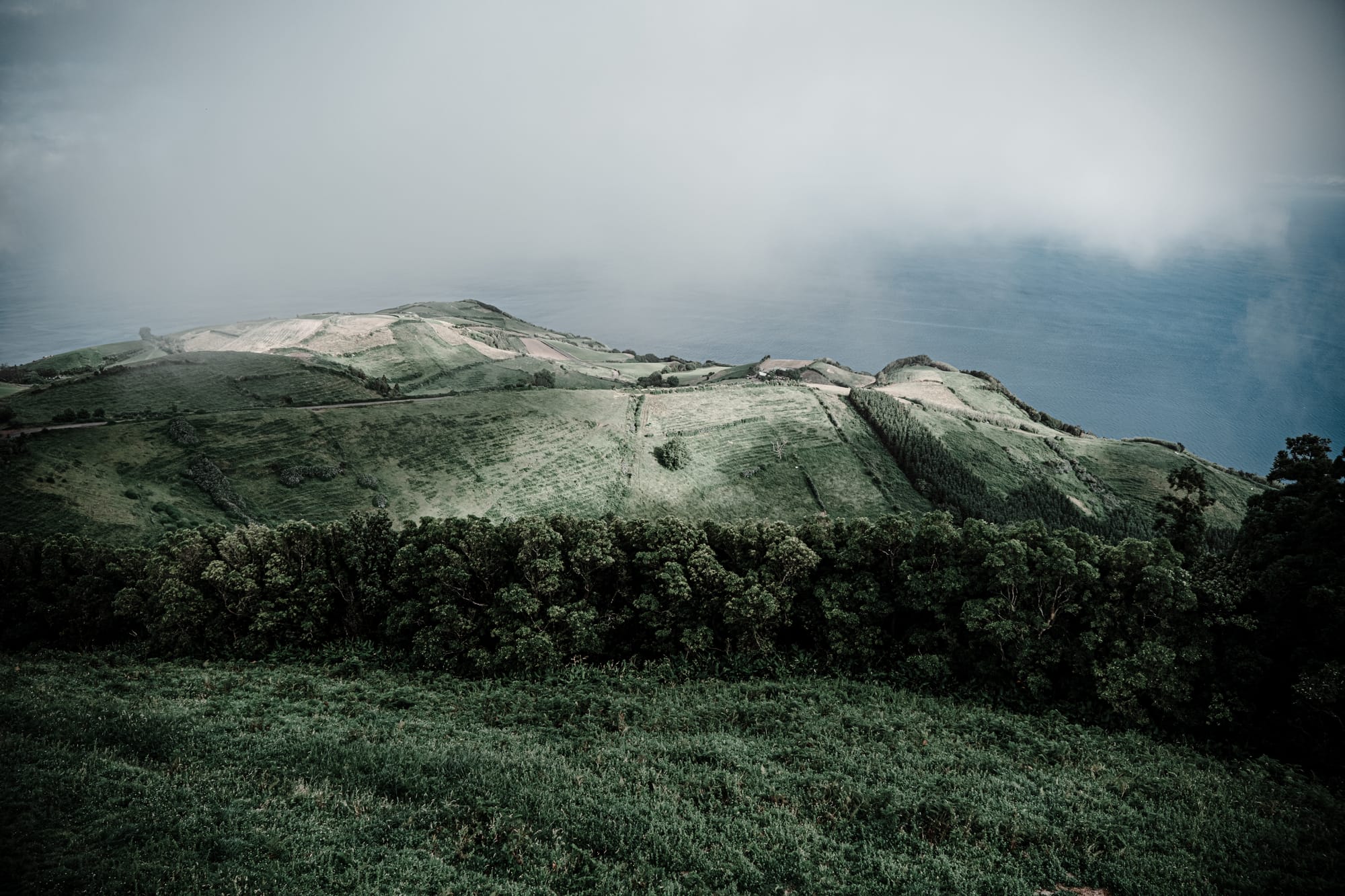
The surrounding area is covered in seasonal bloom. We noticed flecks of purple blooms, clumps of white clover, and thin reeds brushing against the low guardrails. Birds wheel overhead. The fields rise and fall in shallow swells. Even the soil feels layered—like it’s holding warmth from the volcanic seams below.
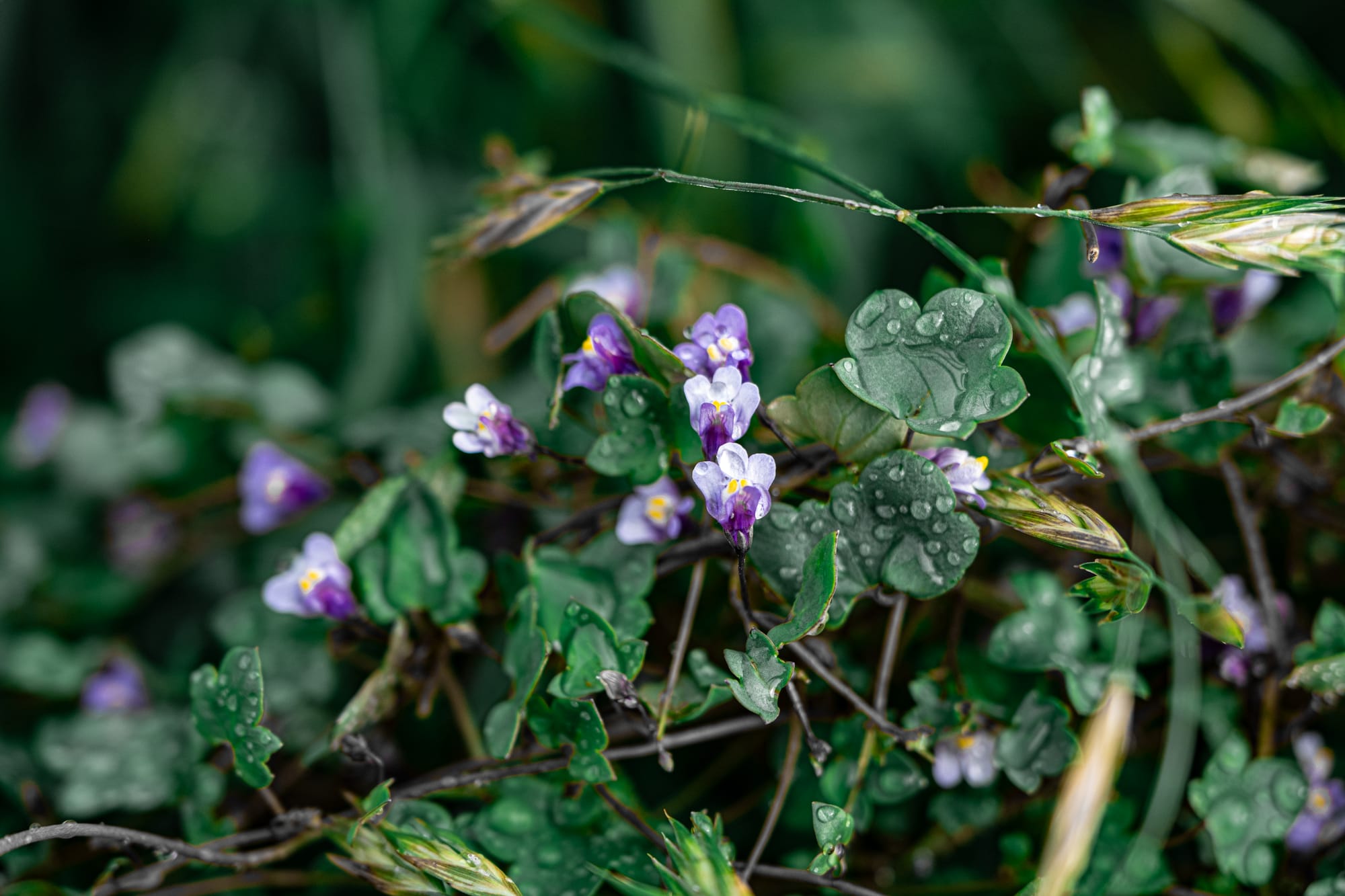
There’s little signage here, and no facilities—just a sense of intention, of structure shaped to frame. It’s a place to pause for longer than you think, and one that quietly recalibrates your sense of scale.
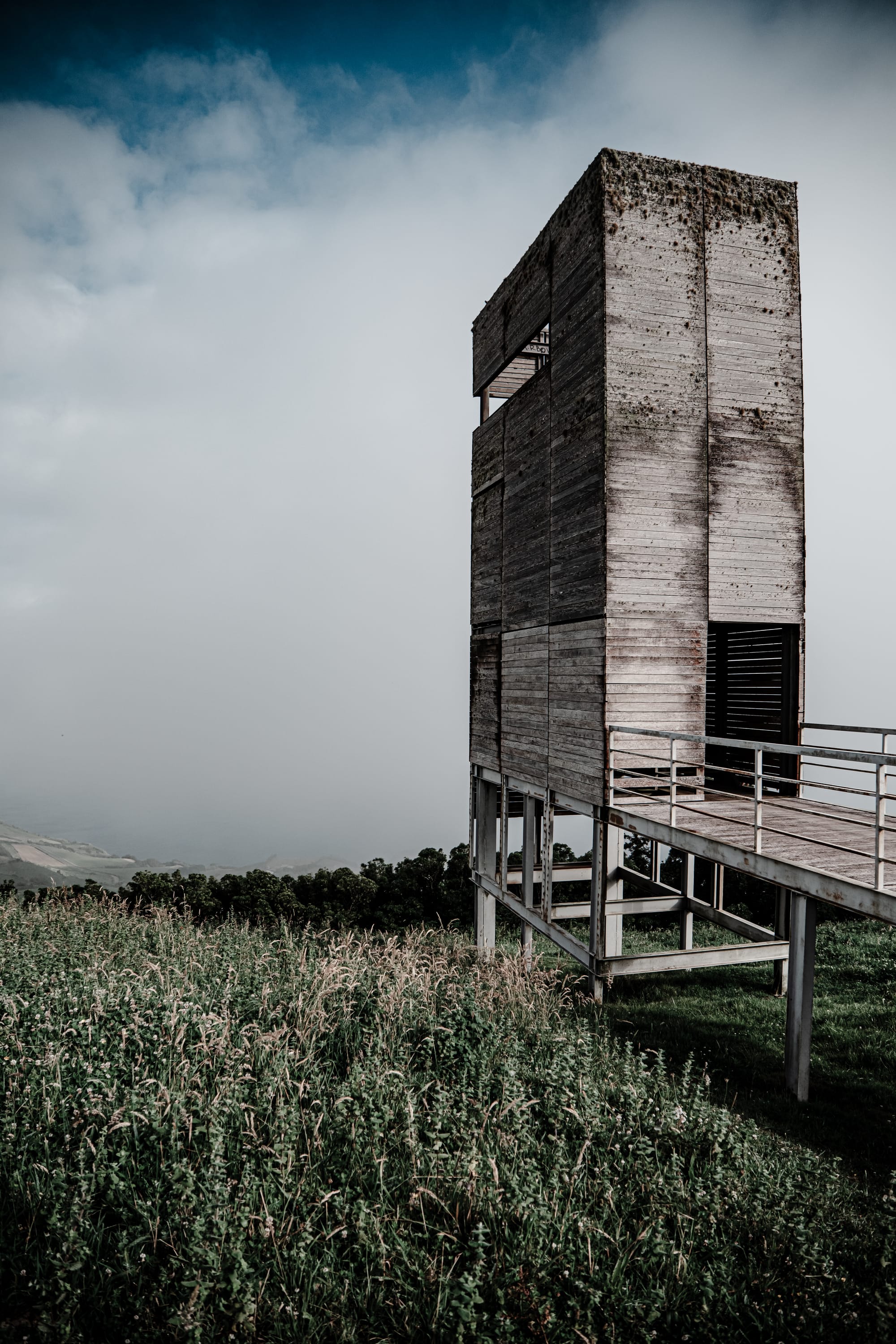
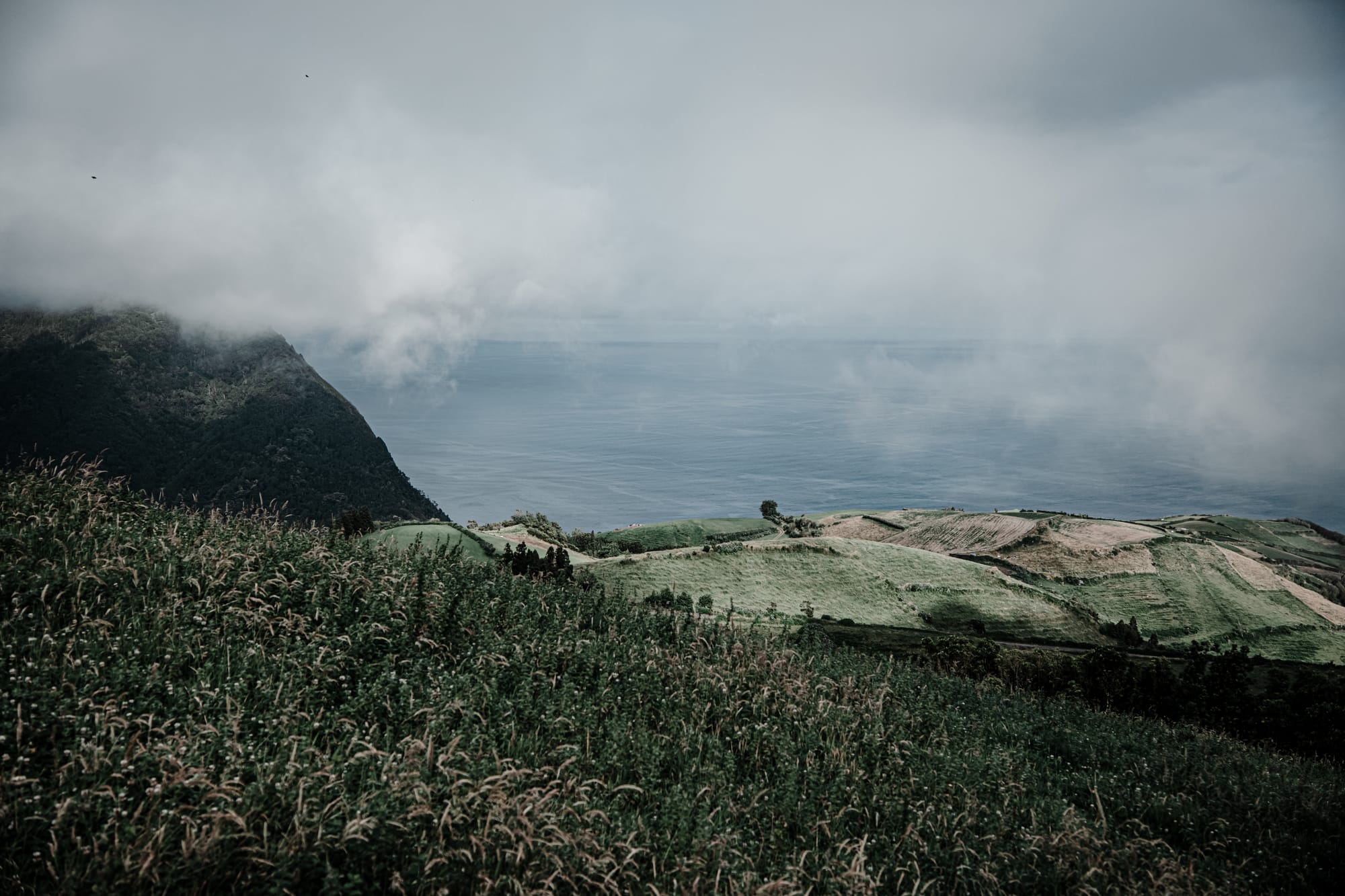
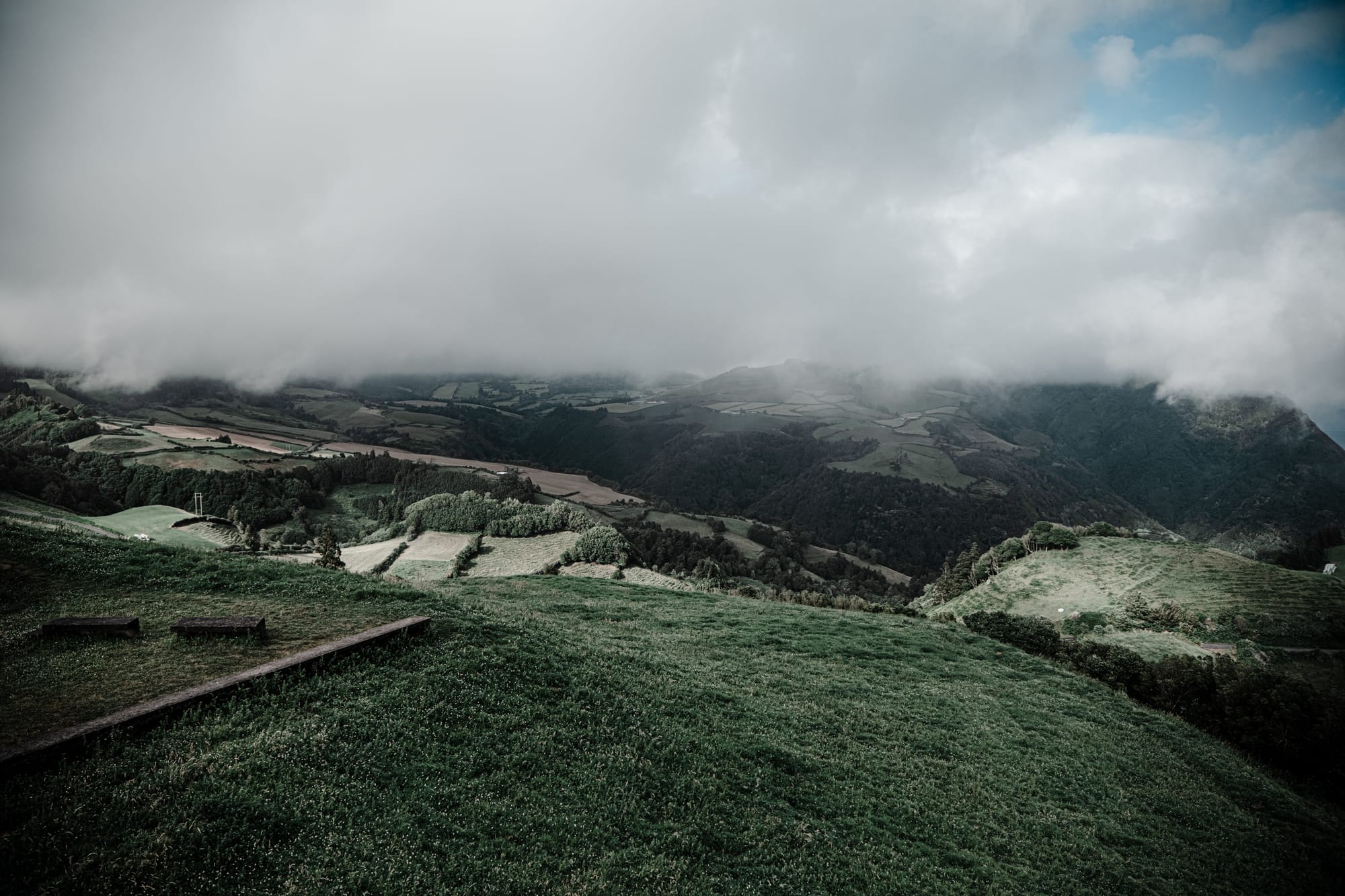
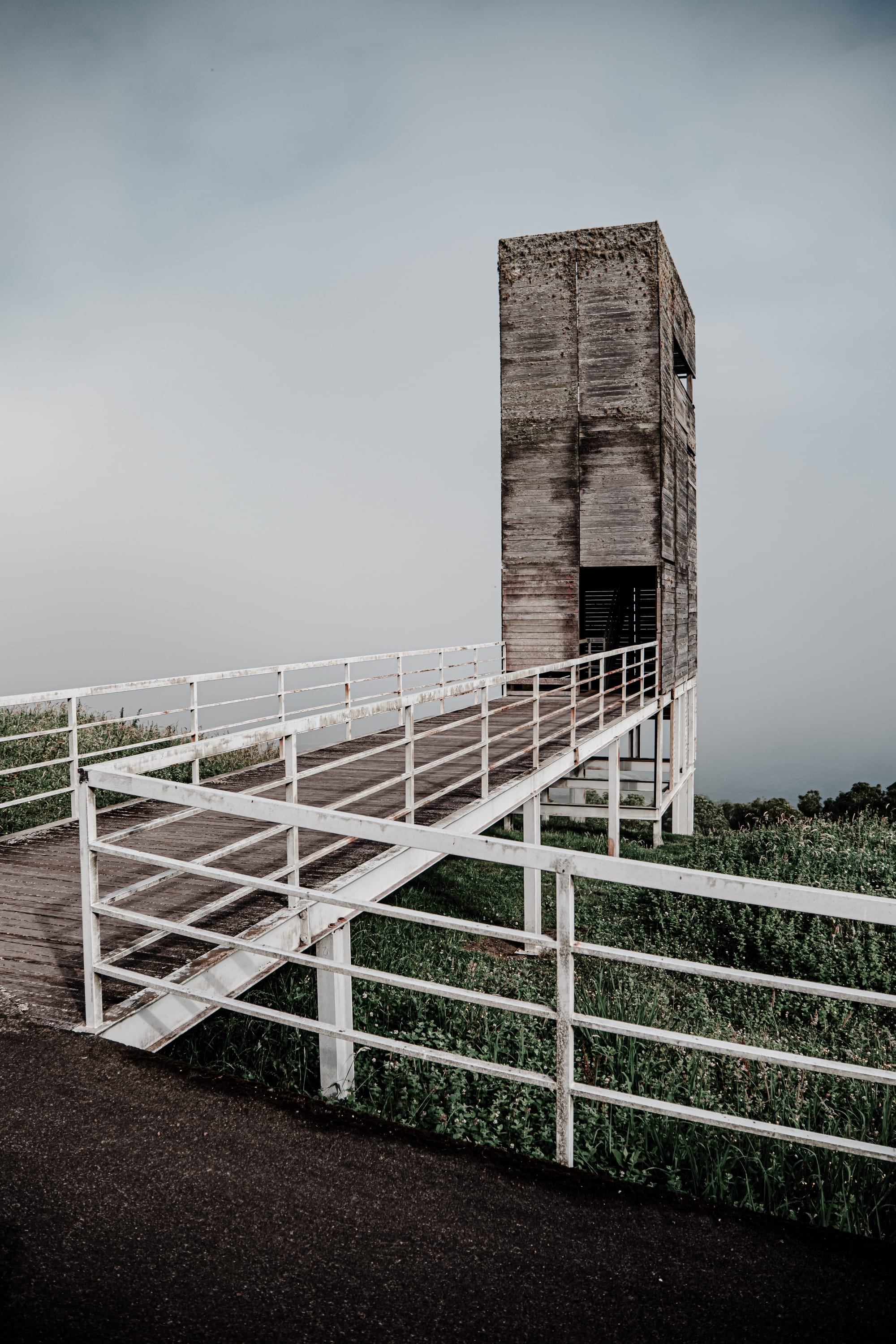
A shifting interplay of fog, pasture, grain, and sky at Miradouro do Pico dos Bodes
The structure’s symmetry feels both intentional and eroded, a frame for watching time pass.
Miradouro da Grota do Inferno
This is the one you’ve probably seen in photos before arriving—the long, sloped ridge flanked by wooden railings, dropping toward an impossibly shaped volcanic caldera. Miradouro da Grota do Inferno is one of São Miguel’s most iconic viewpoints, and for good reason. It lives up to its mythic name.
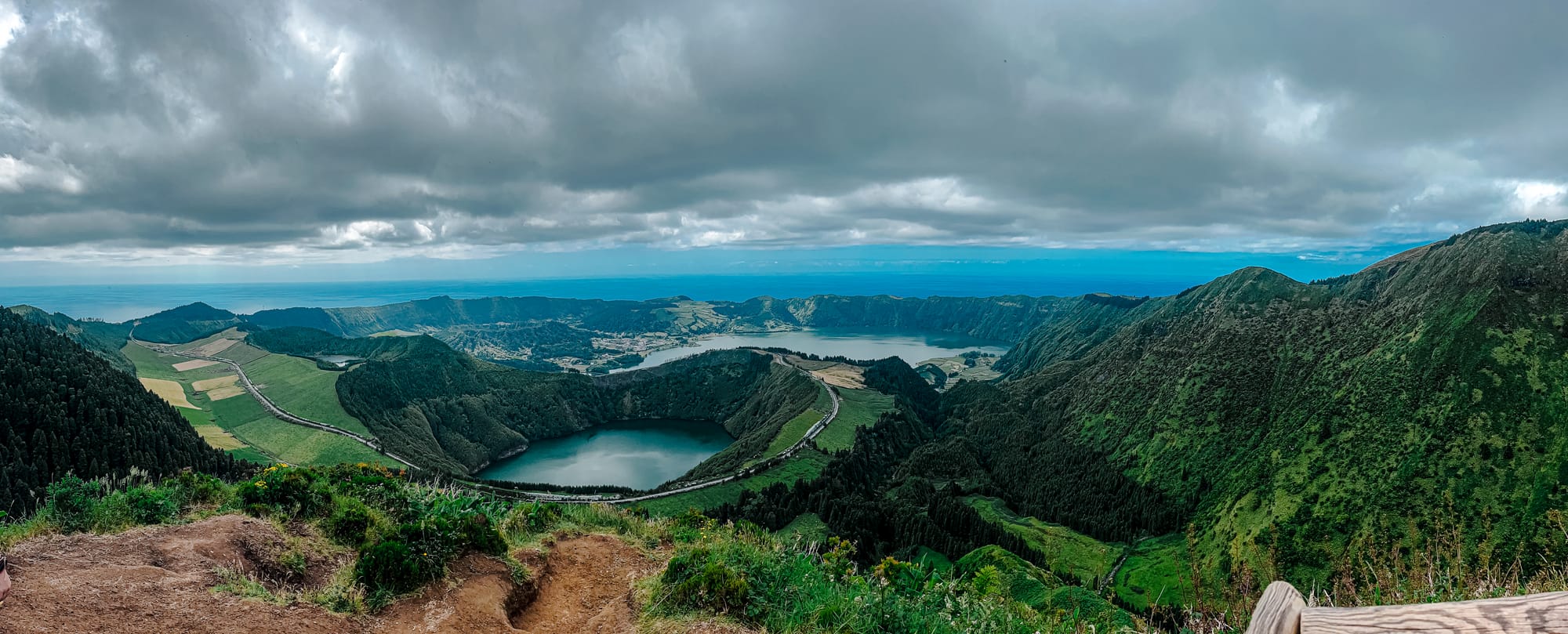
Reached by a short trail that branches off from the Lagoa do Canário parking lot, the miradouro juts out like a spine between two caldera walls. From the wooden platform, you get a near-360º view of the Sete Cidades volcanic complex: crater lakes in layered shades of green and blue, conic peaks, and ancient forest.
The view is sharp and cinematic, but the surrounding ecology is equally compelling. We passed mossy banks, pitcher plants, low-set hydrangeas, and red volcanic soil along the trail. At the top, the wind picks up—strong enough to tousle your hair and remind you just how exposed this point is.
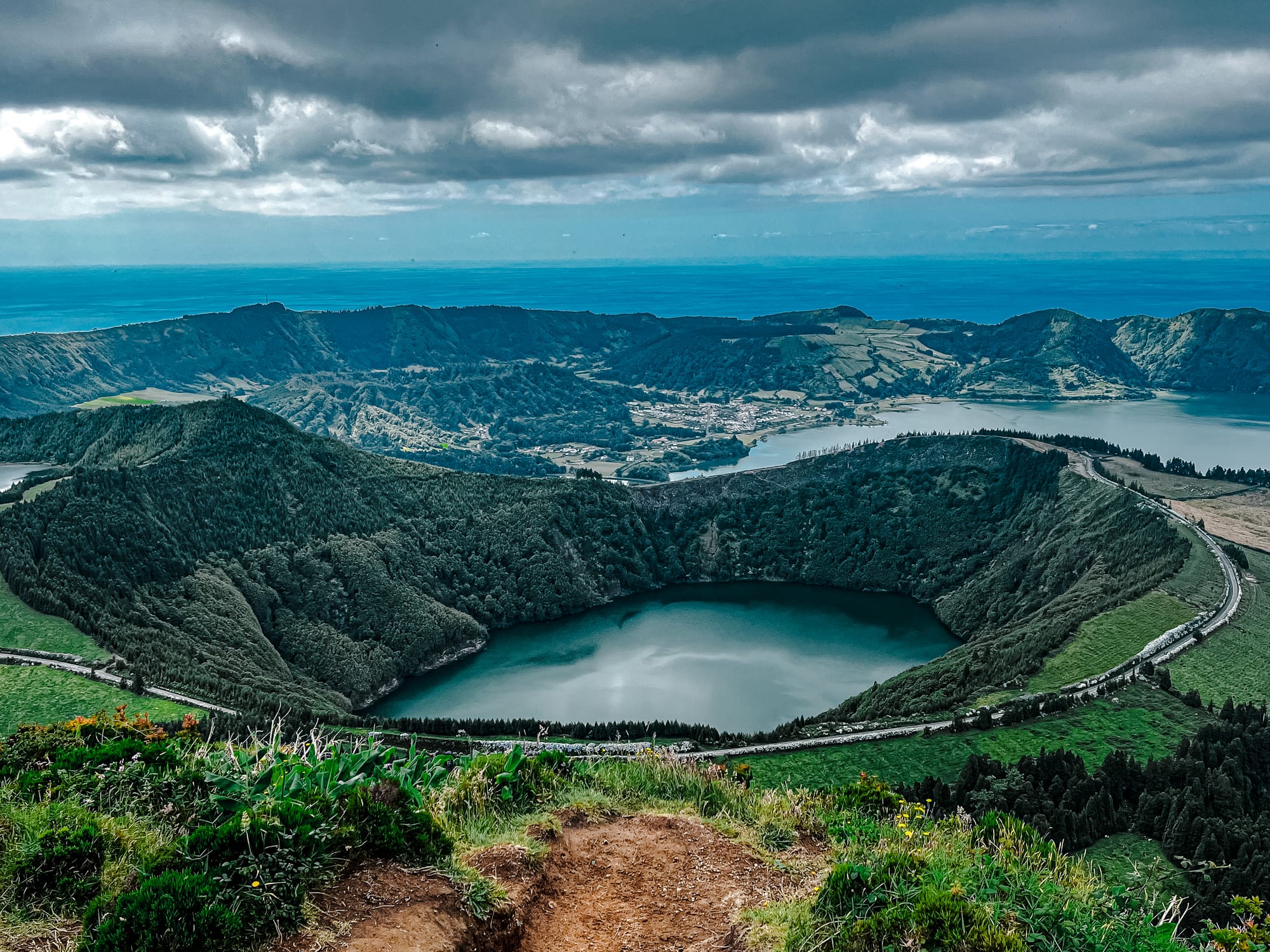
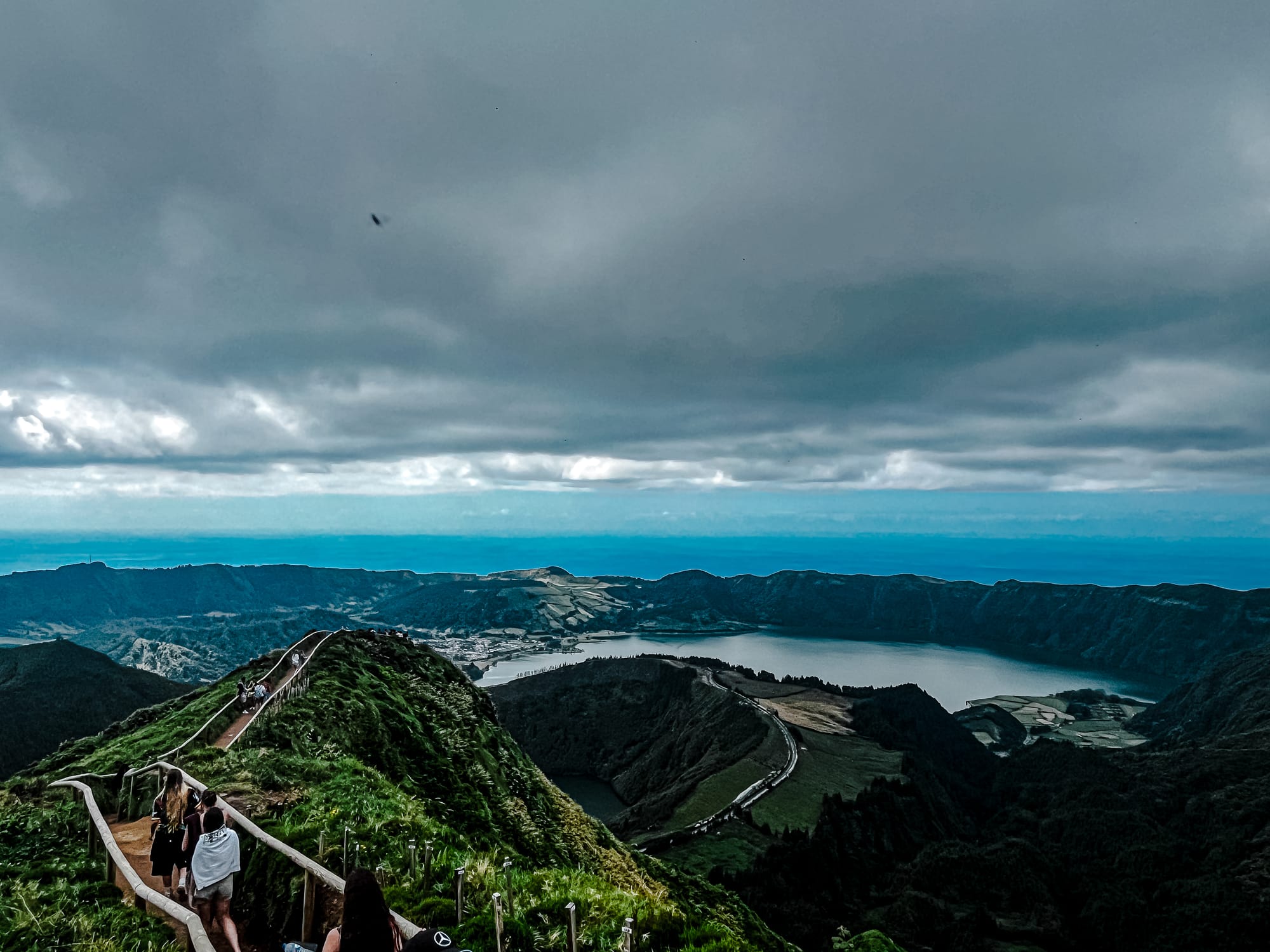
Overlapping lakes, volcanic ridgelines, and the winding path that connects them
Despite its popularity, it’s not difficult to find a moment alone here, especially in early morning or late afternoon. The footpath itself is part of the appeal, leading you deeper into a landscape that’s both storybook and tectonic.
The trail to reach it takes you along a short but dramatic route, weaving through pine forests and highland meadows before opening out onto a path that feels suspended in air. The view, when the weather allows, is almost too much to take in at once: rolling farmland, crater walls, and beyond them, the Atlantic.
Even in fog, this place has presence. The hydrangeas bloom thick along the trail’s edge. The wind picks up at the exposed ridge. And standing at the final lookout, the ground seems to drop away beneath your feet. It’s not a high-effort hike, but the reveal is maximal.
Come early for the clearest skies, or late when the crowds thin and the light turns blue. There’s no bad moment here—just changing textures of cloud, color, and scale. A miradouro that earns its fame without needing to try.
Miradouro da Ponta do Sossego
Set on the northeast coast of São Miguel, Miradouro da Ponta do Sossego is not just a viewpoint—it’s a full garden suspended above the sea. The approach feels ceremonial: a long, red earth pathway lined with trimmed hedges and towering conifers, leading you gently toward the edge. But the further you walk, the more the landscape opens—first to flowerbeds, then to terraced lawns, then to cliffs and Atlantic horizon.
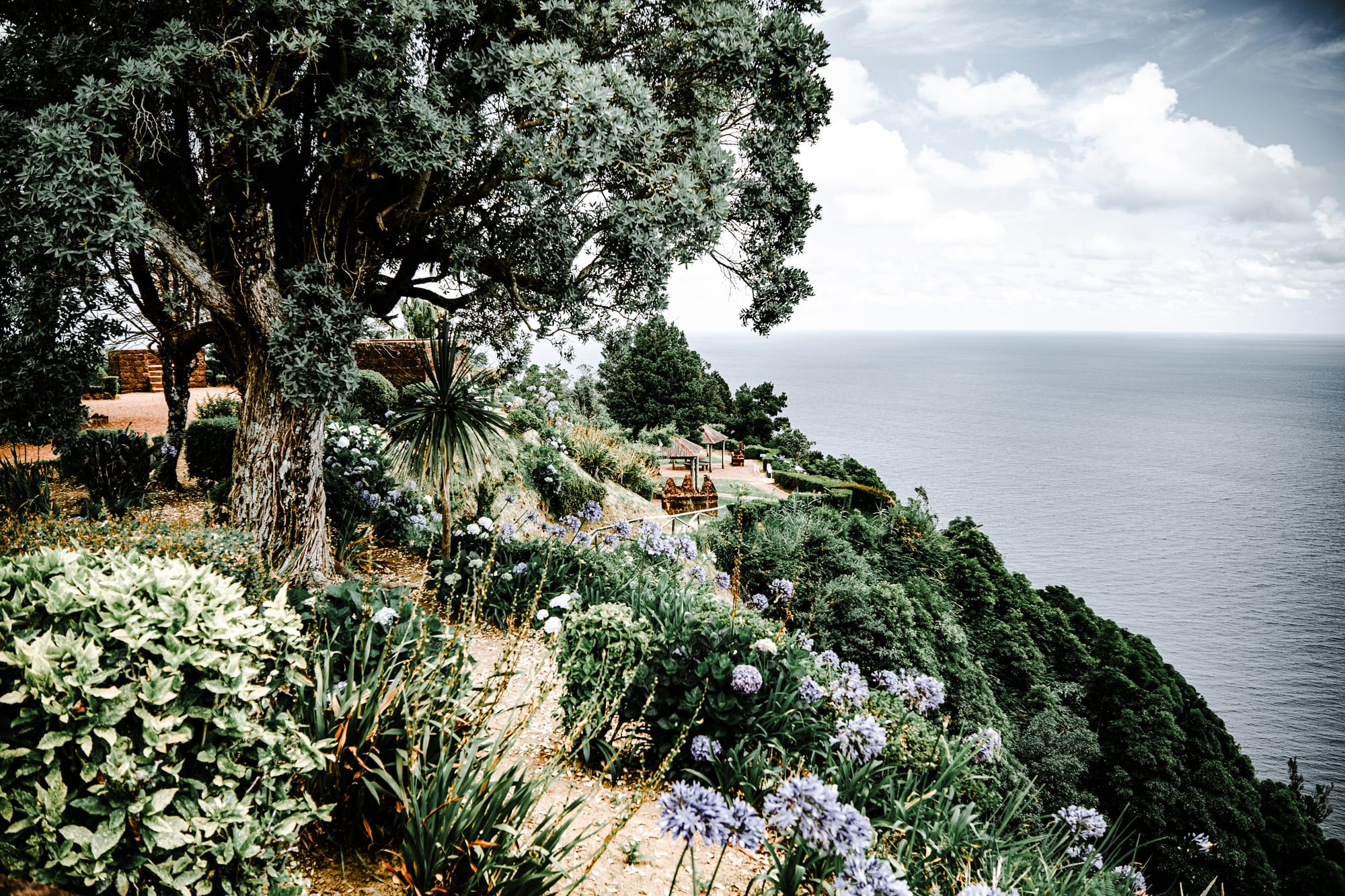
What makes this place remarkable is its layering. Winding stone paths thread through blooming azaleas, lilies, and African daisies. Ferns brush your calves.
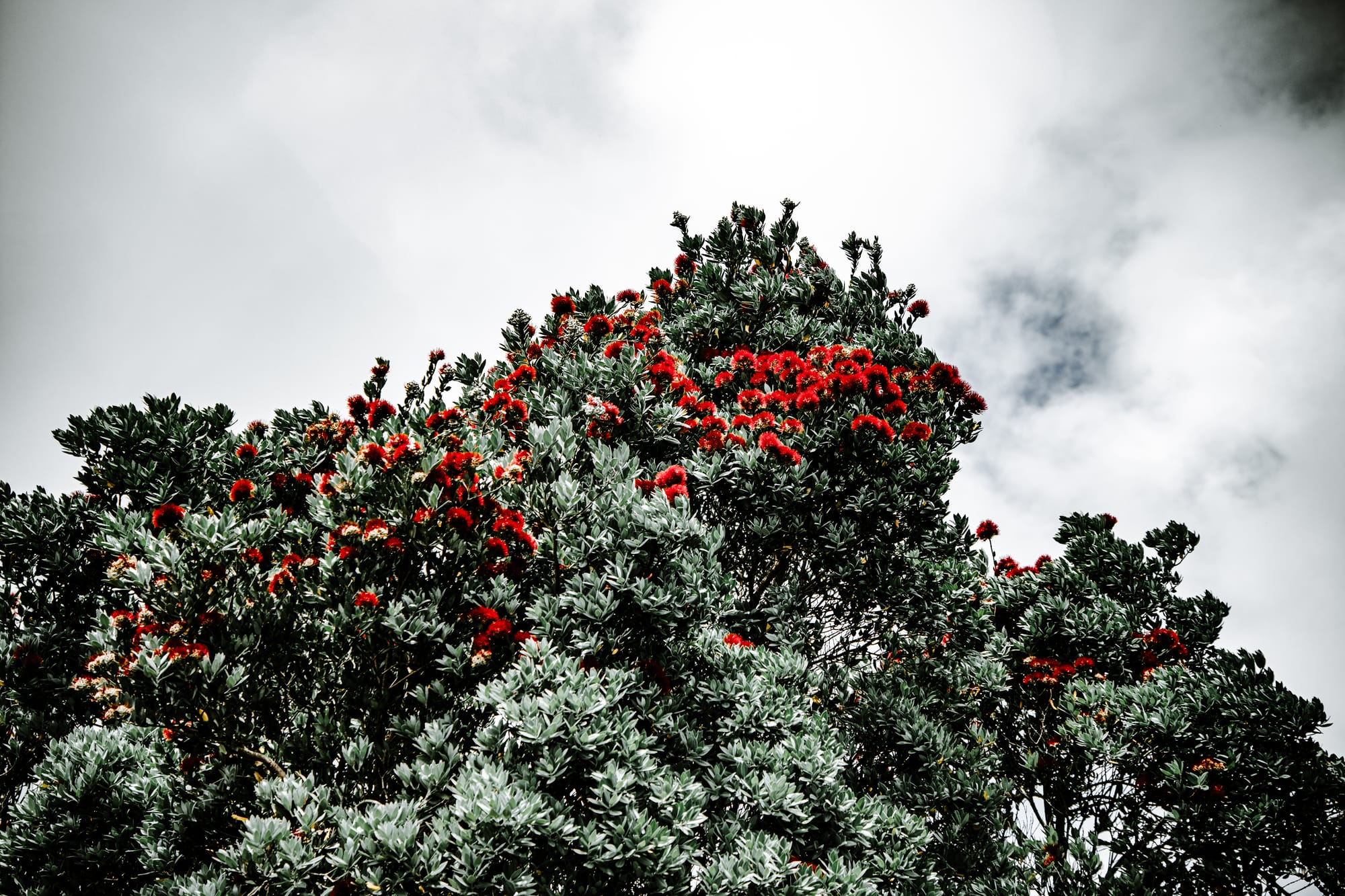
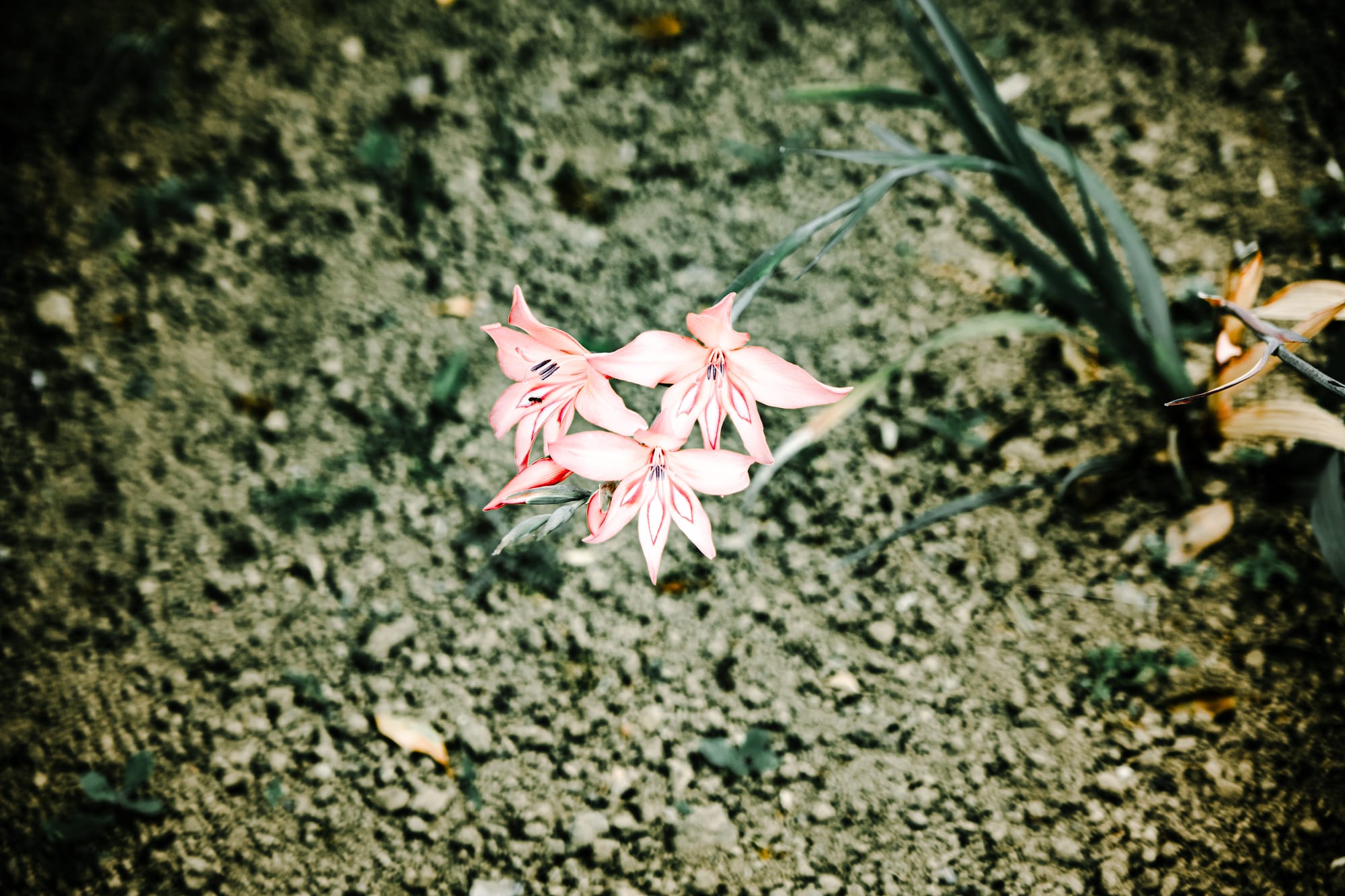
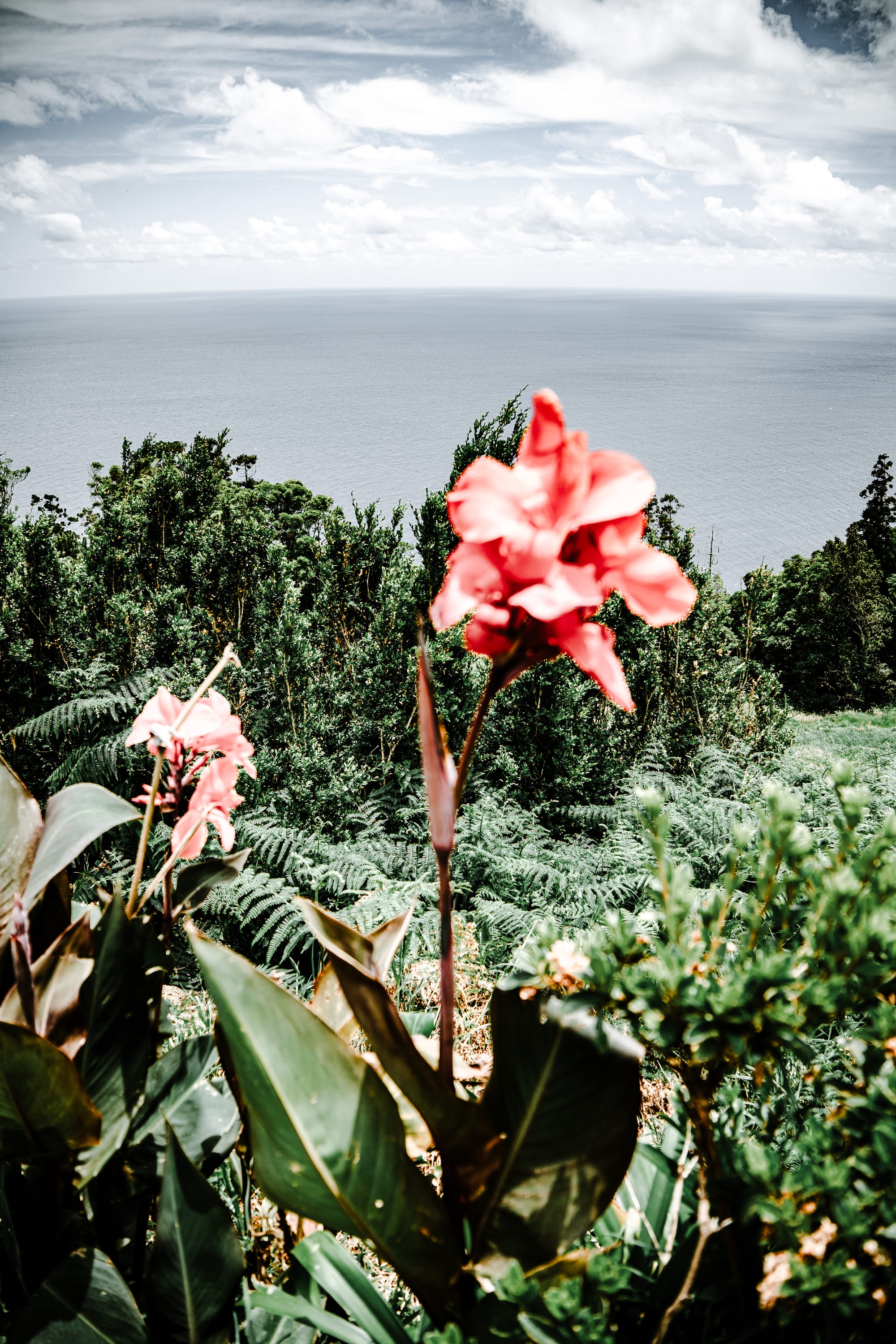
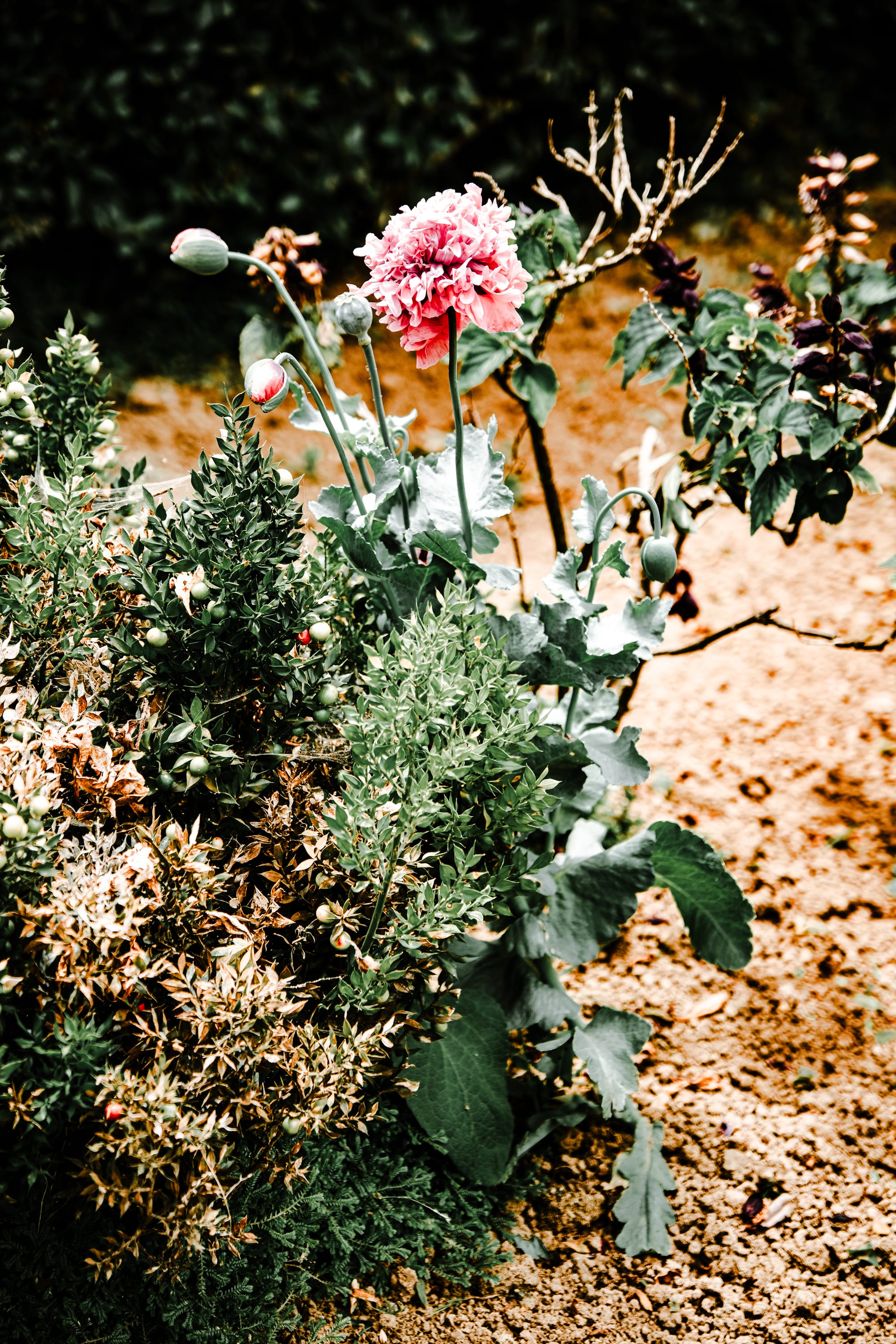
Bright florals scattered along the edge of Ponta do Sossego, from pōhutukawa to poppy-like blooms
Trees twist upward, creating shaded alcoves where you’ll find picnic tables, wooden benches, and the occasional tiled fountain or barbecue pit.
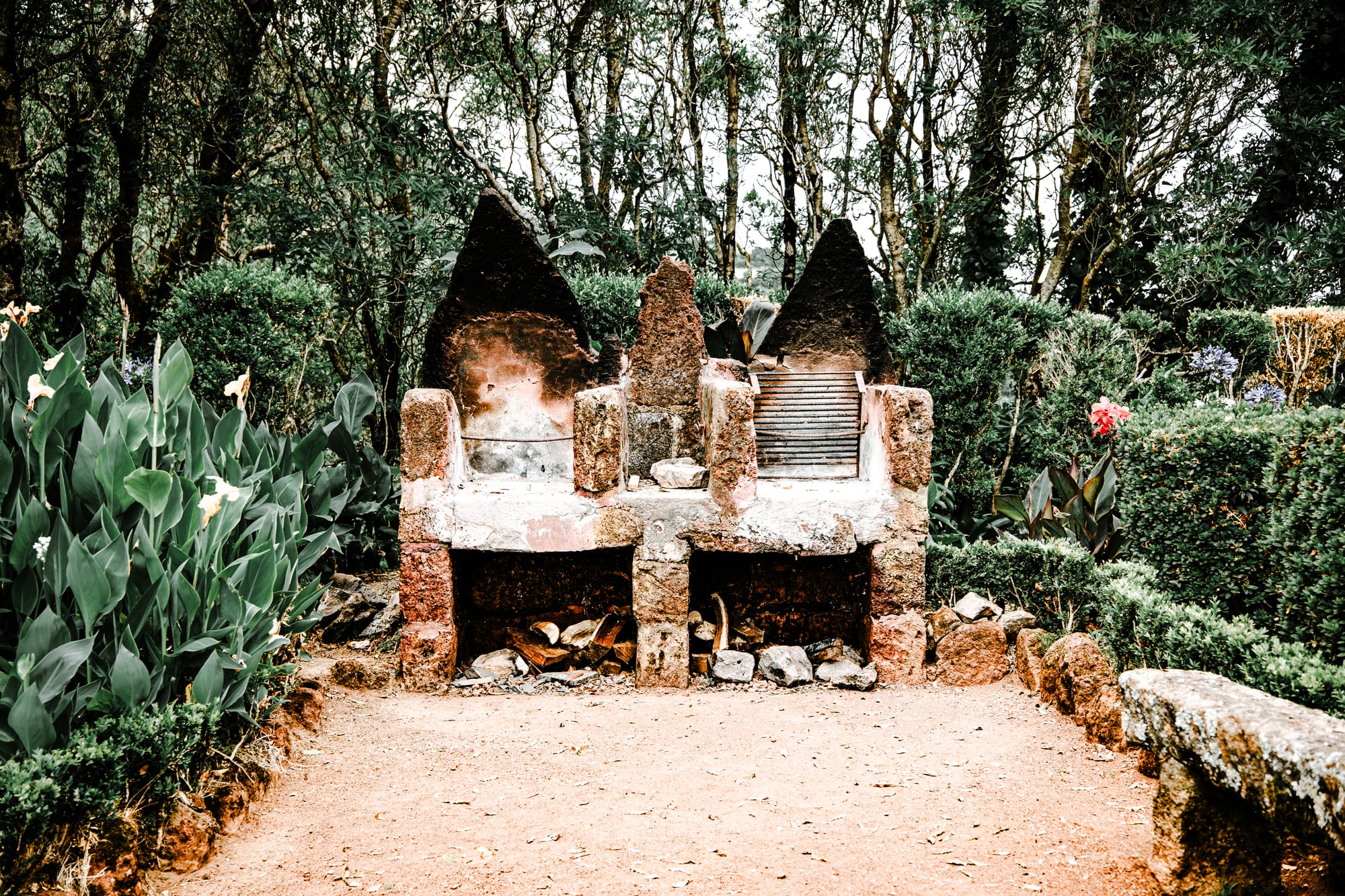
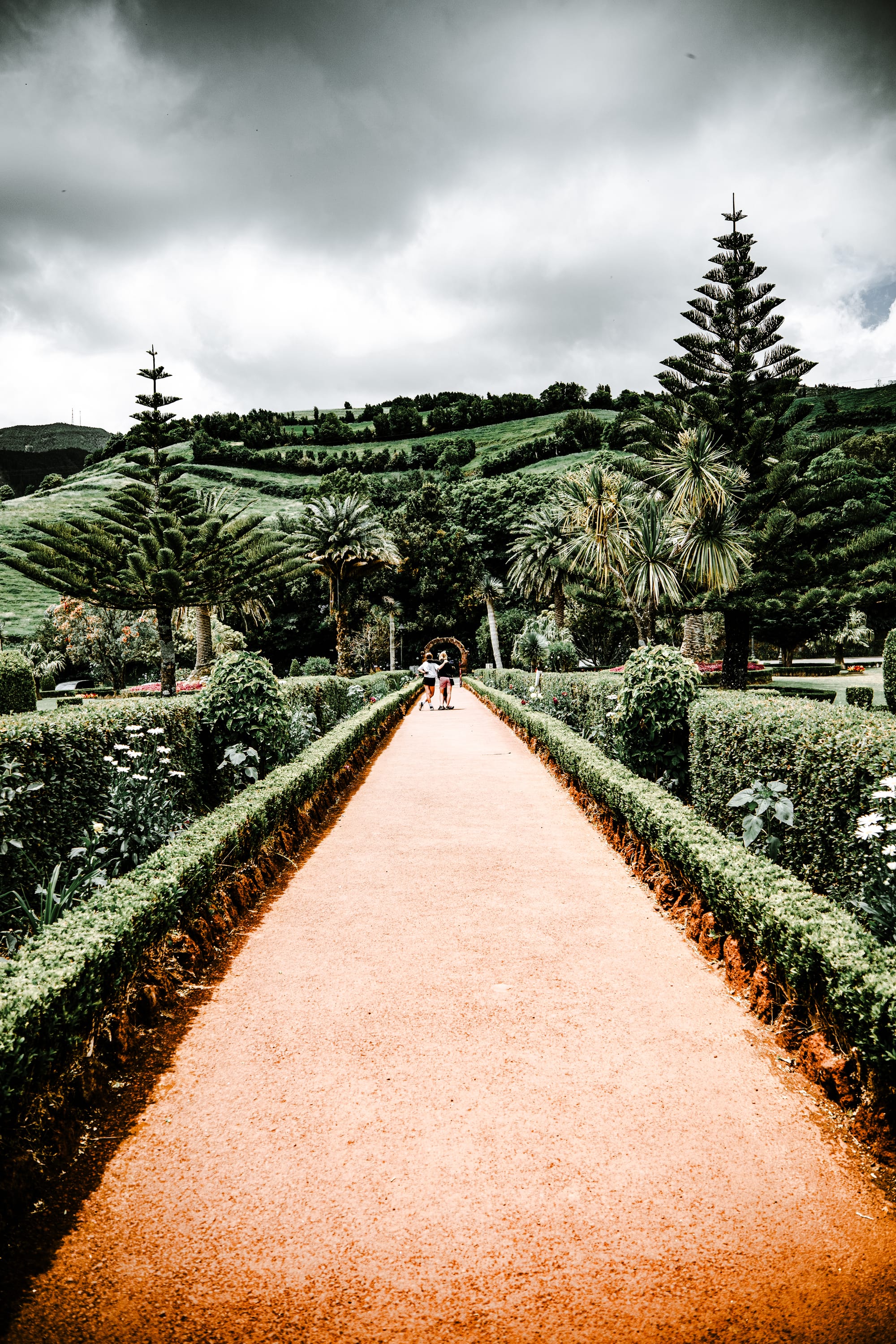
Stone grills and manicured paths frame the gardened overlook of Miradouro da Ponta do Sossego
At the outermost edge, the view arrives all at once: vast, oceanic, fringed by cliffs and capped by sky. On a clear day, you can see a nearby village on one side, and on the other, the wild slope of the coast stretching into green.
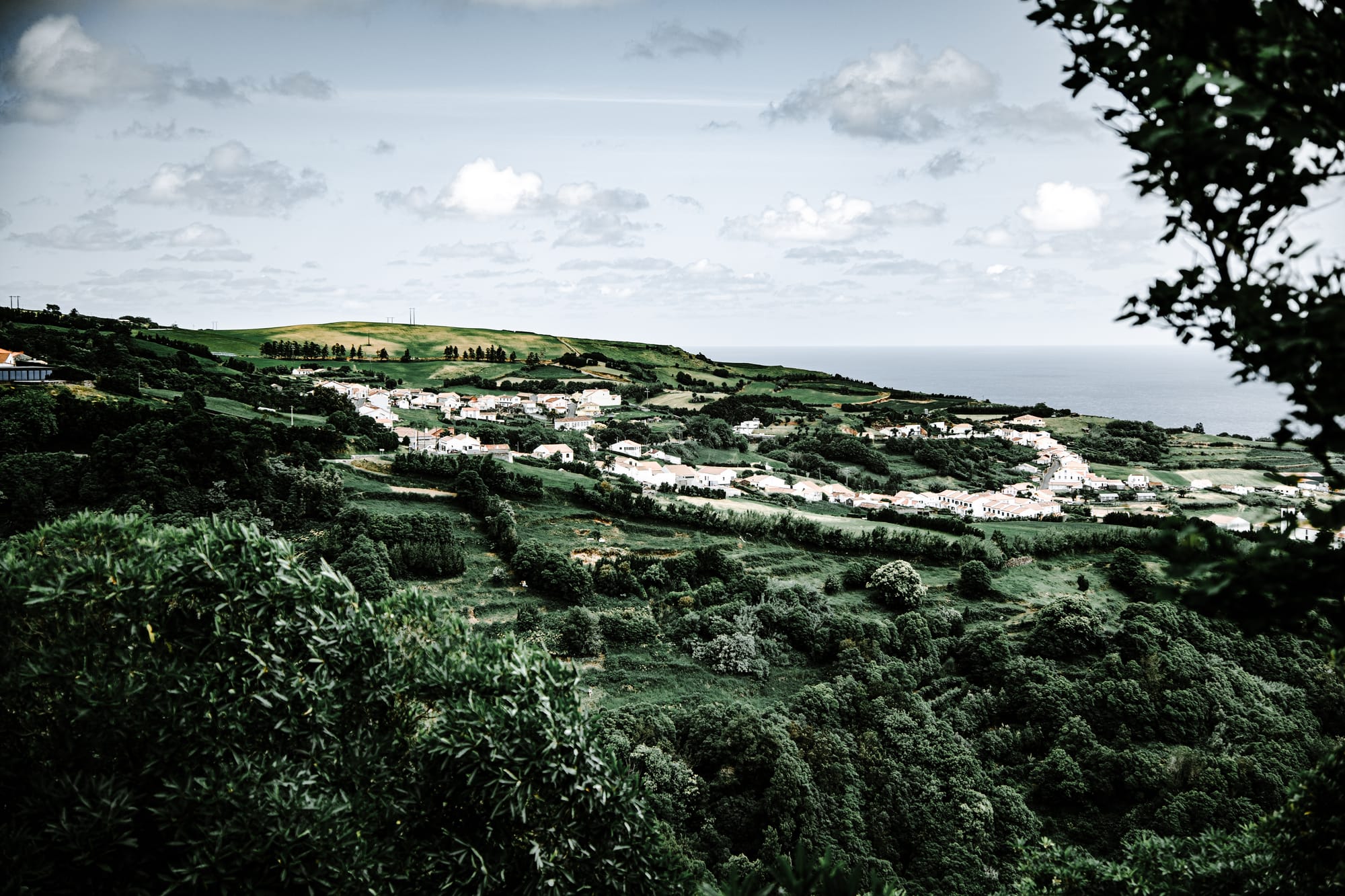
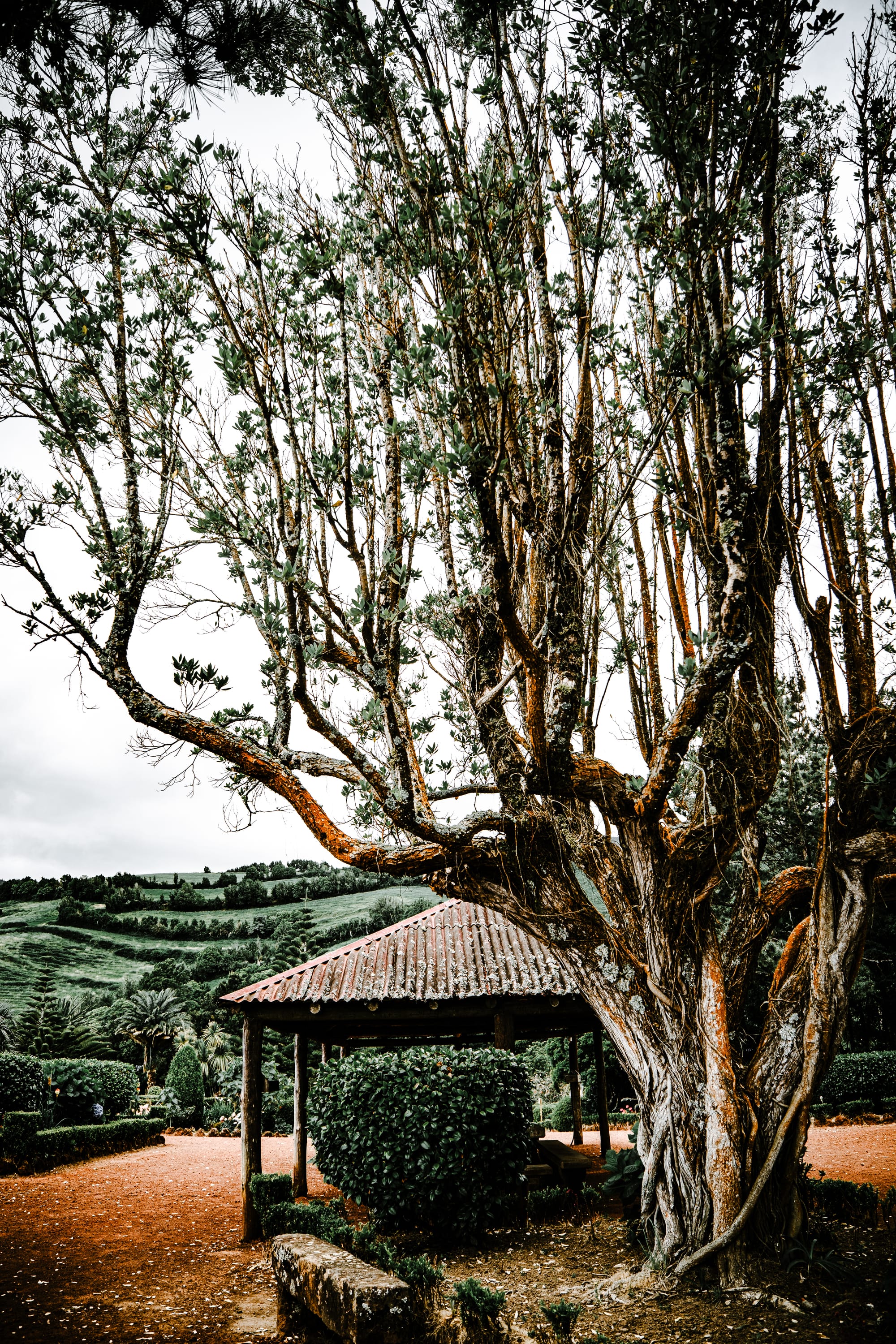
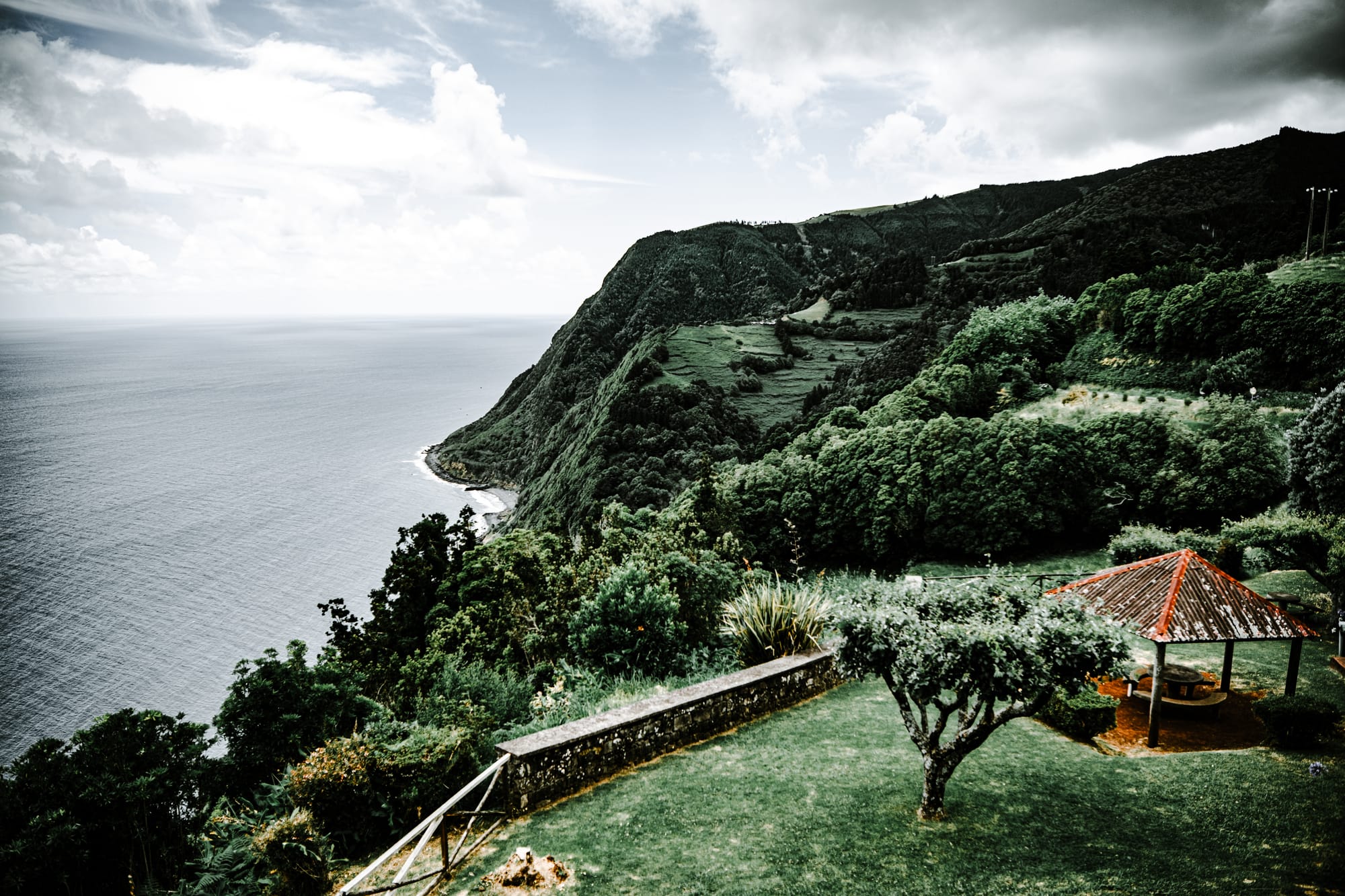
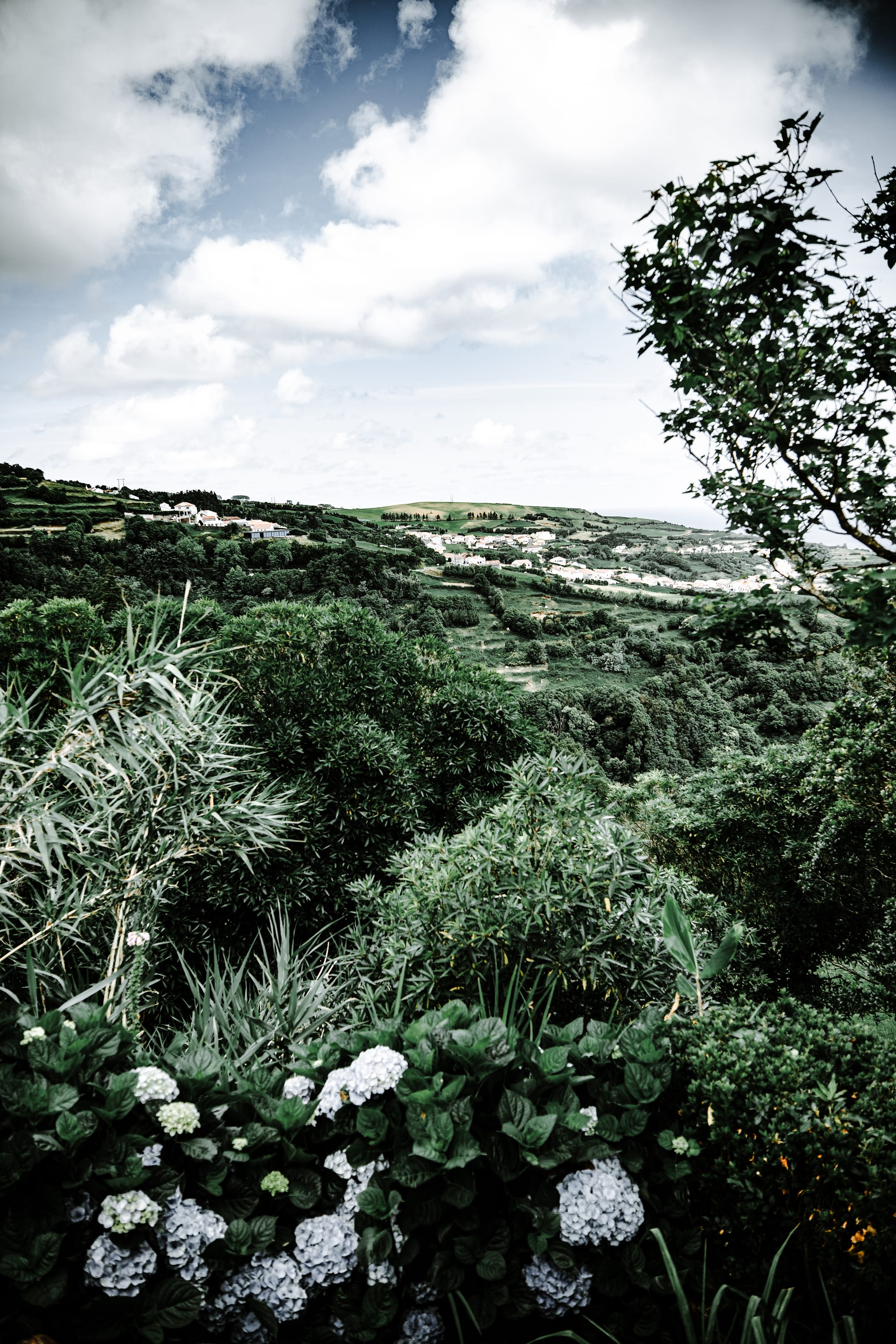
Tiered gazebos, ancient trees, and coastal cliffs converge in this lush eastern lookout
At the outermost edge, the view arrives all at once: vast, oceanic, fringed by cliffs and capped by sky. On a clear day, you can see a nearby village on one side, and on the other, the wild slope of the coast stretching into green.
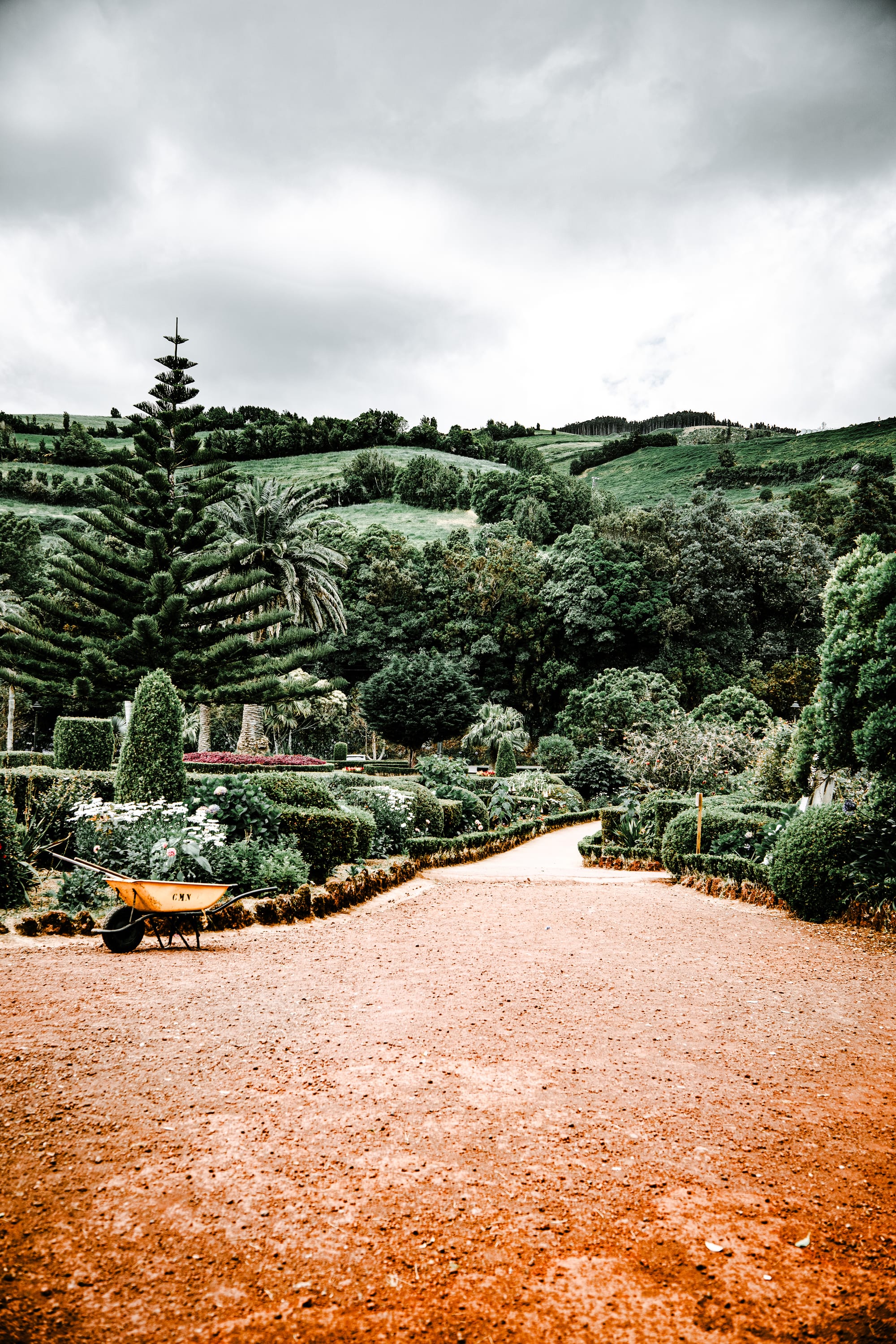
The scent here is complex—salt, eucalyptus, marigold, wet moss. It’s a place of rest, but also of care. Someone trims these gardens. Someone rakes the paths. Someone tends the blooms.
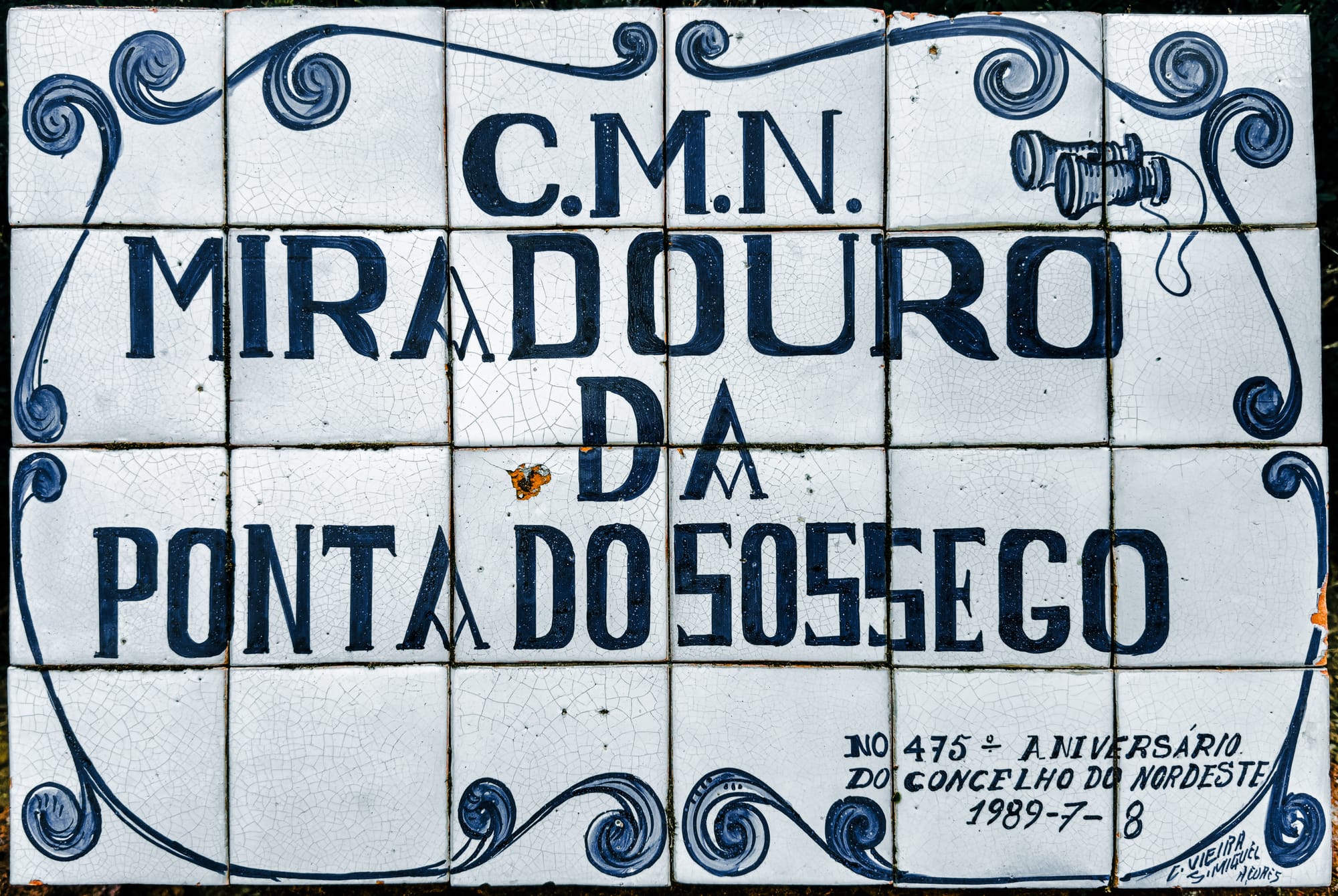
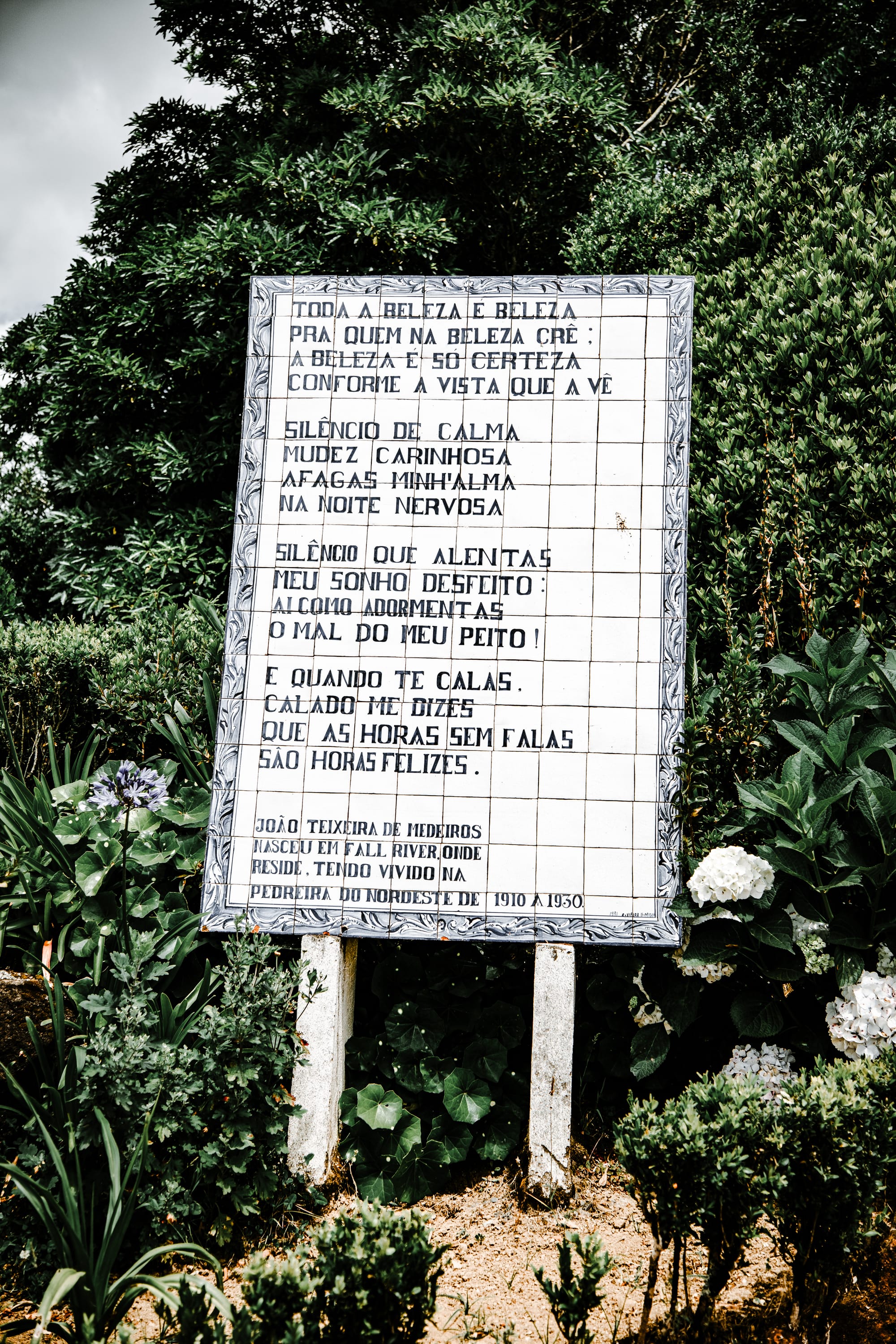
Poetic tiles and hand-lettered signage welcome visitors to Miradouro da Ponta do Sossego
You could come here just to look. But you’ll stay longer than expected. Walking slowly, reading the signs, stopping to admire a single flower.
Miradouro do Cintrão
Tucked on the northern coastline of São Miguel, Miradouro do Cintrão is less frequented than some of its more photographed counterparts, but for those who time it right, it becomes something close to cinematic. We arrived just before sunset, with the light low and warm, spilling across the ocean like molten copper.
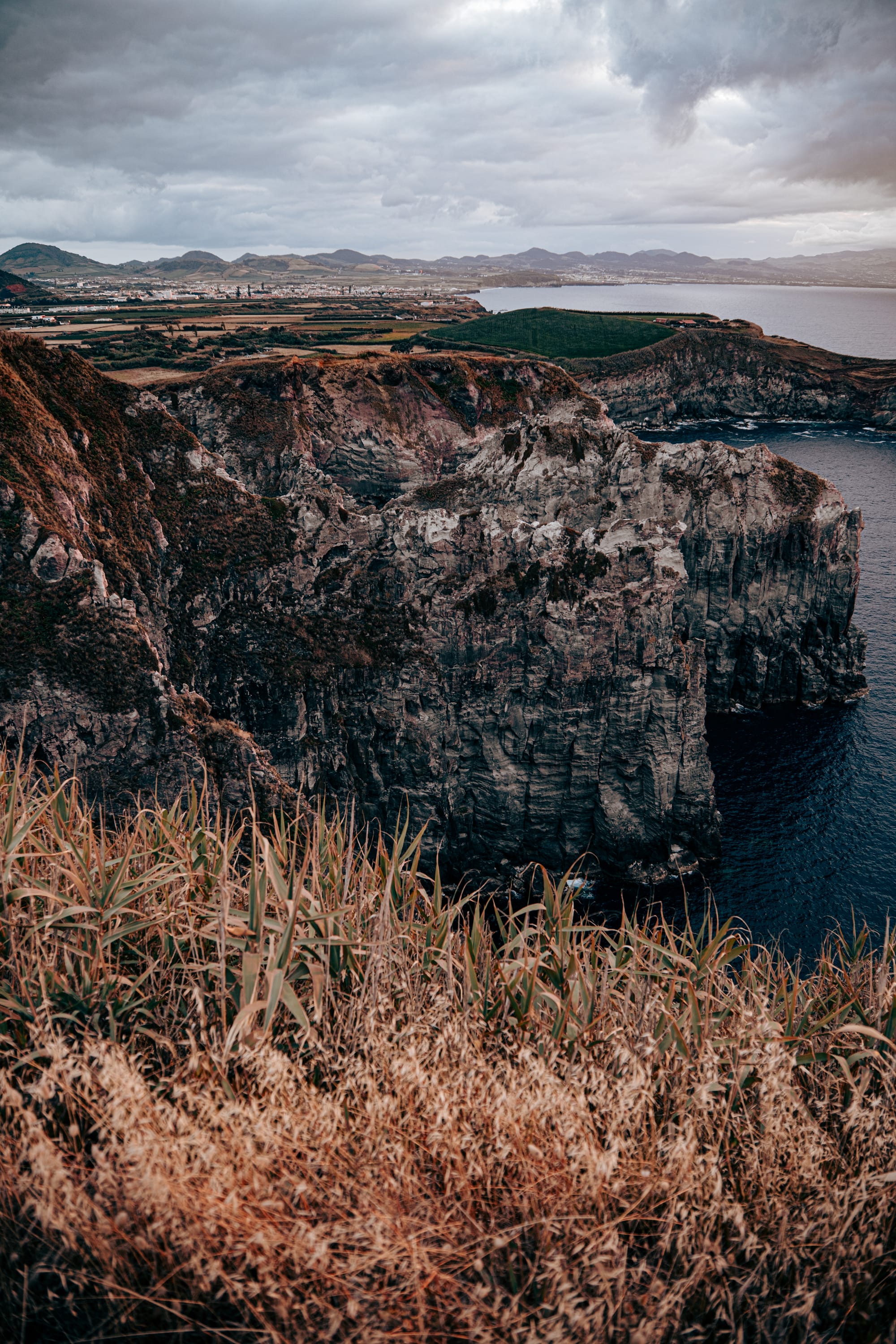
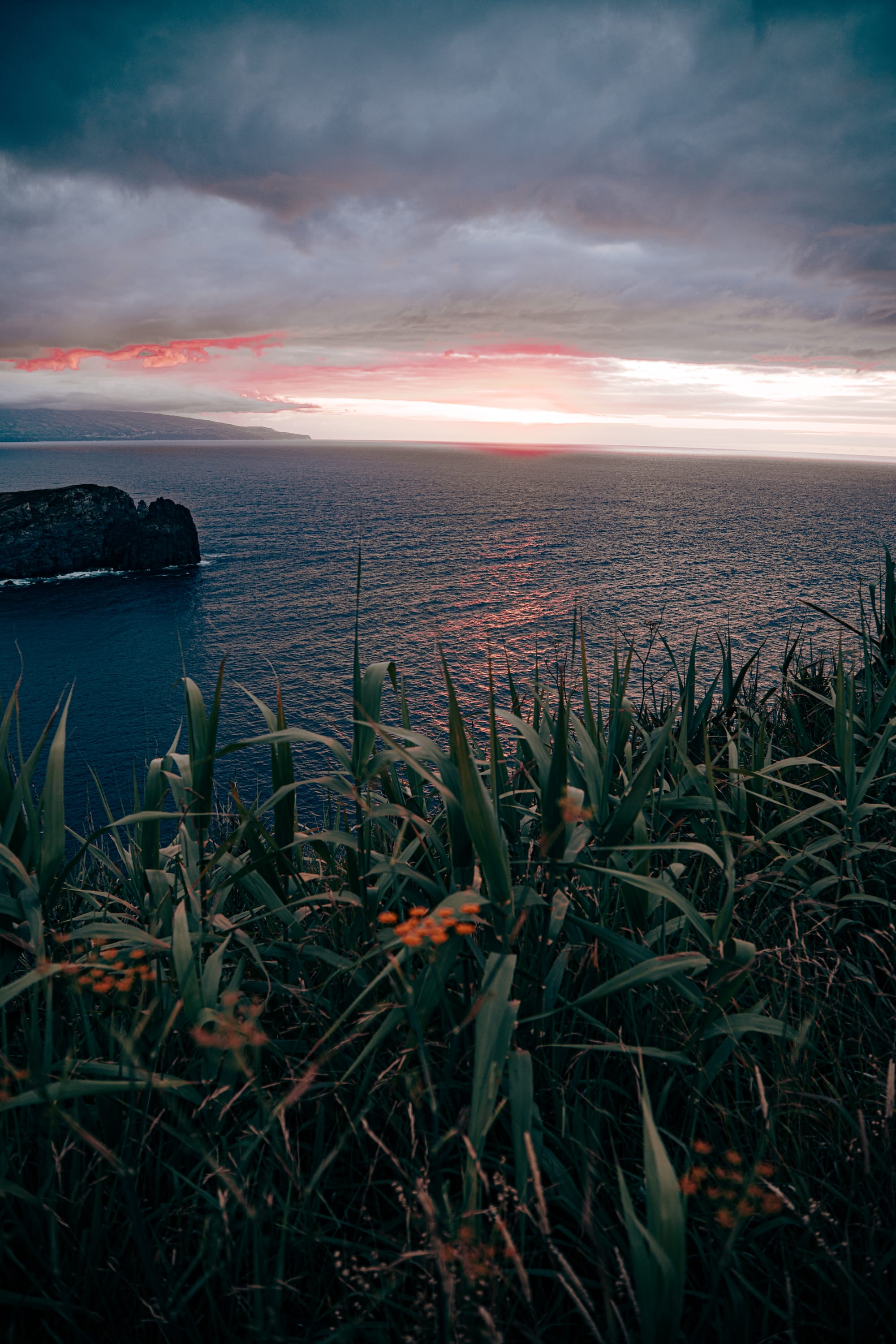
Clifftop grasses frame layers of rock and sea at Miradouro do Cintrão during sunset
From the edge of the cliff, the view expands in both directions—a coastline craggy and textured, with massive rock formations that jut out toward the sea like half-submerged cathedrals. Tall grasses and rustling stalks of cane line the foreground, softening the visual edge with golden movement. The sun, descending over the horizon, dyed the entire sky in tones of coral and lilac.
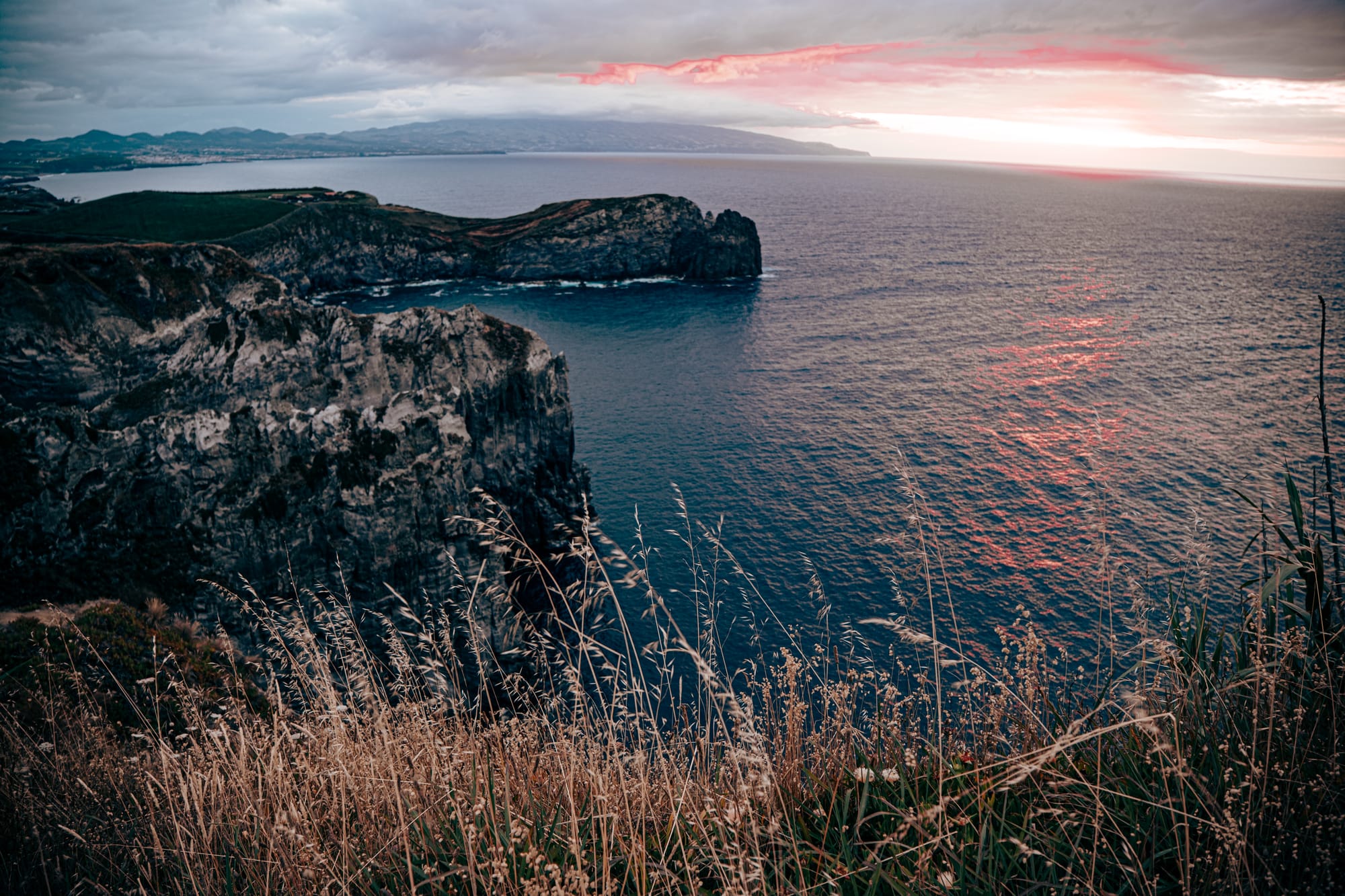
Here, the coast feels wilder. Shadows fall earlier along the cliffs, and the light lingers longer over the water. It’s a place for pause. For watching. For the kind of stillness that arrives when everything aligns—timing, color, air. If you’re searching for a place to see the island breathe in real time, Cintrão at sunset is where you’ll find it.
Miradouro do Pico do Ferro
Just above the town of Furnas, Miradouro do Pico do Ferro offers one of the most iconic and panoramic vantage points on the entire island. It’s a popular viewpoint for good reason: standing here, you can see the entire Furnas valley unfold below—patchwork fields, winding roads, geothermal springs, and the wide, green-hued Lagoa das Furnas itself.
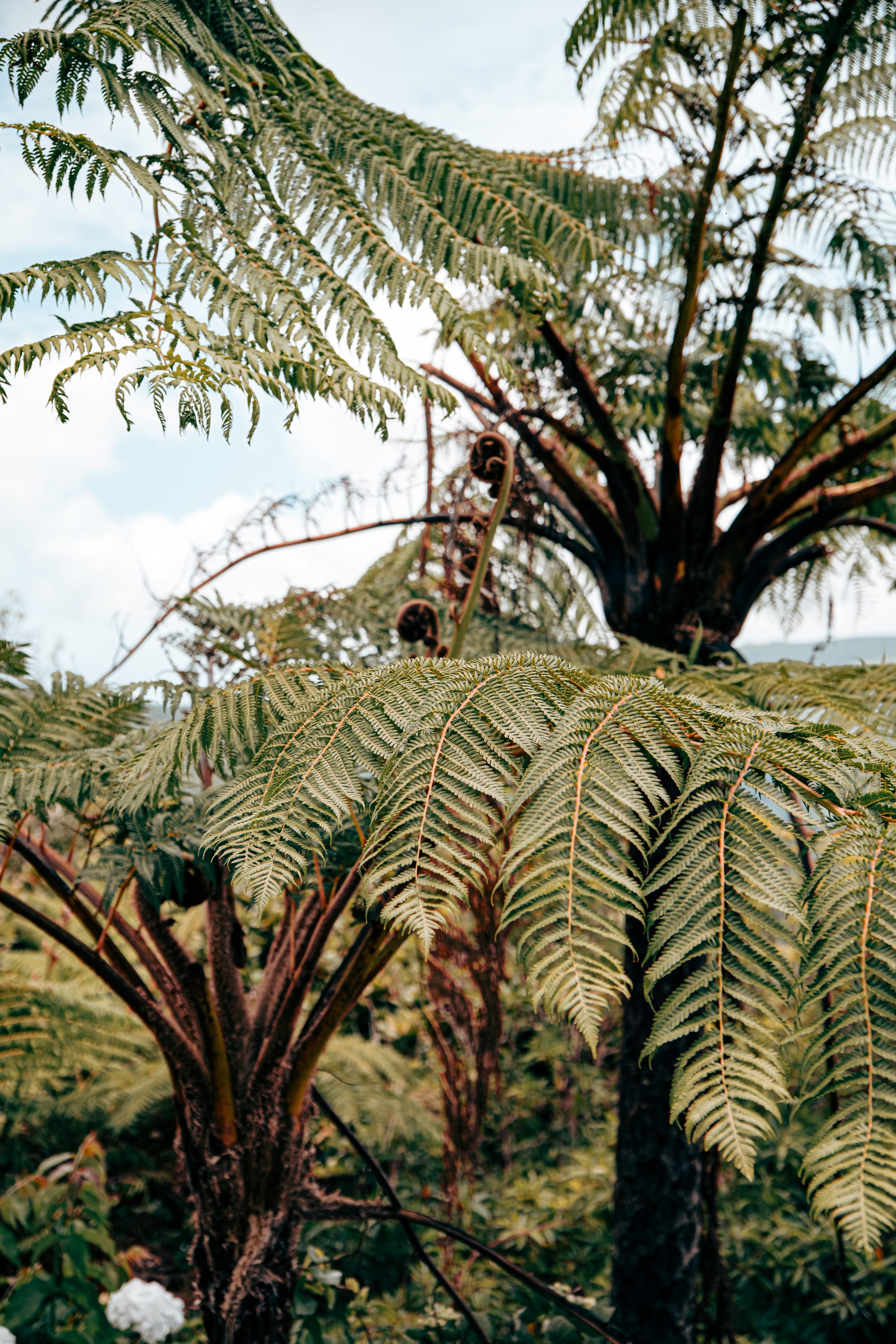
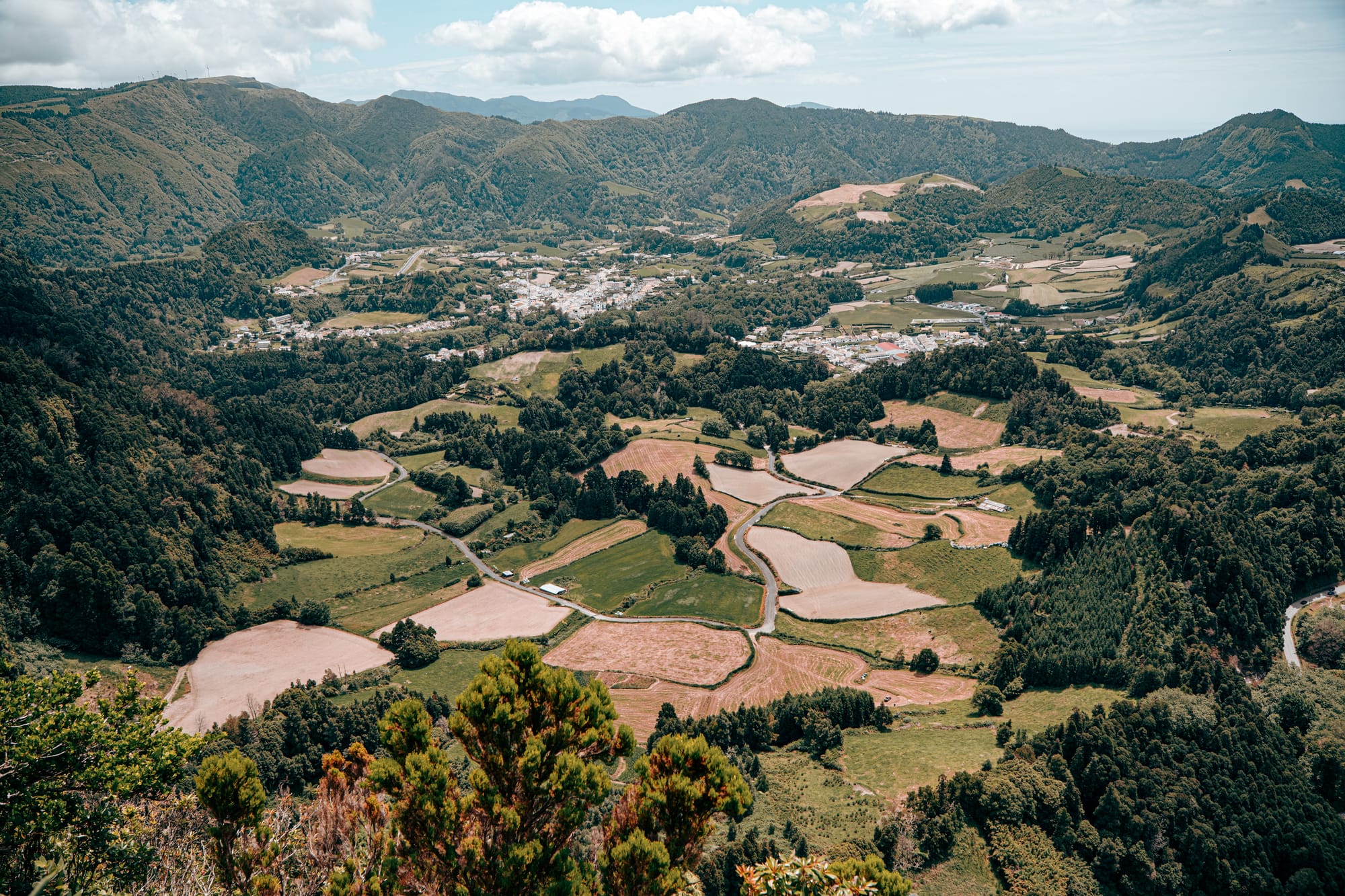
Fronds and farmland stretch wide across the Furnas valley from Pico do Ferro
The view from the top is shaped by layers. At the highest level, thick ferns stretch overhead like umbrellas, and you can glimpse tall cedars just off the footpath. Below that, a foreground of flowering hydrangeas and thick laurel adds color and scent to the scene. And beyond that, the crater basin opens up: soft, green hills rolling into one another, steam rising from the caldeiras near the lake’s edge, the village of Furnas nestled in between.
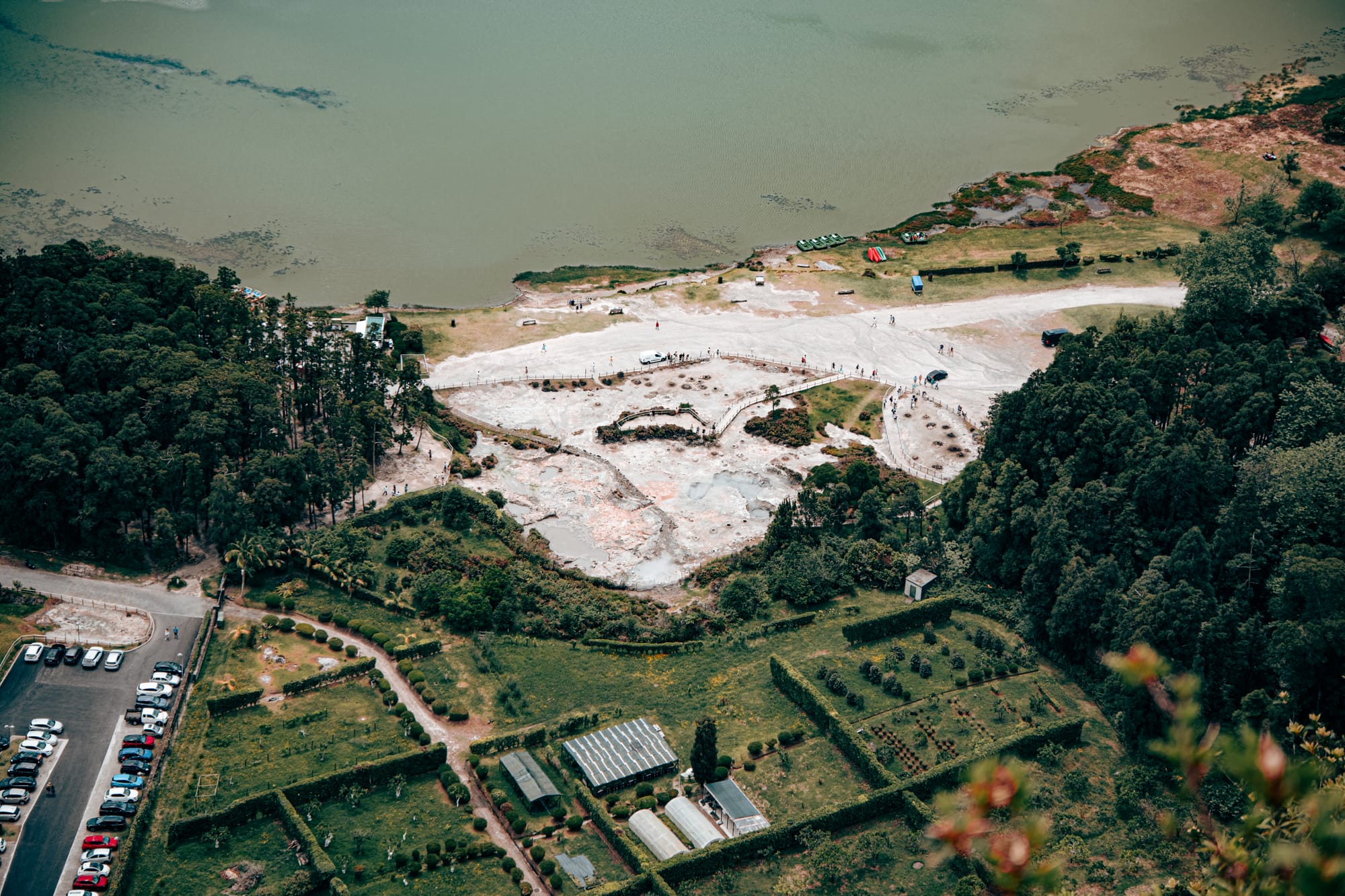
Depending on the time of day, the valley takes on different textures—morning haze, midday glare, golden hour glow. We arrived just as clouds were drifting low across the rim, casting shadows that moved slowly across the water. The lake itself looked like polished glass from up here, with soft ripples and a ring of reeds around the shoreline.
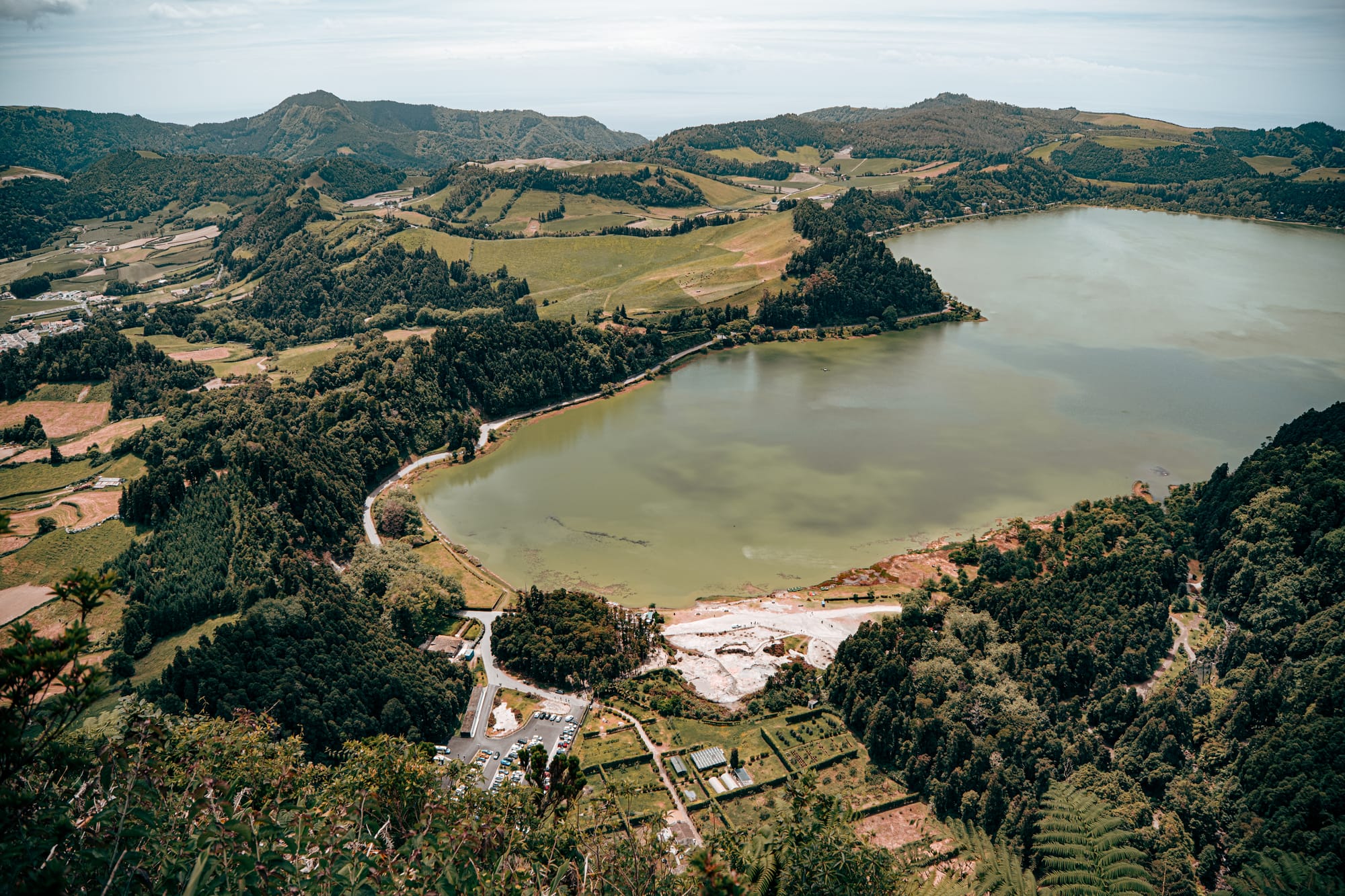
A few wide, cleared spaces make this a good place to sit and stay a while. There’s room to move around and look from different angles, each slightly shifting the composition. If you walk a few steps to either side, you’ll catch glimpses deeper into the forest or spot the town’s streets as they thread between hot springs and gardens.
While this is one of the more frequented miradouros on São Miguel, it’s still worth the stop. It’s easy to access, well-maintained, and just a short drive from the center of Furnas. You could easily pair it with a thermal bath at Poça da Dona Beija, a meal by the caldeiras, or a hike around the lake. (We’ve written more about the town here.)
From botanical textures to crater-scale drama, Pico do Ferro gathers much of São Miguel’s layered landscape into one sweeping view. It’s the kind of place that reminds you how active the island still is—geologically, visually, atmospherically—and how all of that motion can somehow feel so serene.
Miradouro da Lagoa do Fogo & Miradouro do Pico da Barrosa
Lagoa do Fogo, or “Lake of Fire,” sits in the collapsed caldera of an extinct volcano—a jagged, green-brown basin of wilderness that feels almost otherworldly. And there are two major ways to see it: from Miradouro da Lagoa do Fogo and from Miradouro do Pico da Barrosa. Both sit along the high mountain road that slices through the central spine of the island, offering sweeping, elevated perspectives of the crater lake below.
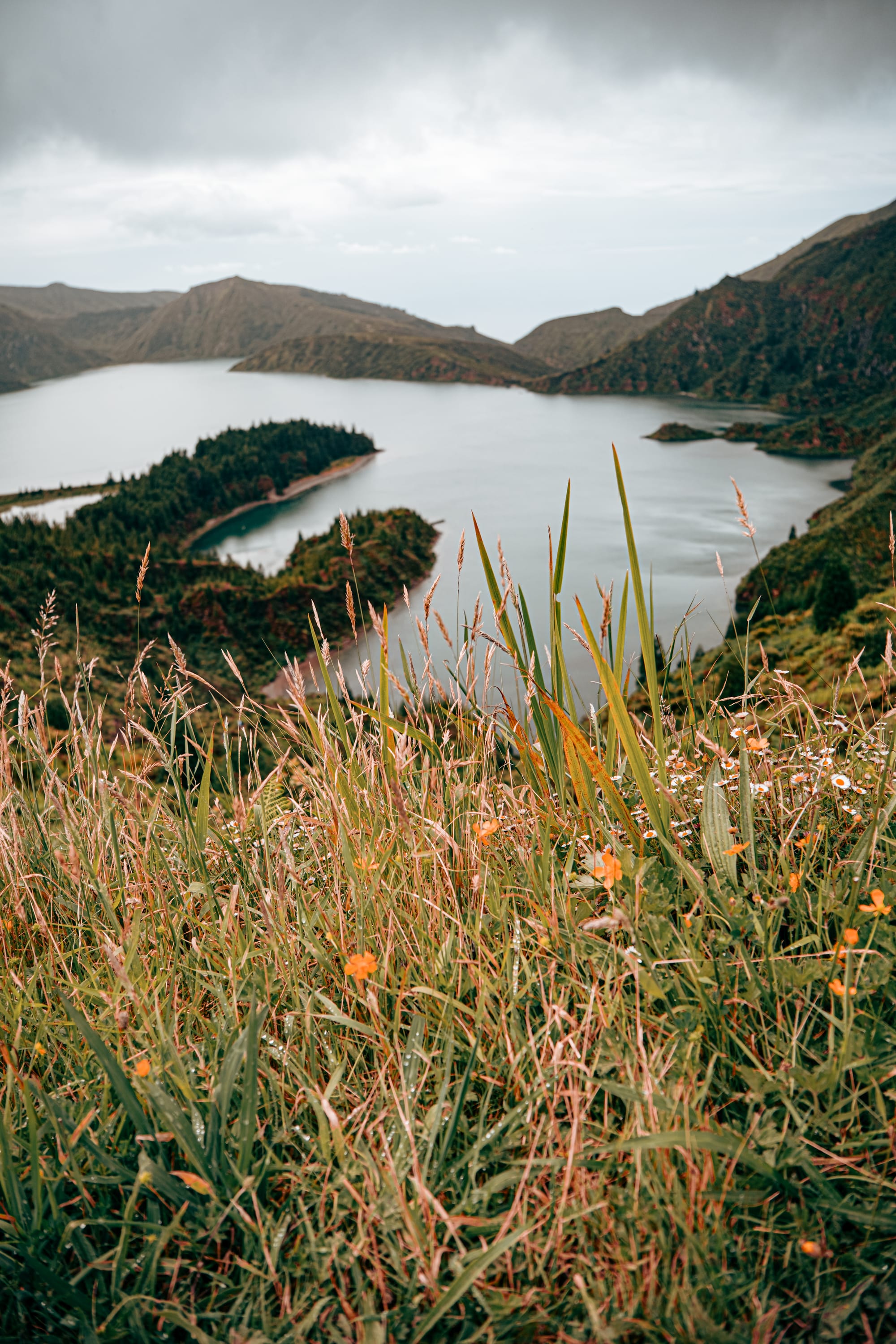
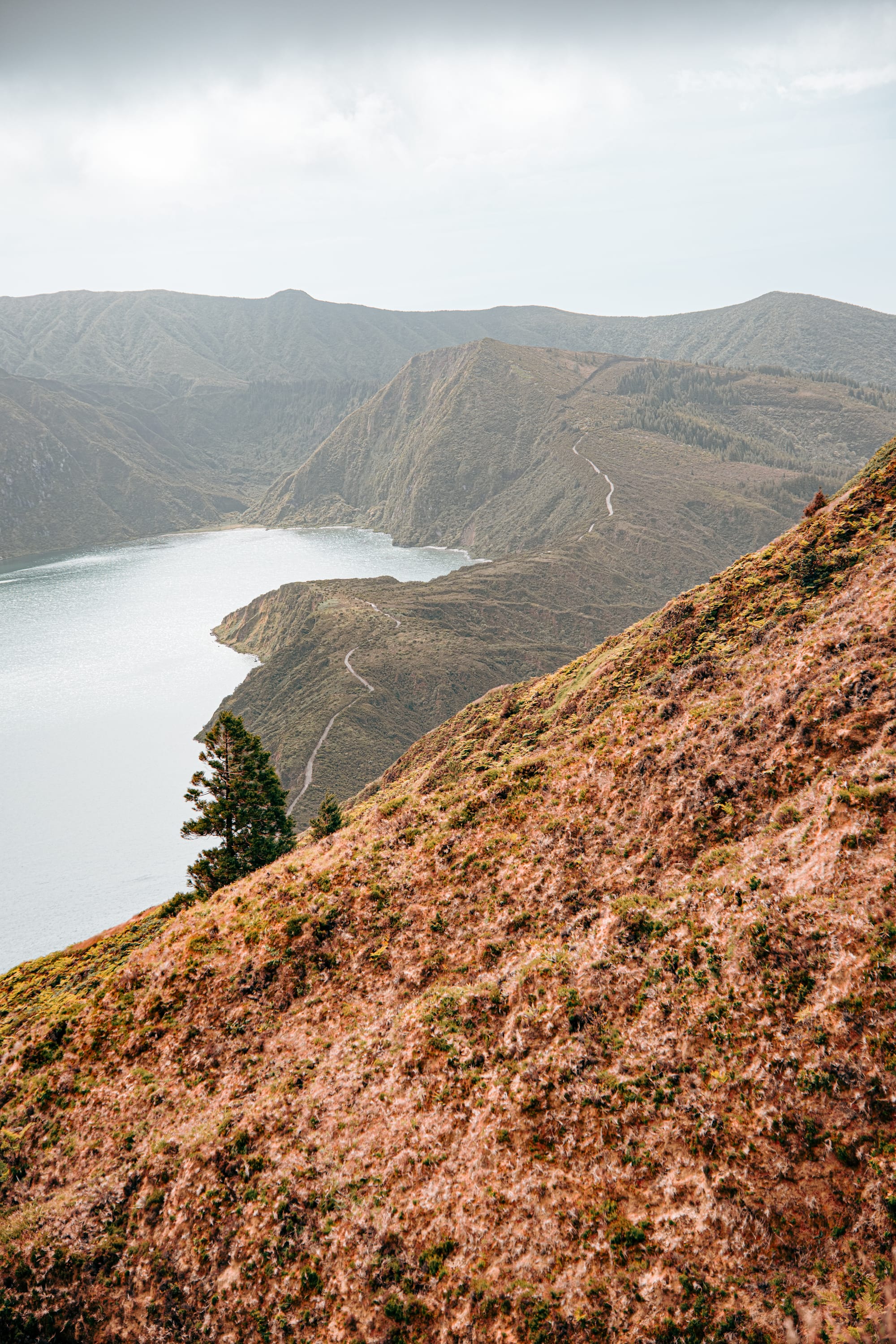
Wildflowers in the foreground of Lagoa do Fogo, with ridgeline trails weaving through volcanic peaks
Miradouro da Lagoa do Fogo is the more popular and designated lookout, with stone signage, easy pull-off parking, and a clear, slightly curved vista. The view opens up wide and east-facing, often above the clouds. There’s something striking about the color contrast here—between the grey-blue water, the ash-green slopes, and the rust-colored vegetation. It feels vast but not flat. Dynamic, with movement and stillness all at once.
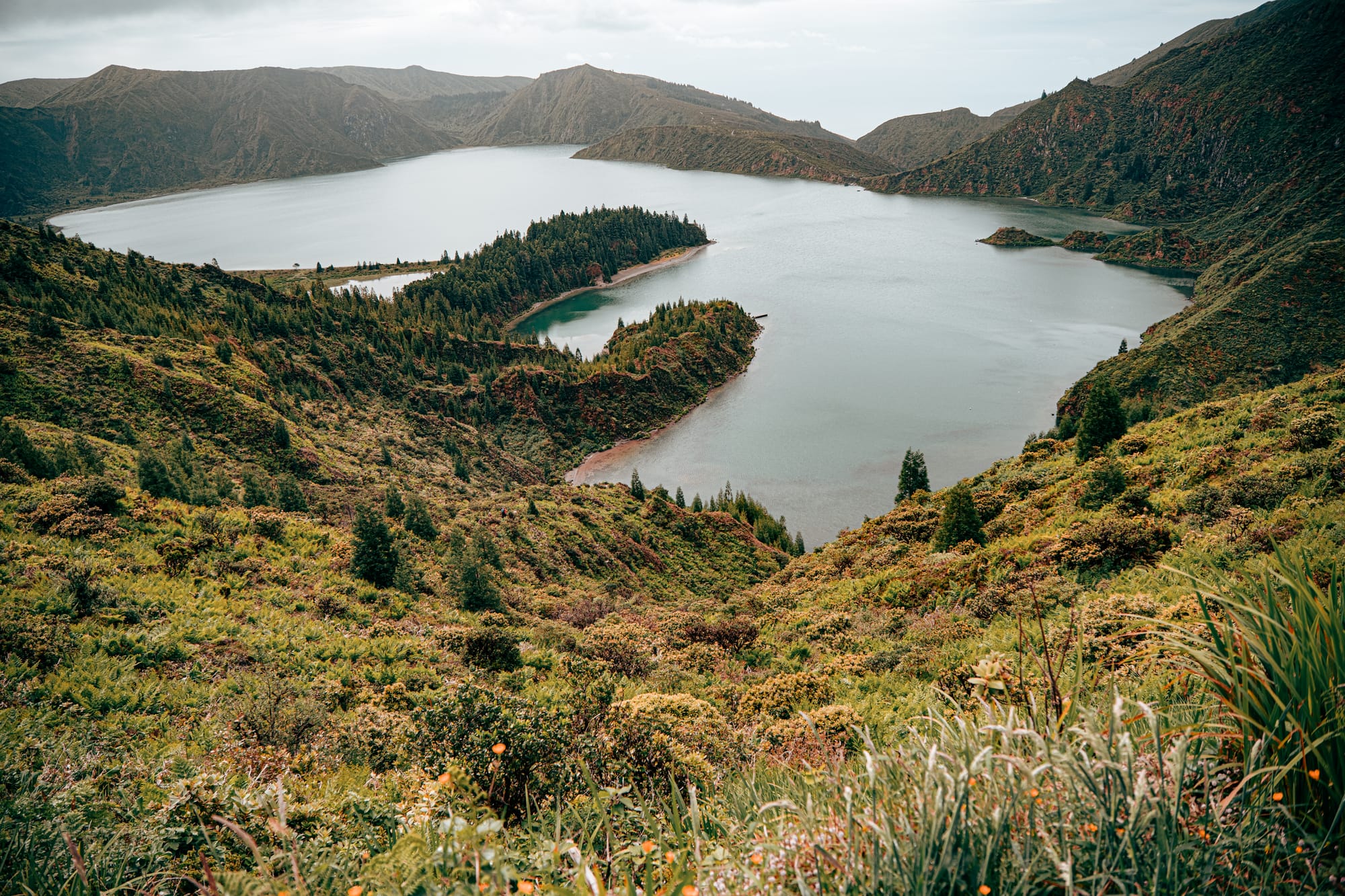
Just slightly farther up the same road, Miradouro do Pico da Barrosa offers a slightly higher, westward-tilting view, with long horizontal glimpses of the water and additional lines of sight to the opposite crater wall. This is where you start to notice the ribbon-like hiking trails in the distance—narrow paths zigzagging up sharp ridges, fading into volcanic folds. It’s the kind of place that invites pause and orientation. Where the scale of São Miguel becomes legible in a single glance.
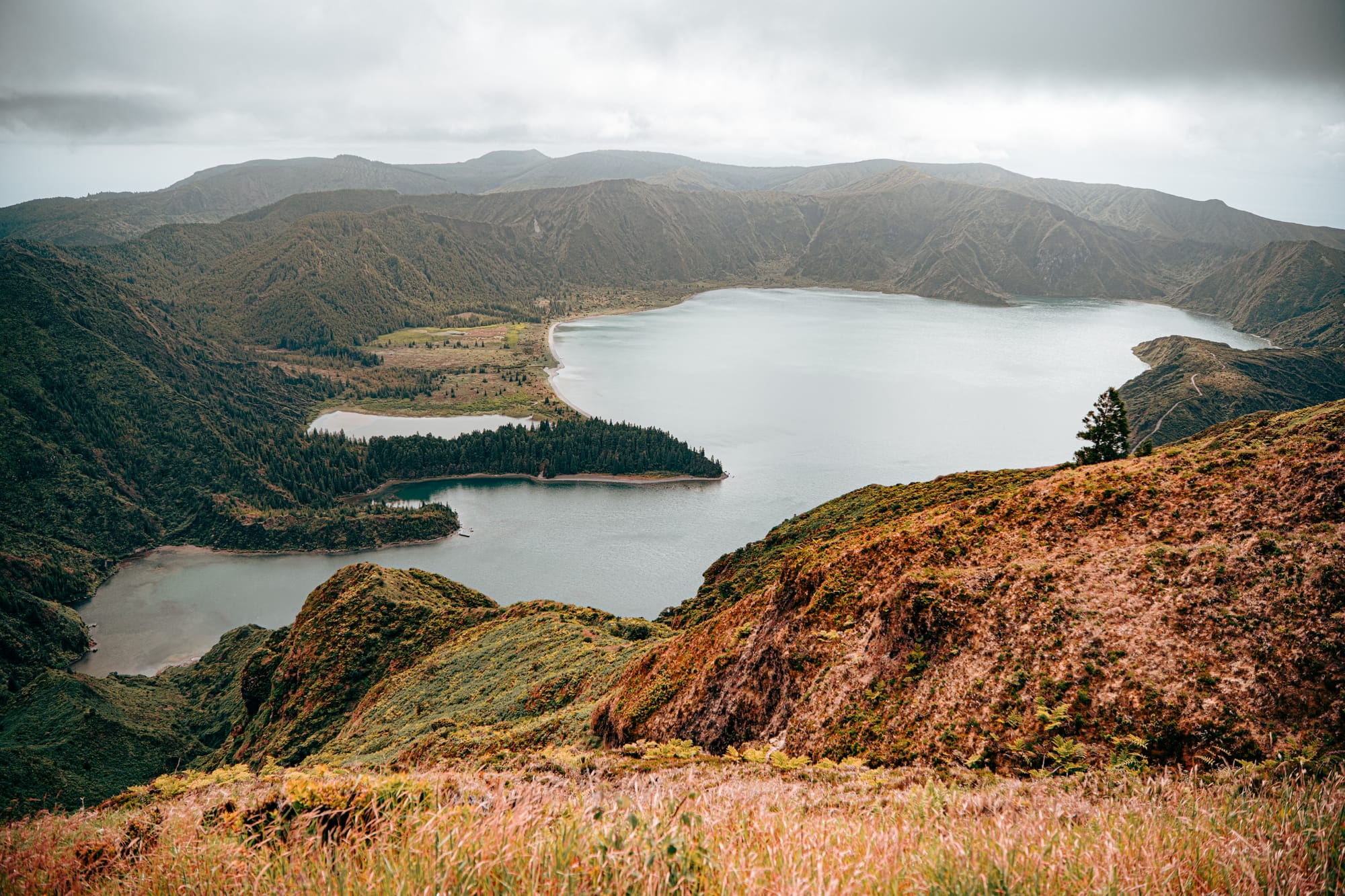
Both lookouts are weather-dependent—clouds and mist often sweep through in waves, offering partial or fleeting views. But even in these moments, the silence and drama are part of the experience. The wind is sharp, the vegetation low and bristled, the lake deep and still. We recommend visiting both if you’re already on the road across the island, as they’re only a few minutes apart by car and offer such subtly distinct perspectives.
The elevation here brings with it a sense of scale: of water held in a sleeping volcano, of sky pressed close, of land that still remembers its own fire.
Miradouro da Vista do Rei
Perhaps the most visited viewpoint on São Miguel, Miradouro da Vista do Rei lives up to its name: the King’s View. From this vantage point, you get a sweeping perspective over the twin lakes of Sete Cidades—Lagoa Azul and Lagoa Verde—resting within the ancient volcanic crater.
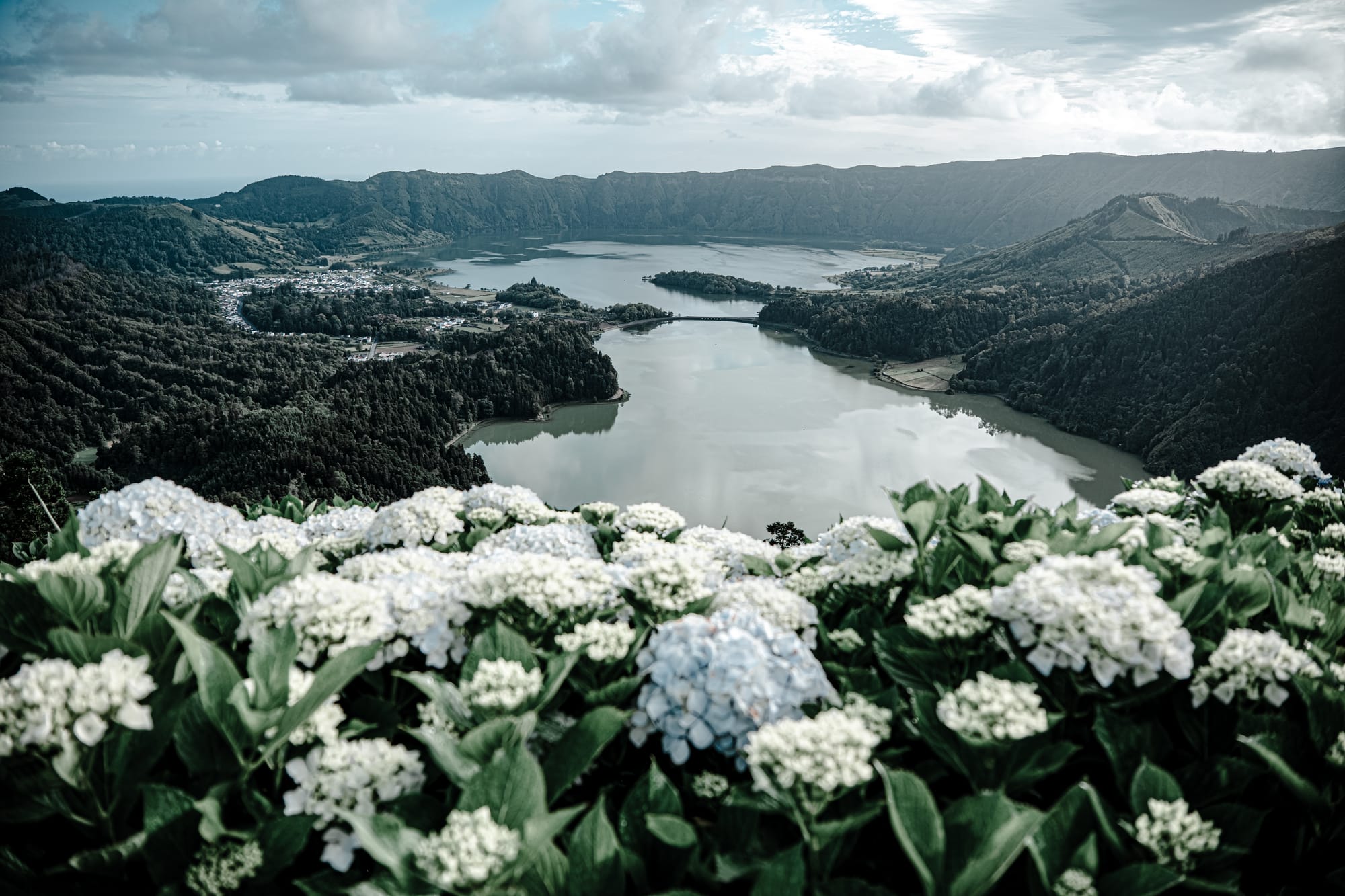
The viewpoint is named after King Carlos of Portugal, who visited in 1901, and it’s easy to see why the site carries royal weight. The lakes shine below, separated by a narrow isthmus and surrounded by the collapsed rim of the volcano.
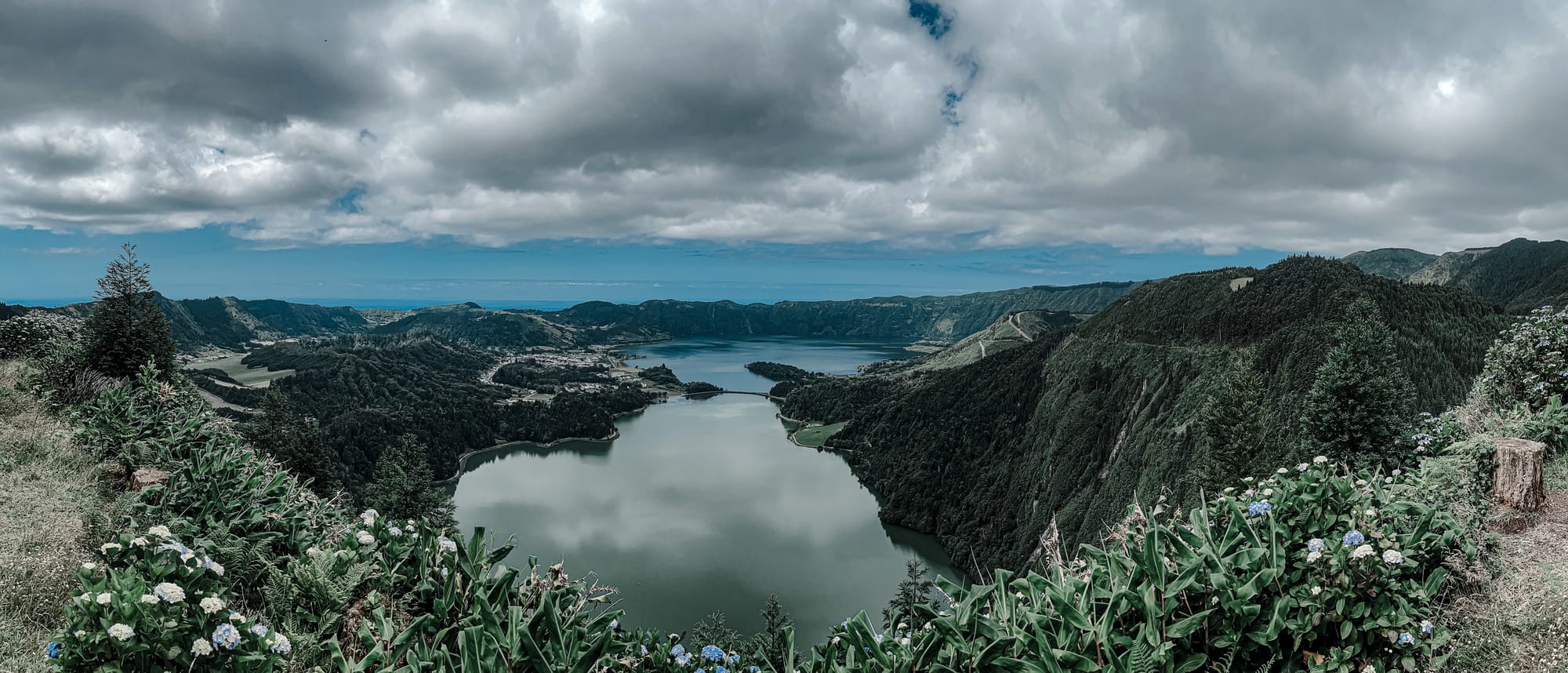
From the parking area, the walk itself to the viewpoint is quite scenic, with gorgeous moss-covered trees and hydrangeas.
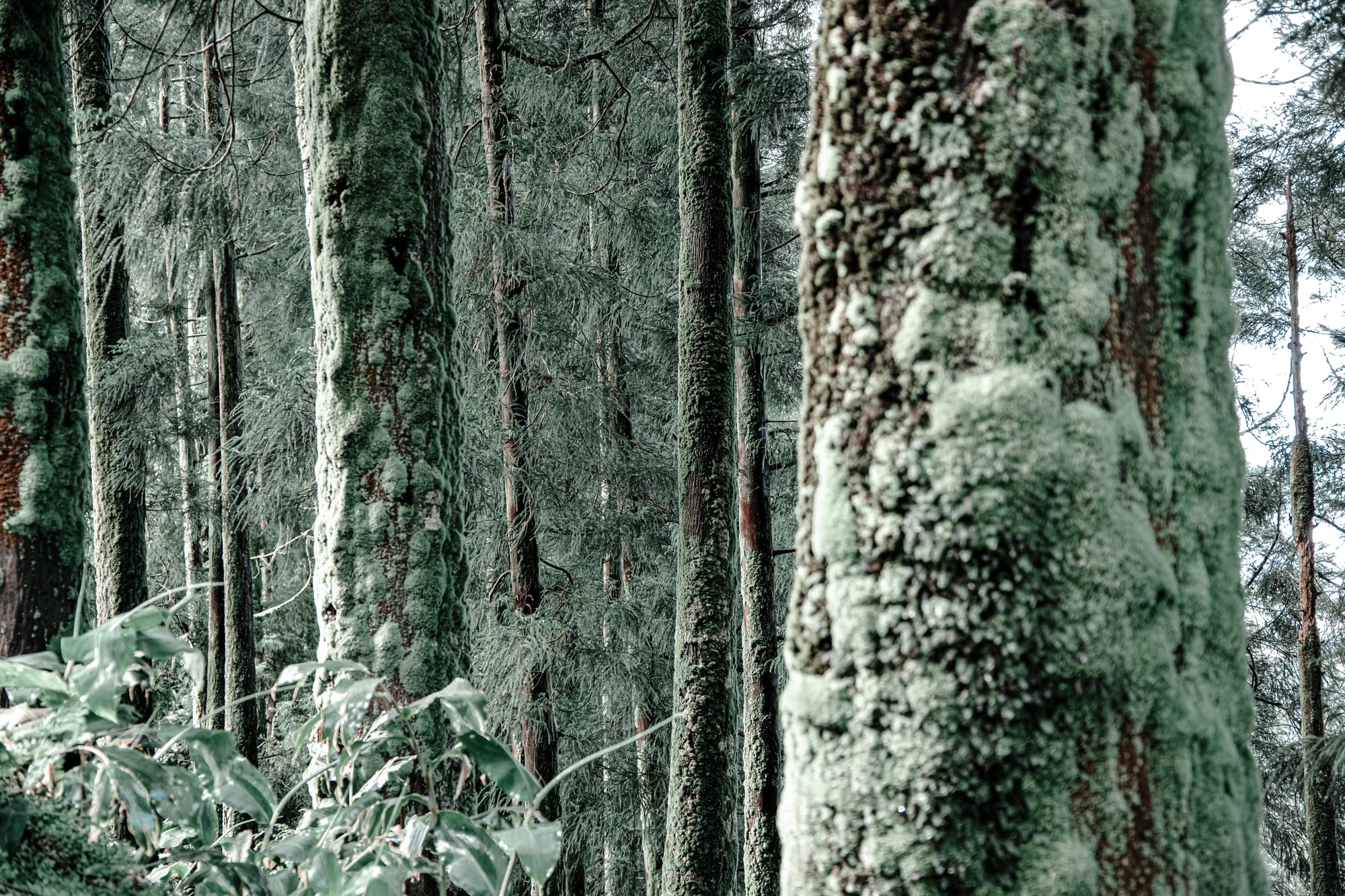
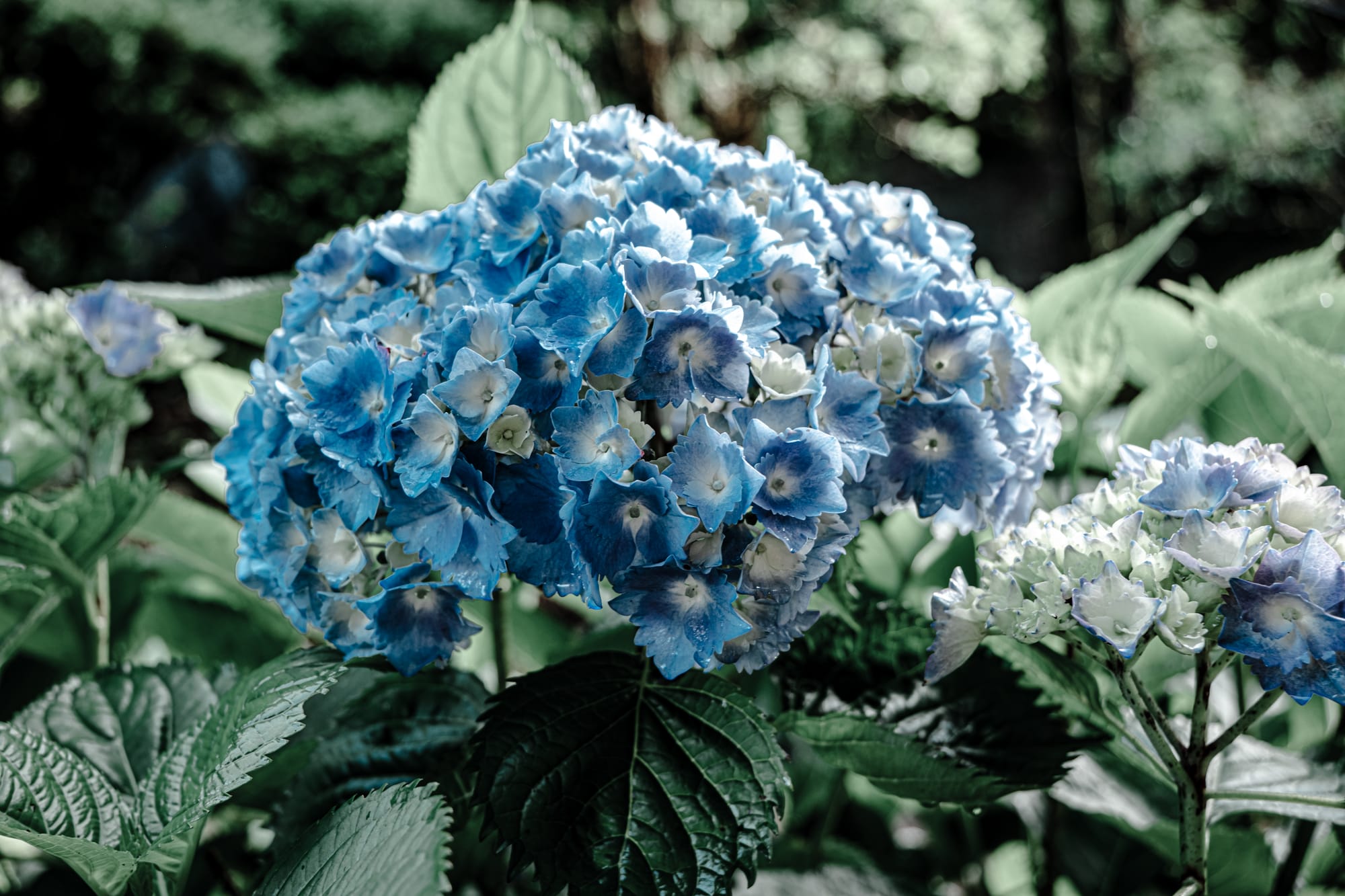
Ferns and mossy trunks frame the path to Sete Cidades, where hydrangeas bloom in blue gradients
Nearby sits the shell of the abandoned Monte Palace Hotel, a 1980s luxury complex that never fully came to life. The hotel has become an unofficial site of urban exploration, with vines climbing its concrete walls and rooms that open onto vast, uninterrupted views. Climb carefully, and the rooftop offers perhaps the best 360° vista on the island.
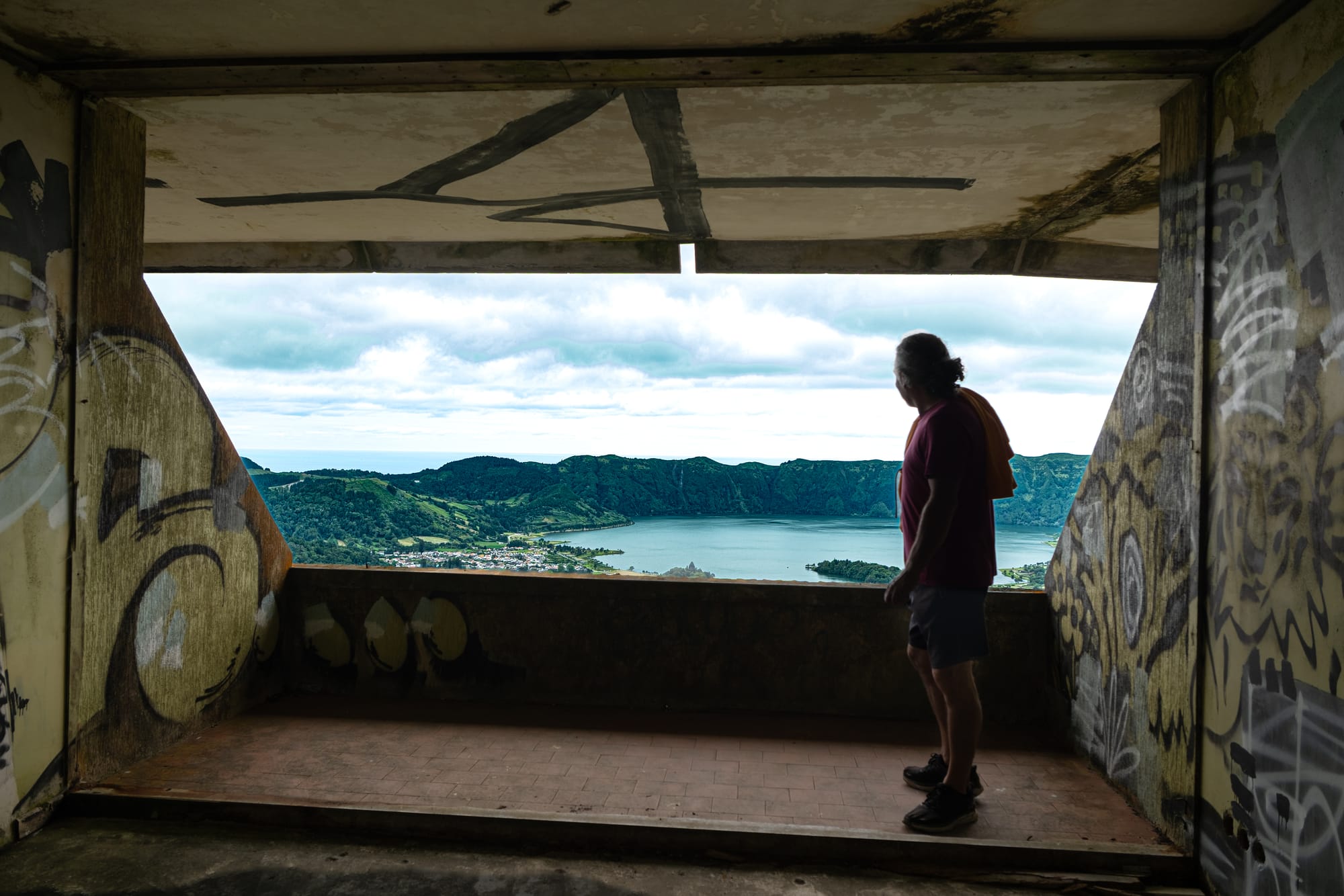
If you're lucky, you'll catch some birds in the area.
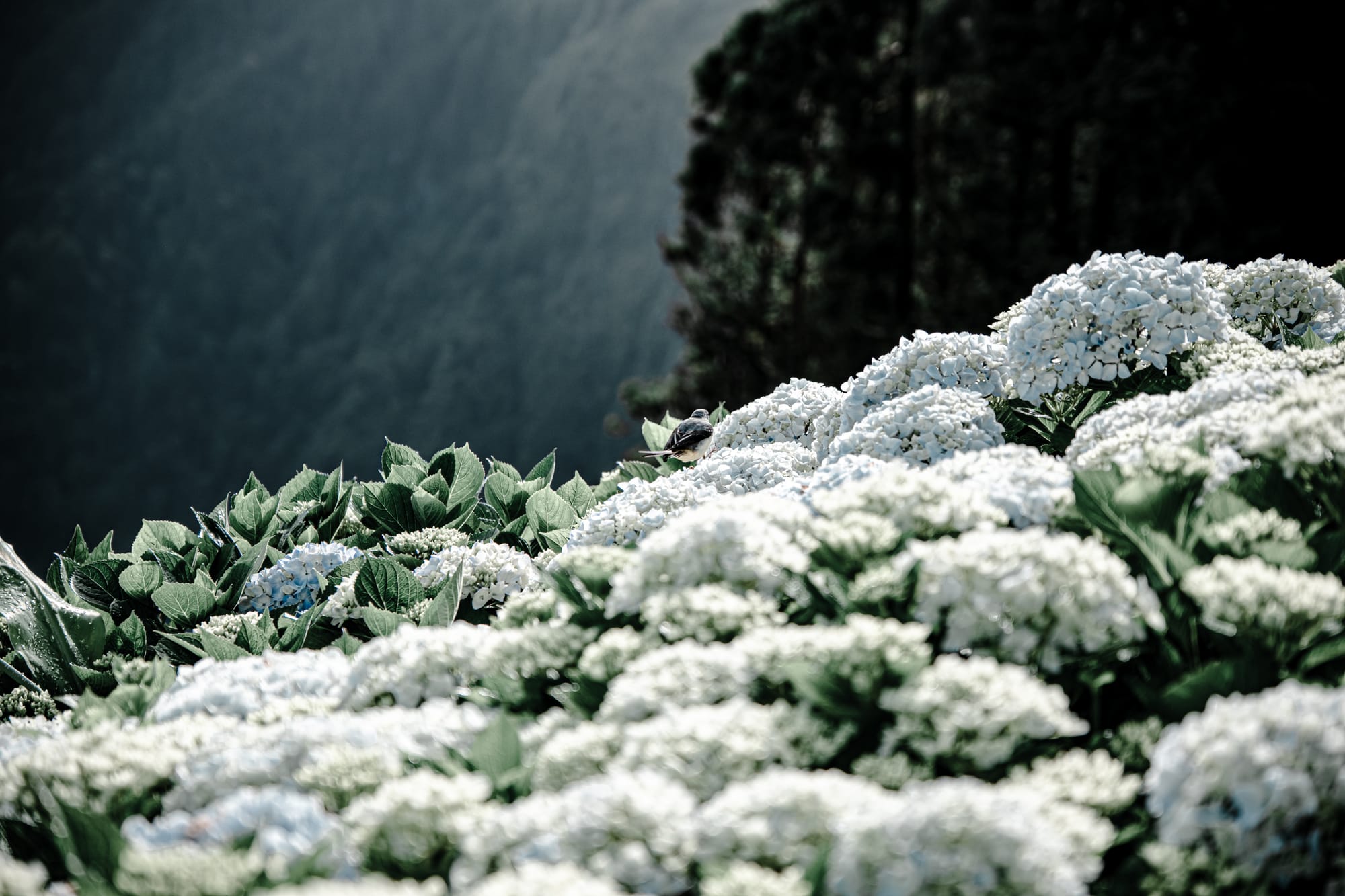
Vista do Rei is also a common trailhead for hikes that loop around the crater rim toward the village of Sete Cidades.
Miradouro da Nossa Senhora da Paz
Just before reaching the Santuário de Nossa Senhora da Paz, a striking white church perched high above Vila Franca do Campo, there’s a smaller, quieter reward: Miradouro da Nossa Senhora da Paz, set slightly below the sanctuary steps. It's easy to overlook on the way to the religious site, but it's worth lingering here.
From this terrace, you can see the entirety of Vila Franca do Campo, its terracotta rooftops laid out in careful geometry. The town feels close and miniature from up here, detailed enough to trace individual streets and orchards, yet far enough to feel suspended from daily time. What really sets this viewpoint apart, though, is the small islet just off the coast—Ilhéu de Vila Franca do Campo. Once part of a volcanic crater, this circular island now serves as a natural swimming basin and marine reserve. From above, it looks sculptural, almost mythical.
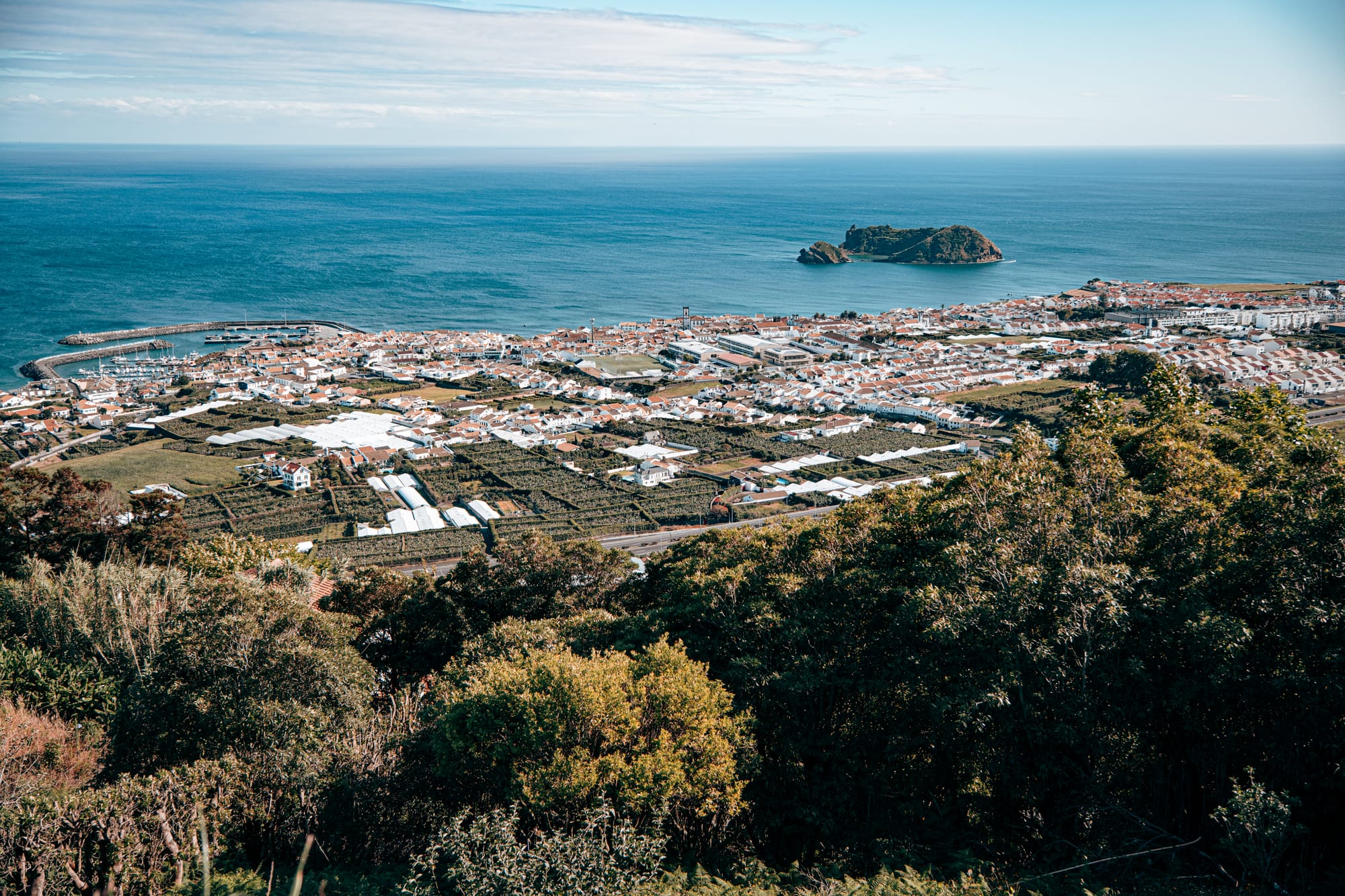
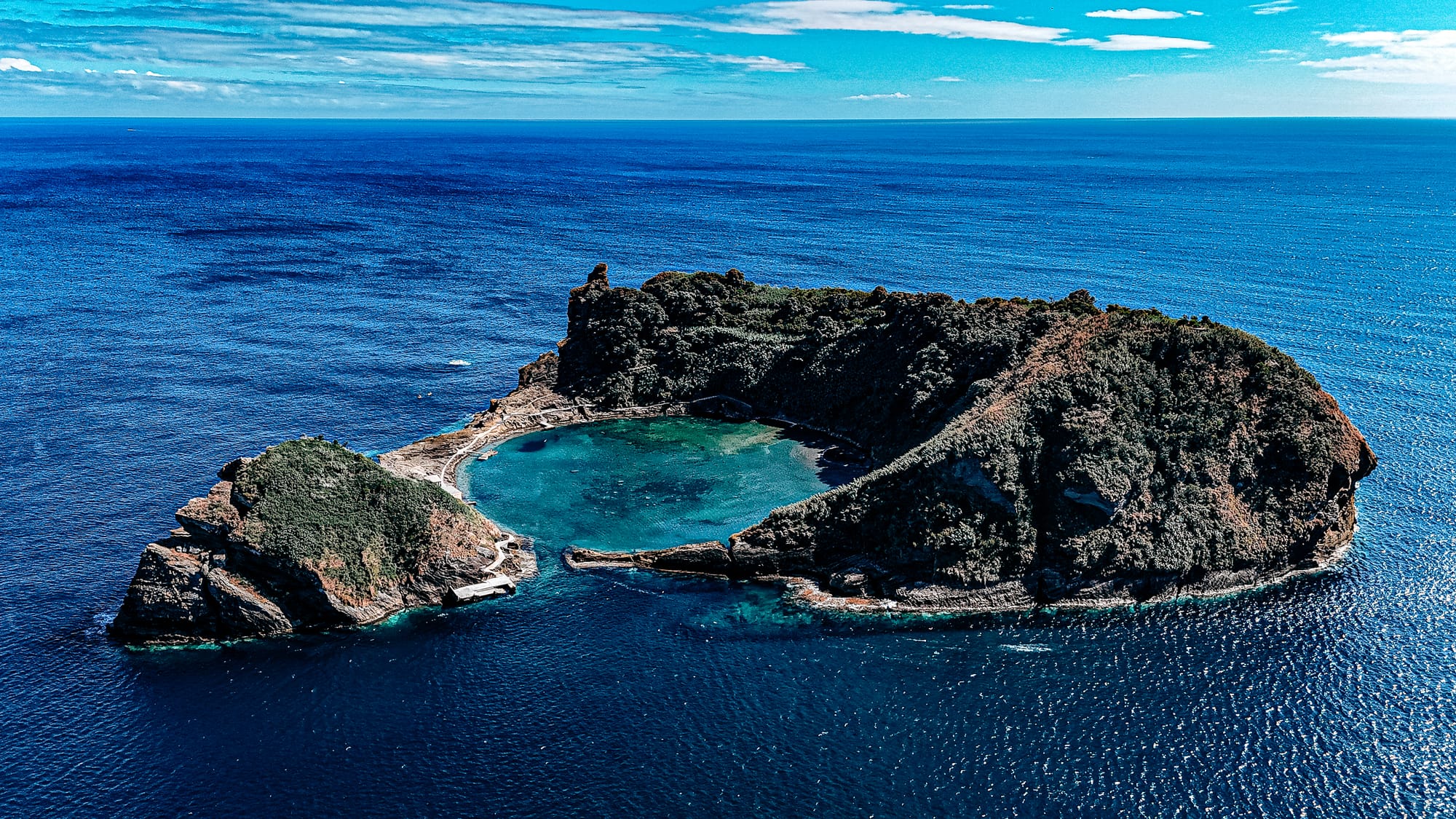
Overlooking Vila Franca do Campo and its iconic islet crater floating just offshore
Hydrangeas crowd the hillside near the miradouro, their blooms sometimes catching ocean breeze and framing the view with deep blues and pale whites.
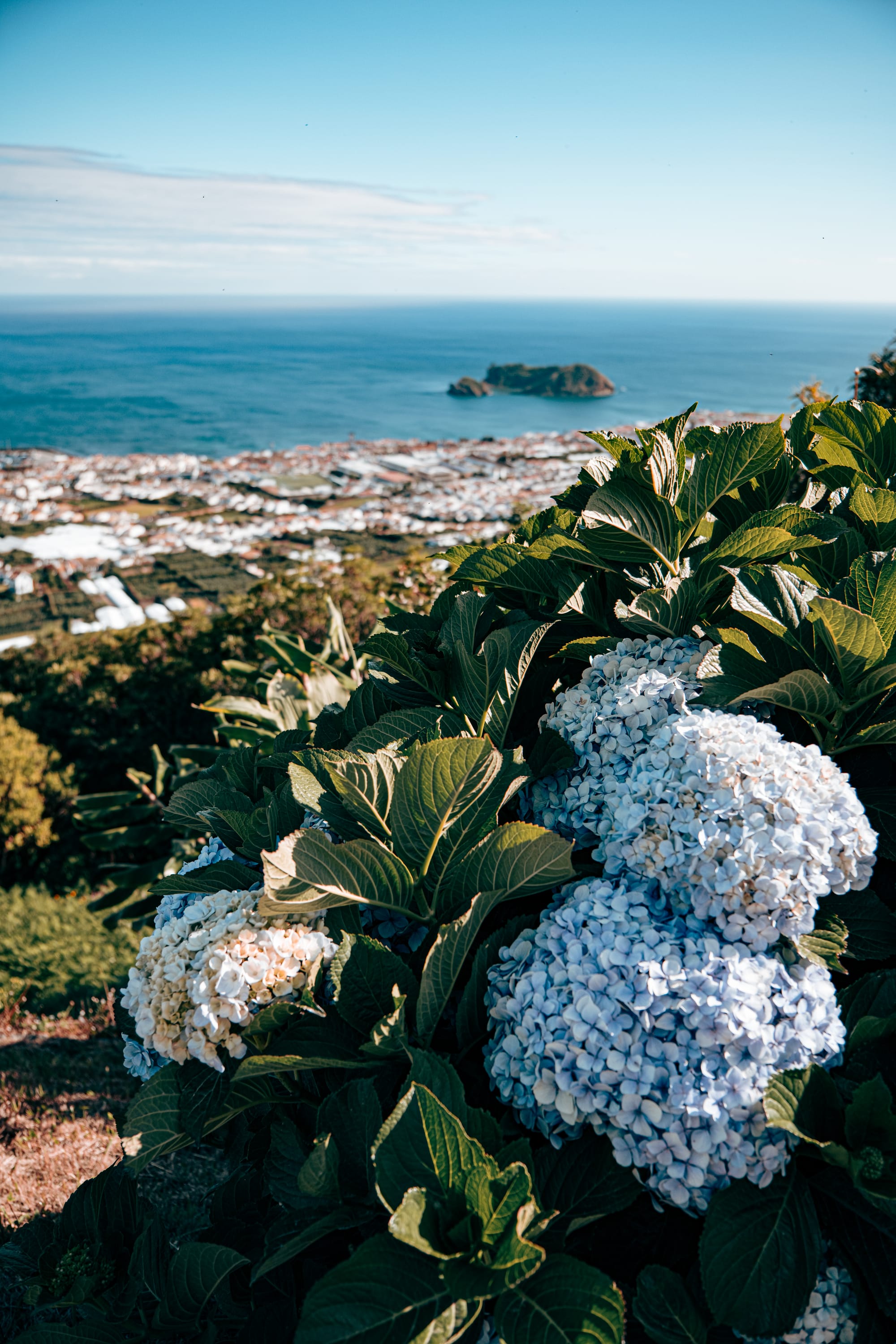
It’s a soft, contemplative place. You’re close to the church, but also a little removed. You could easily stay here longer than you intended, watching how the light moves across the town, or how the outline of the islet shifts slightly with the sky.
The viewpoint is well-positioned for both sunrise and late afternoon light, and the clarity of the view makes it a useful place to orient yourself before exploring the town or the church above.
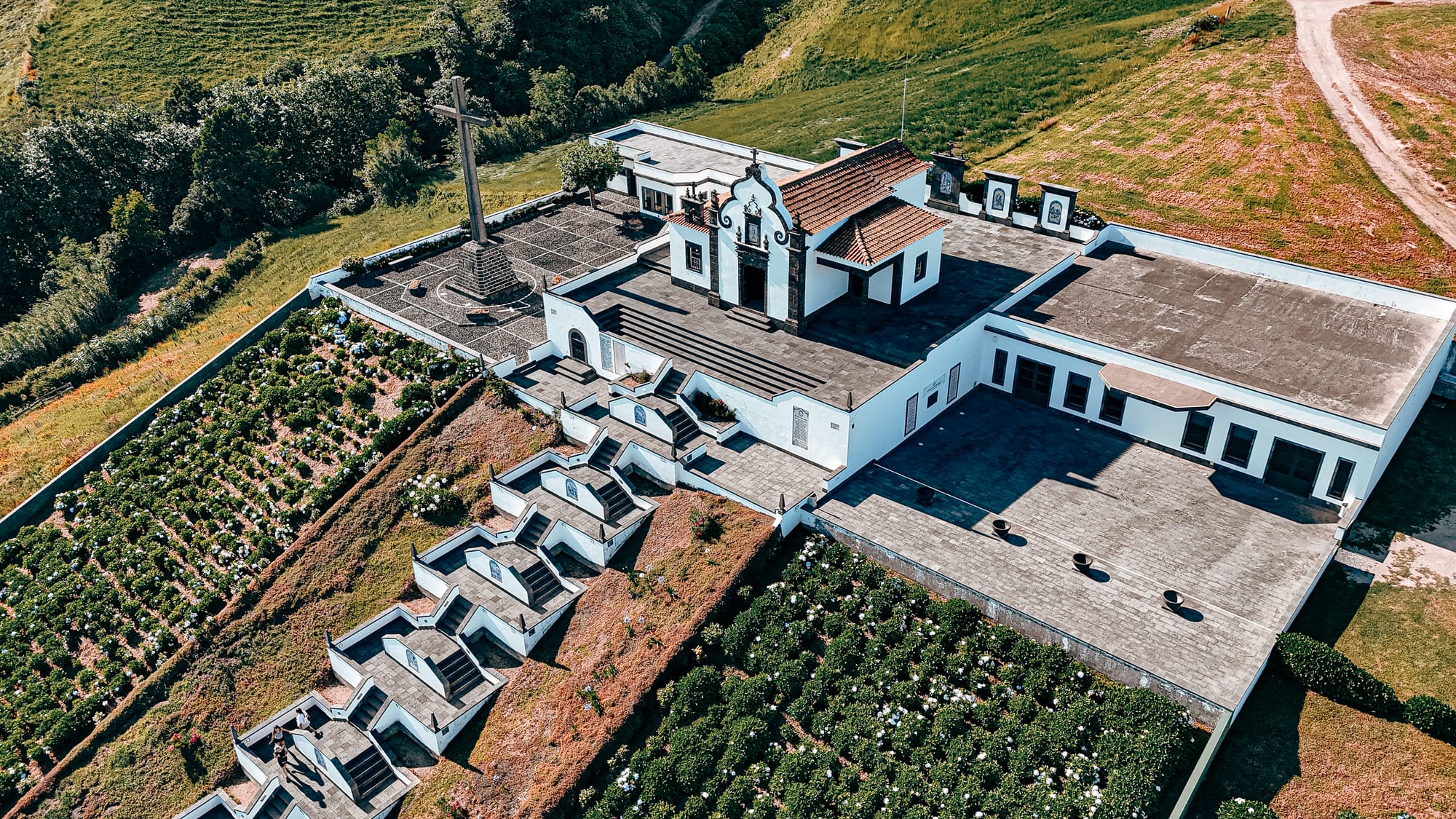
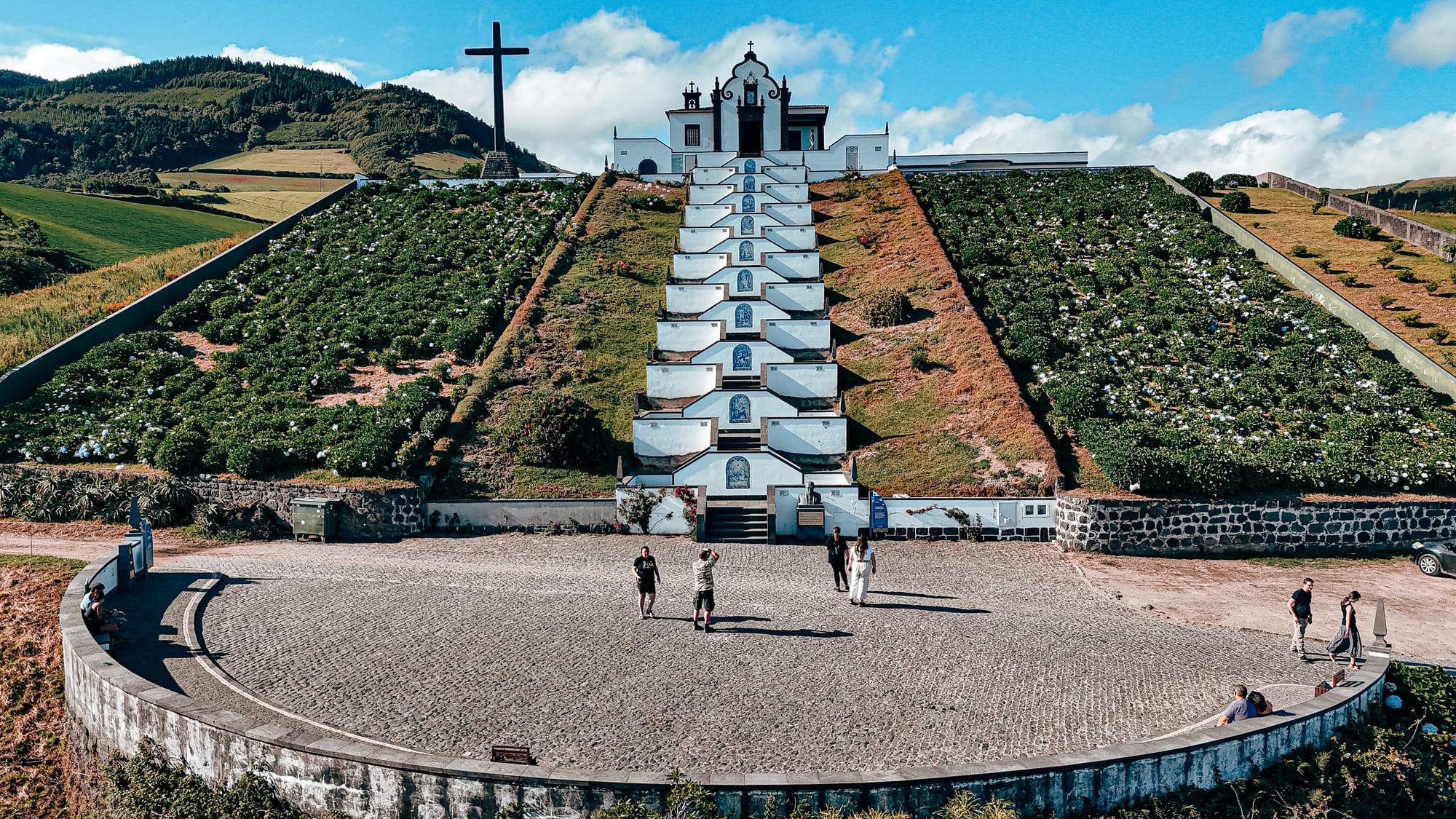
The symmetrical staircase and hilltop shrine of Nossa Senhora da Paz, a sacred site above the sea
If you’re already heading to the Santuário, pause here. If you’re not, this miradouro is reason enough to make the climb.
Miradouro de Santa Iria
Set along the northern edge of the island, Miradouro de Santa Iria is wide, open, and softly dramatic. The viewpoint itself is a grassy slope with a tiled marker, a few shaded benches, and a low stone wall, but the view stretches in a long sweep over the coast—farmland, cliff, ocean, and sky.
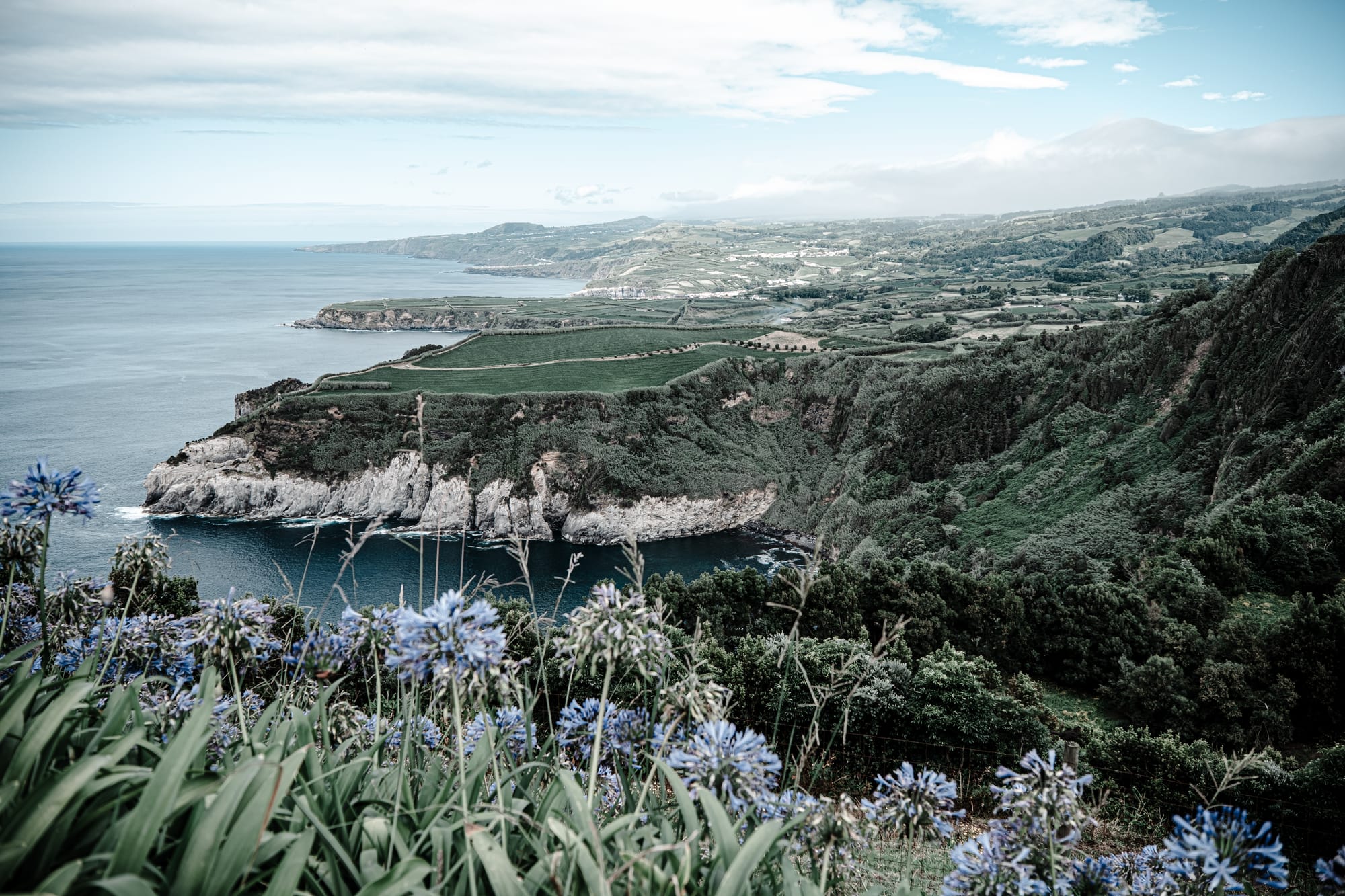
When we stopped here, a proposal was taking place. The woman nodded, and everyone around the overlook clapped. It felt like a moment that belonged to the place, not just the people.
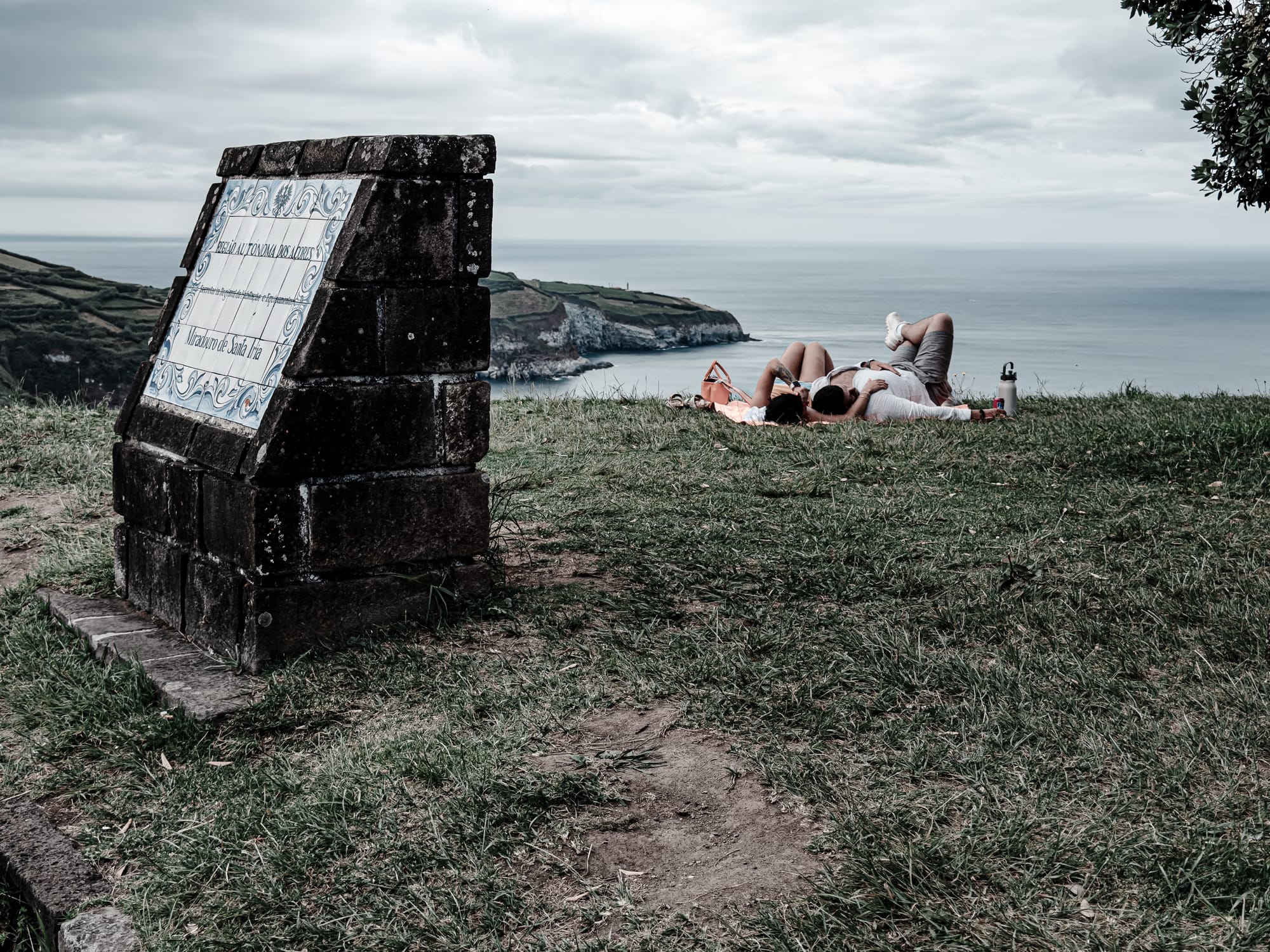
Around us, people were reclining in the grass, sipping from thermoses, reading books, or just sitting in quiet. The hydrangeas near the edge were in full bloom, and below, a sharp peninsula arced into the Atlantic. This is less a quick photo stop and more a place to linger—proof that even the more frequented miradouros can still hold intimacy.
Miradouro do Pico Longo
Just off a winding road on the eastern spine of São Miguel, Miradouro do Pico Longo is modest—more curve than platform, more pause than destination. But what it offers is one of the island’s most cinematic perspectives: a soft, sweeping view over the valley of Povoação, with a patchwork of green fields, clustered white villages, and the far shimmer of the Atlantic.
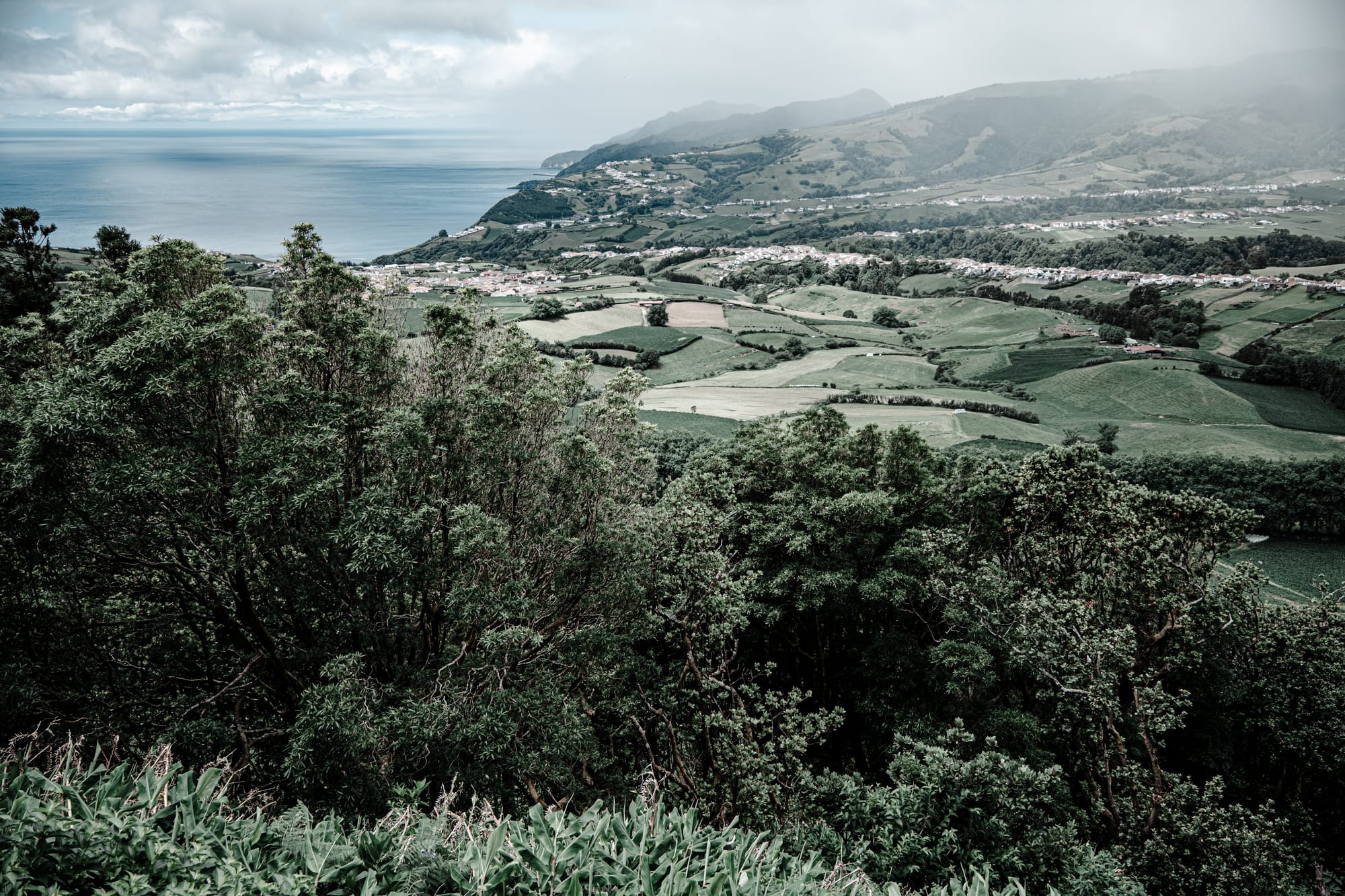
The miradouro itself is simple—a cement arc with moss stains and faint graffiti—but its position is impeccable. You can see the patchwork of fields stretch all the way to distant towns, with the blue-green of the sea catching the light differently every few minutes.
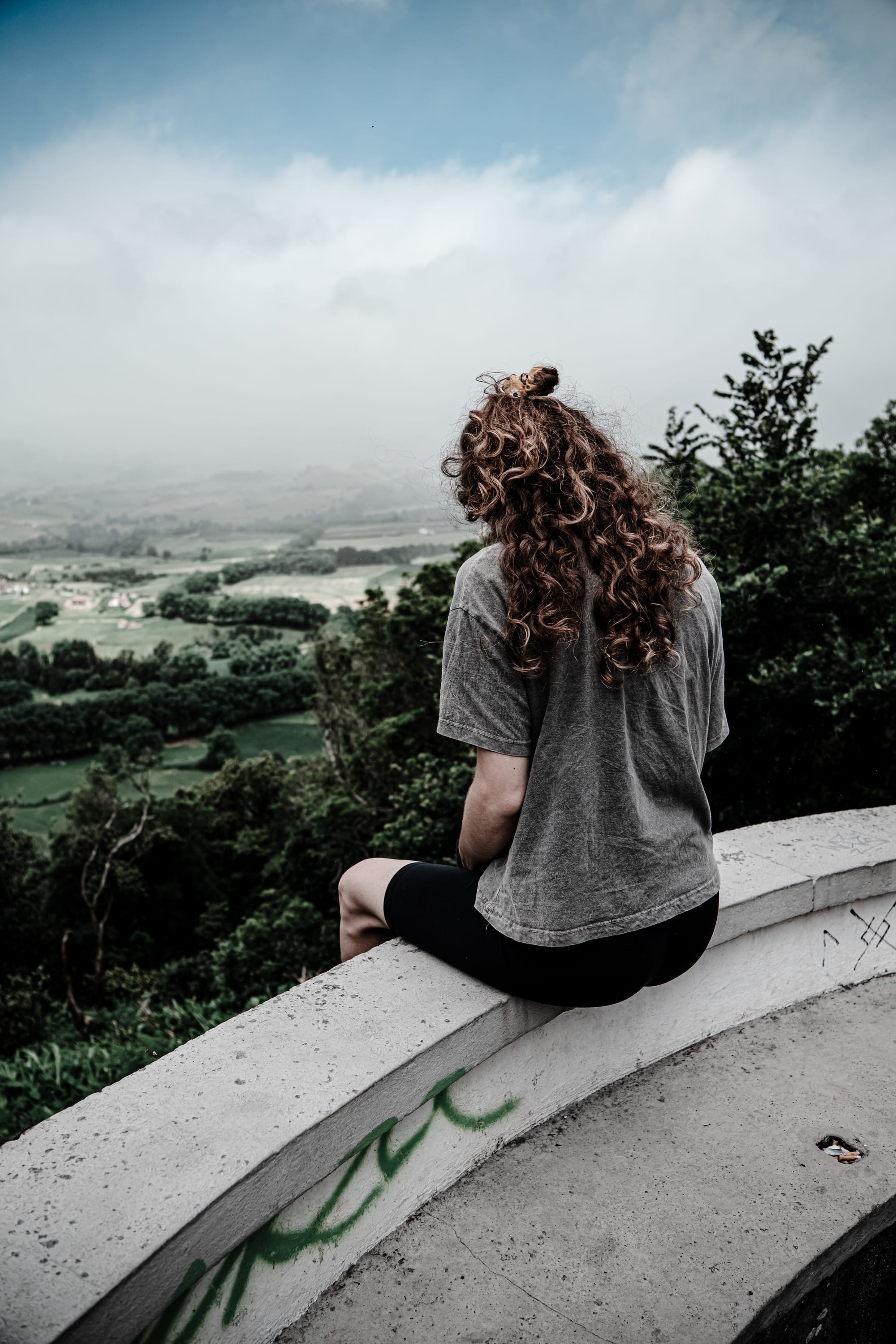
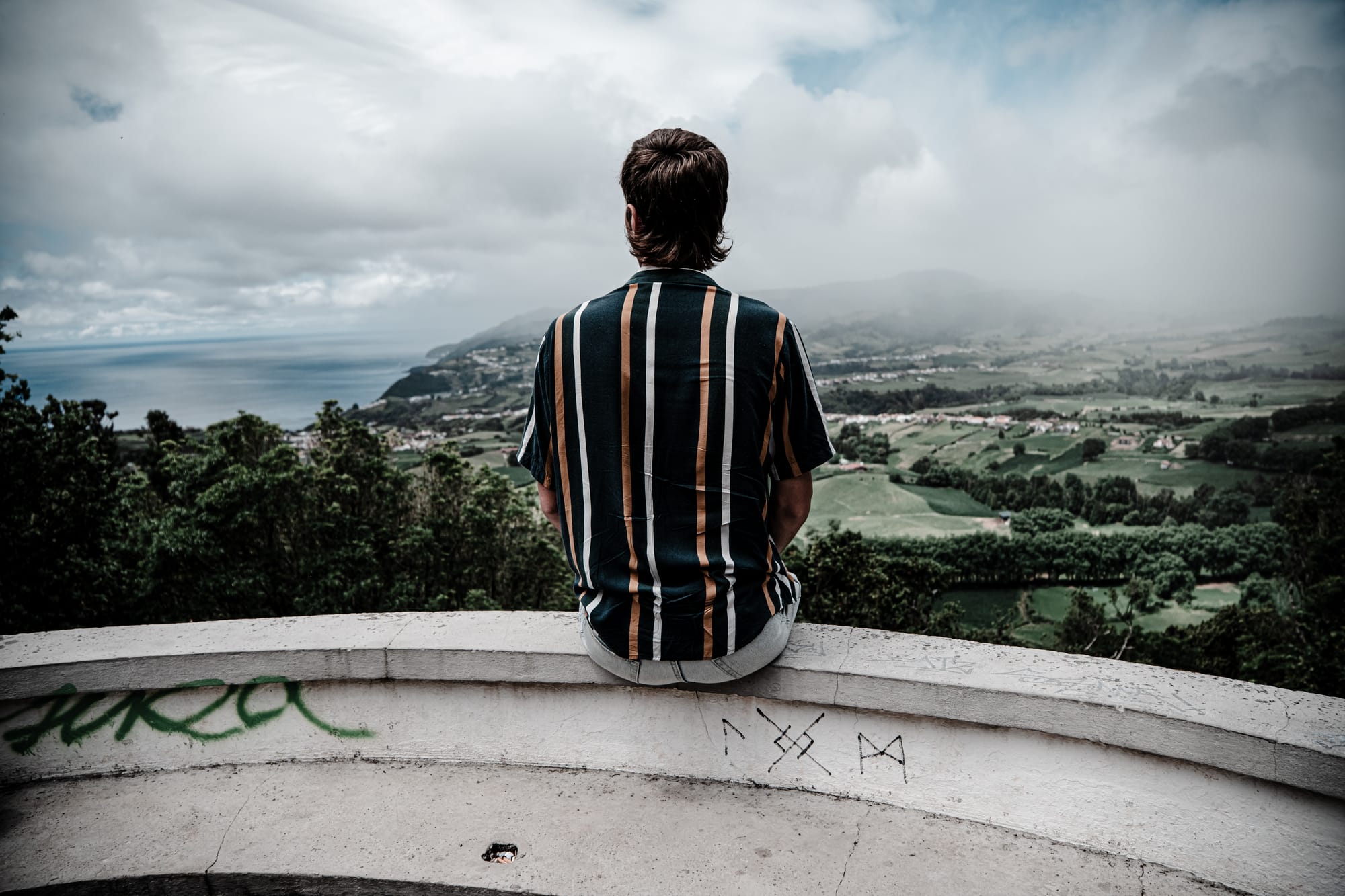
People pausing at Pico Longo to take in the island’s sweep and softness
The balustrade is low and circular, a concrete half-moon ringed with graffiti and flecked with moss. It gives you a place to sit and settle, and when you do, you’ll feel like you’re hovering just above the treeline.
When we visited, the fog came and went like a curtain. We sat for a while, legs swinging over the edge, watching clouds move across the valley. Sometimes the best miradouros aren’t the most famous—they’re the ones that give you a little space to feel the scale of where you are.
This miradouro doesn’t announce itself. Just a quiet curve in the road, a short stone path, and a low wall with one of the island’s best vantage points. When we stopped here, the fog was lifting just enough to reveal shifting fields, coastal cliffs, and the edge of something we couldn't quite name.
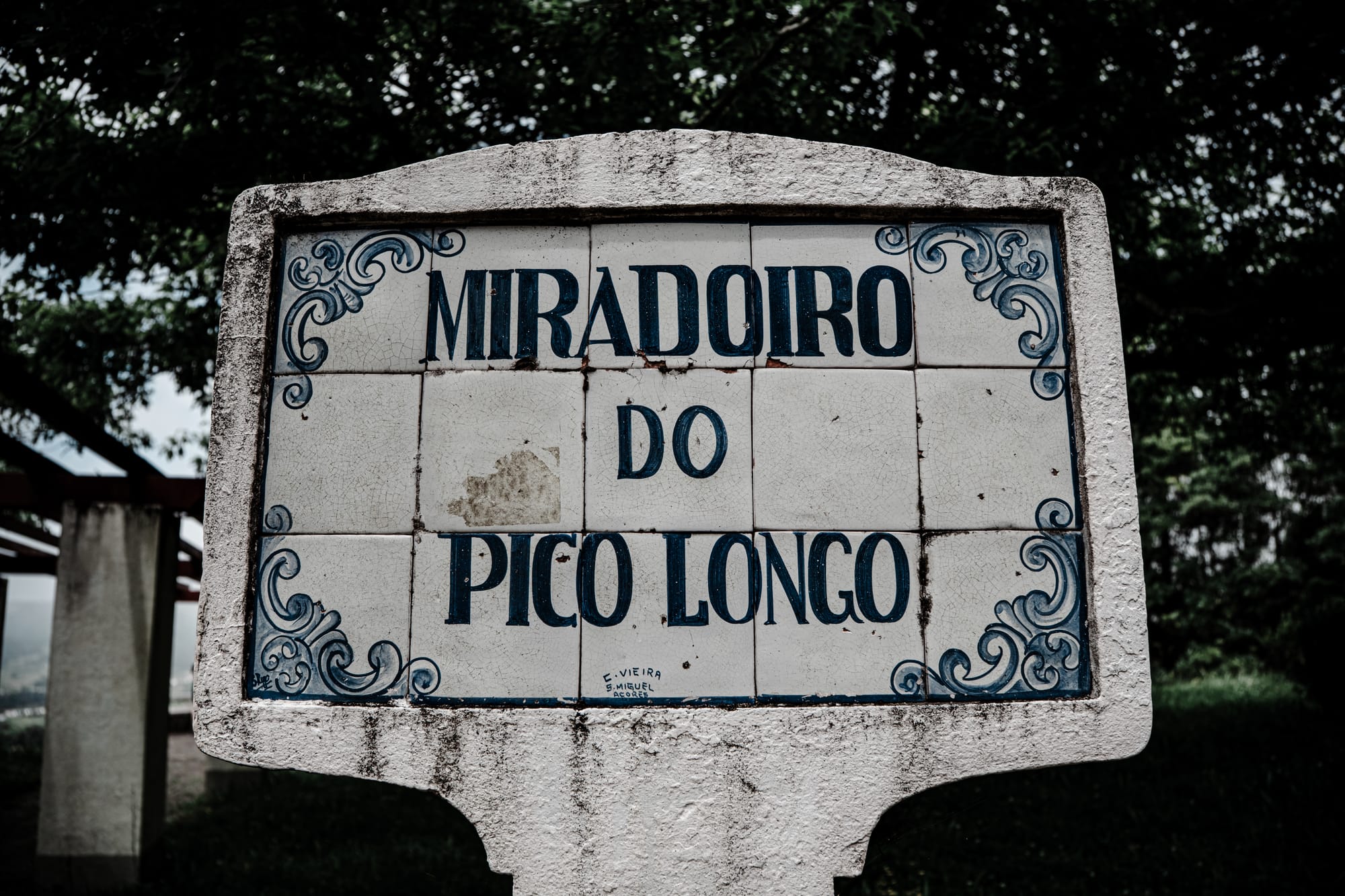
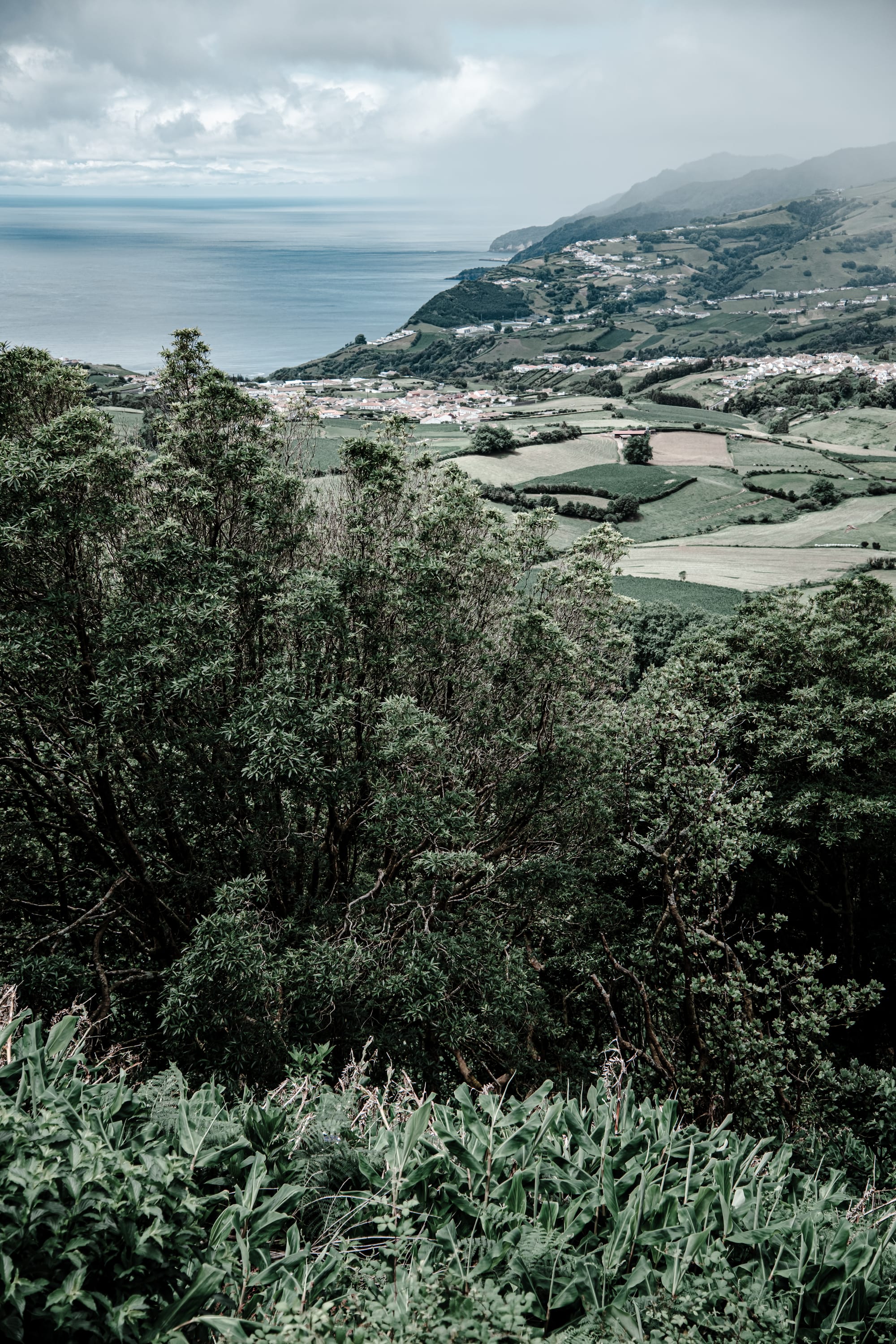
Cloud-veiled expanse from Miradouro do Pico Longo, with a name etched in azulejo tile
It’s the kind of place you find by accident, then remember vividly.
A matter of perspective
To spend time in São Miguel is to be in constant negotiation with perspective. The miradouros offer that shift—wide, patient, unexpected. Some are signposted, others appear like interruptions: a bend in the road, a break in the trees, a bench angled just so. Together they form a kind of moving architecture around the island, offering small moments of stillness in a place shaped by motion—by volcanic heat, by weather patterns, by sea.
There are so many miradouros across São Miguel, and each one offers a different kind of insight—not just visual, but emotional, atmospheric, temporal. You could spend days hopping from one to the next, or simply let them find you along the way.






